Hello!!
I am very pleased to be here with you [Flight-Report’s English readers] for the first time.
Welcome to my earliest attempt to publish an aviation chronicle under Shakespearean tones. Mind you, coming from remote regions and lacking linguistic skills, there is not the sightliest chance my prose could be matching his. I, therefore, beg for your forgiveness. Do excuse my grammar. And the clumsiness encompassing a maiden account.
This report has previously appeared in the French version of this site (can be accessed here), where all my contributions are duly displayed. They total the grand number of FIVE!! (enough, I would like to believe, to place me in the ‘unseasoned’ category among FR contributors, above the rookie -or newbie- ones).
Our -modest- story depicts the last leg of a set of flights undertaken to compensate for all those missed flights and cancellations experienced during the early stages of the pandemic (and to take advantage of a juicy, almost irresistible offer of JAL’s FOP points).
Modest, because today’s route is a short one, flown during the rainy season and in economy class. A cocktail that anticipates tedium or, at the very least, a superlative banality. The spicy touches came almost as a surprise in the shape of: 1. an unexpected air company (not well documented here), 2. the aircraft (unusual in our latitudes) and 3. a small bonus portraying remote but captivating regions of Japan, a country we have been calling home for several years.
Let’s get started
Our voyage begins in the lobby of a peculiar hotel, serviced by dinosaurs. Facing velociraptors and tyrannosaurus, a couple of screens portray the status of flights and the assigned check-in counter or boarding gate, as if we were already at the airport.
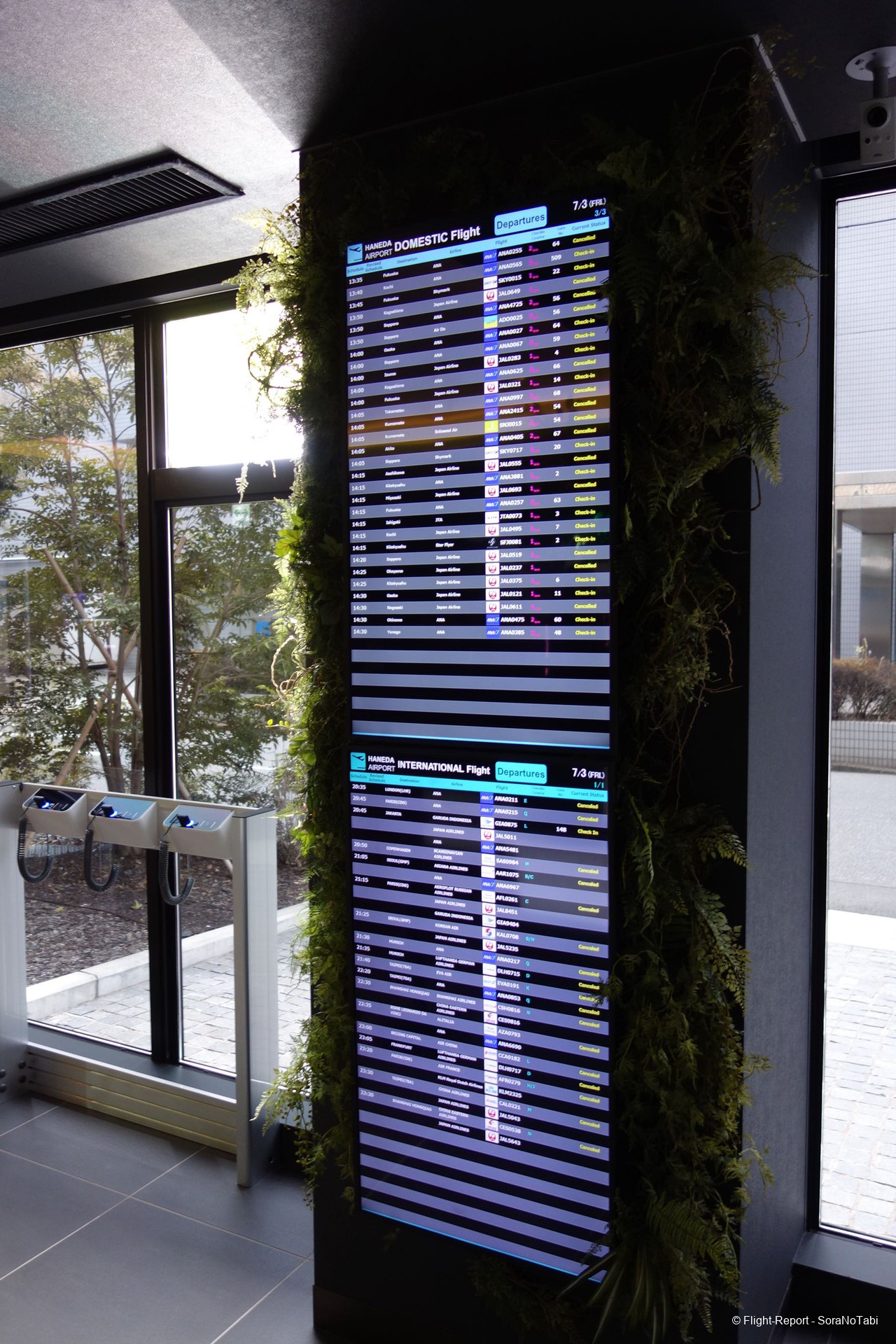
A free shuttle service is available connecting, once an hour, the hotel with all three terminals of Haneda Airport. The service is interrupted during the afternoon (noon - 5pm). Display of information follow Japanese manners, in which new announcements, notices or changes are pasted, -in laminated pieces, naturally!-, erased or half-way removed to keep up with updates, generating a brouhaha of information difficult to digest for the unaccustomed eyes.
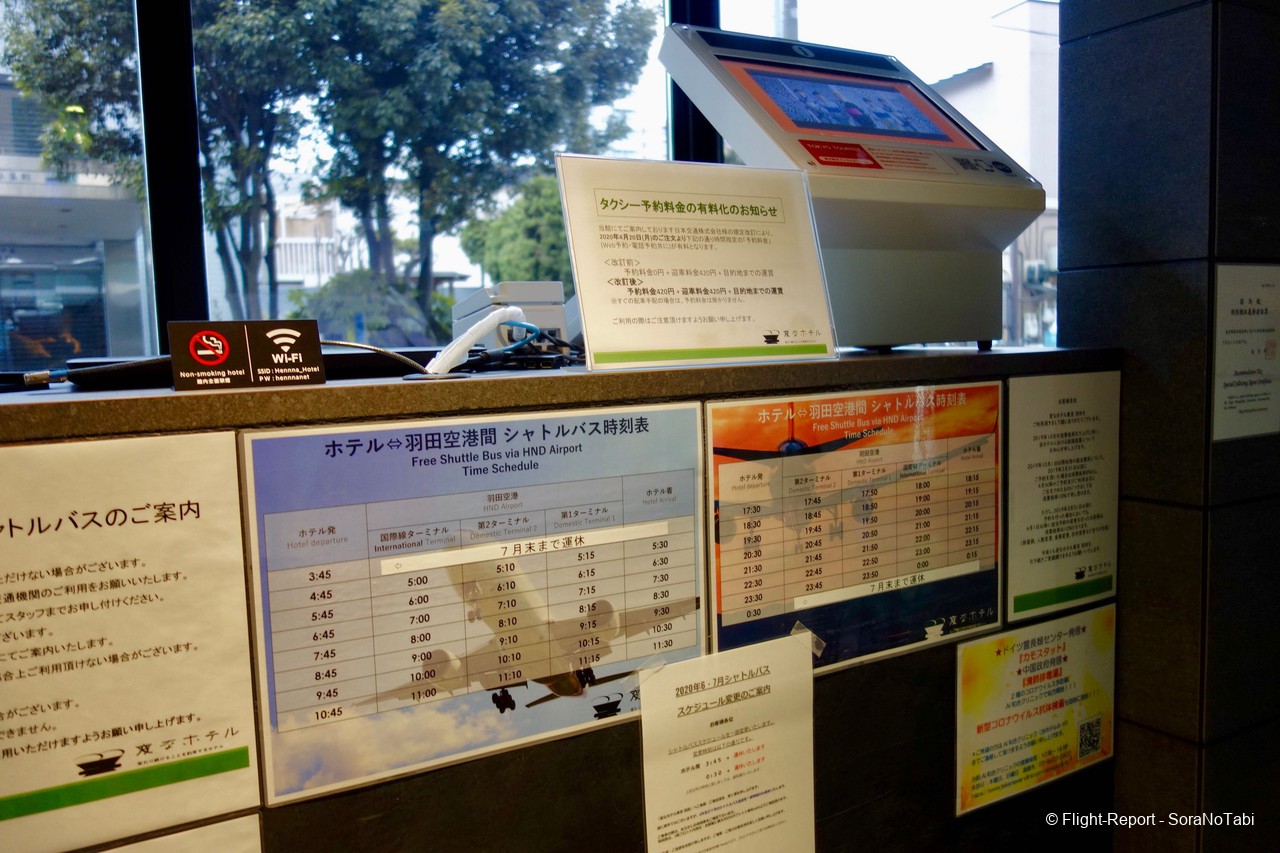
Exiting the doors of our hotel, we stumbled upon a small and lovely yellow bus, greeting us good morning at scheduled-departure-time minus 3 min. Nobody to be found; anywhere. Hmm… Fortunately a human being appeared in extremis and brought us calmly and safely to the airport grounds. Given the automated nature of the hotel, at one point I just believed the shuttle was going to be remotely controlled… Ouff!! (by principle I have nothing against new technologies, but….)

The JAL ‘pavilion’ (Terminal 1) being the last stop in the route, we were offered a short tour of the premises. A delightful parade for tarmacs or mechanical ornithology lovers. Less fun for the rest of the world.

Hereby I present you with a rare species: eye-masked American bird -autochthonous to West Europe- boasting a slender but robust body and capable of great efforts during long spans of time. It is likely to procreate in the future and permeate our skies, if the virus does not upset the equation sustaining the aeronautical environment.

At home
Our playground hasn't changed since yesterday. Early afternoon is ‘off-peak’ time for JAL domestic (ticket prices clearly reflect this), but today the terminal is much quieter than usual.
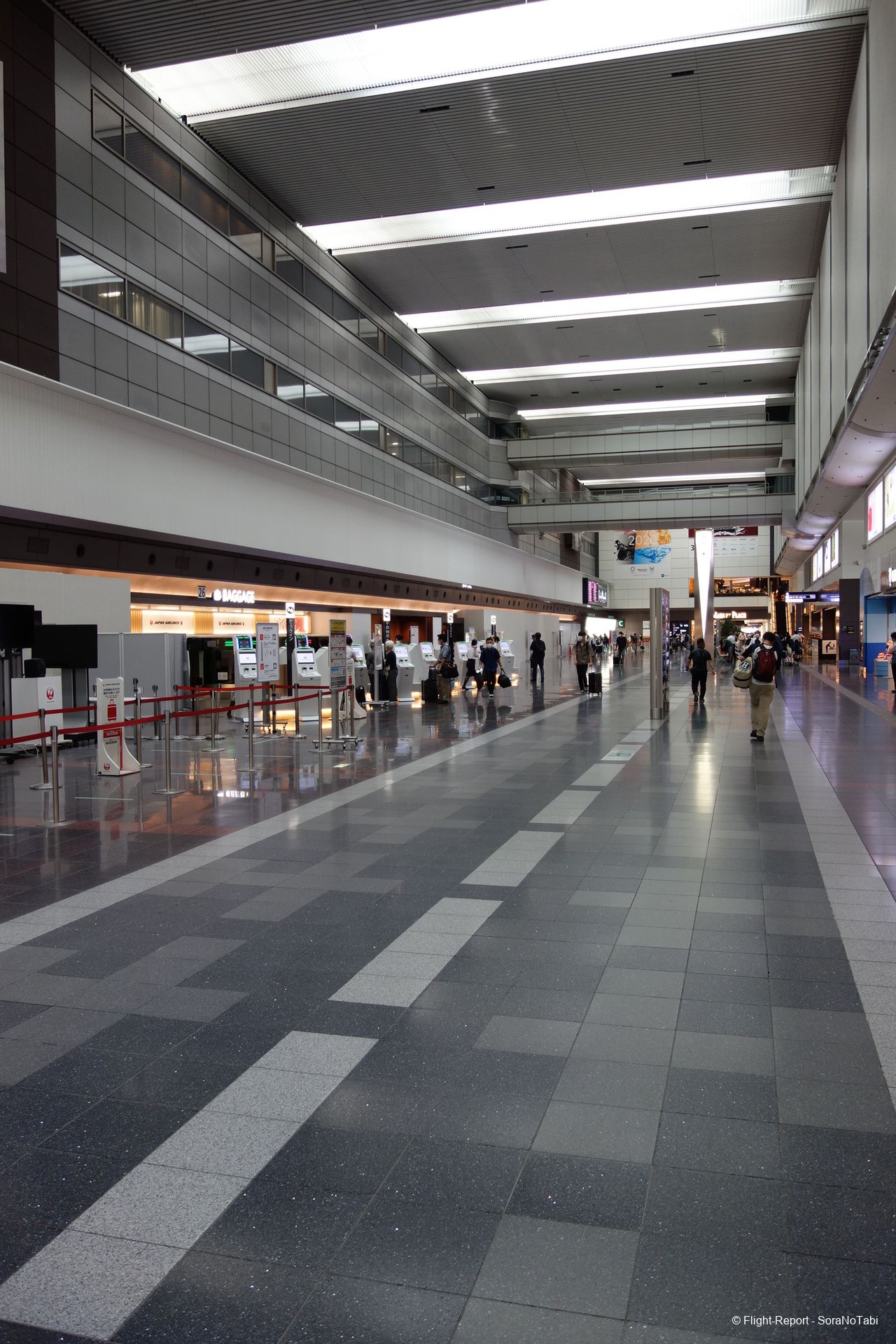
The security check is completed before we even realised we had started it. We proceed to the 'air-side' commercial area, which in ‘Domestic Haneda’ has fewer and less appealing shops than the 'land-side' one.
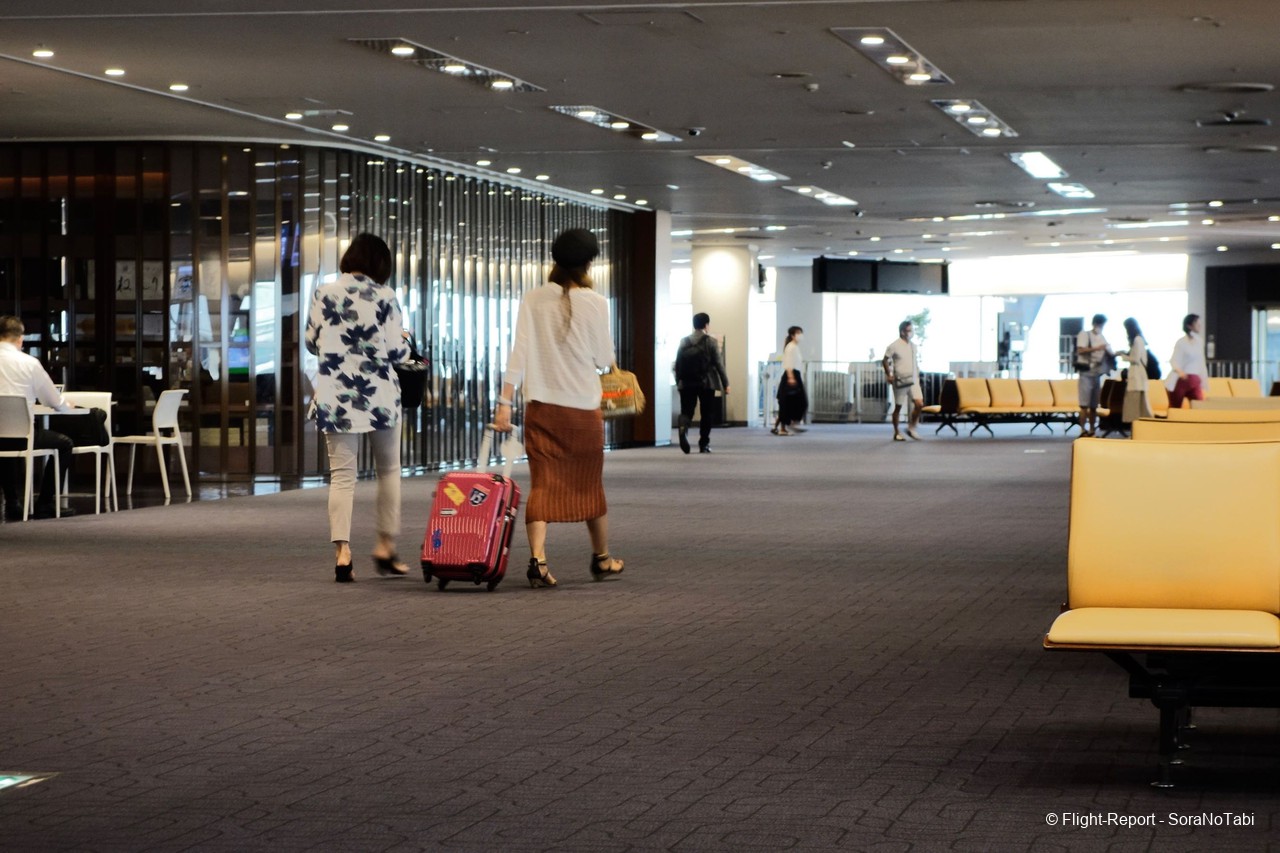
Corridors leading to the boarding gates are equally empty today. The shopfront of a chic department store with headquarters in Shinjuku (selling fine clothes and herbal teas accompanied by cakes with lengthy names) can be perceived on the left side of the image.
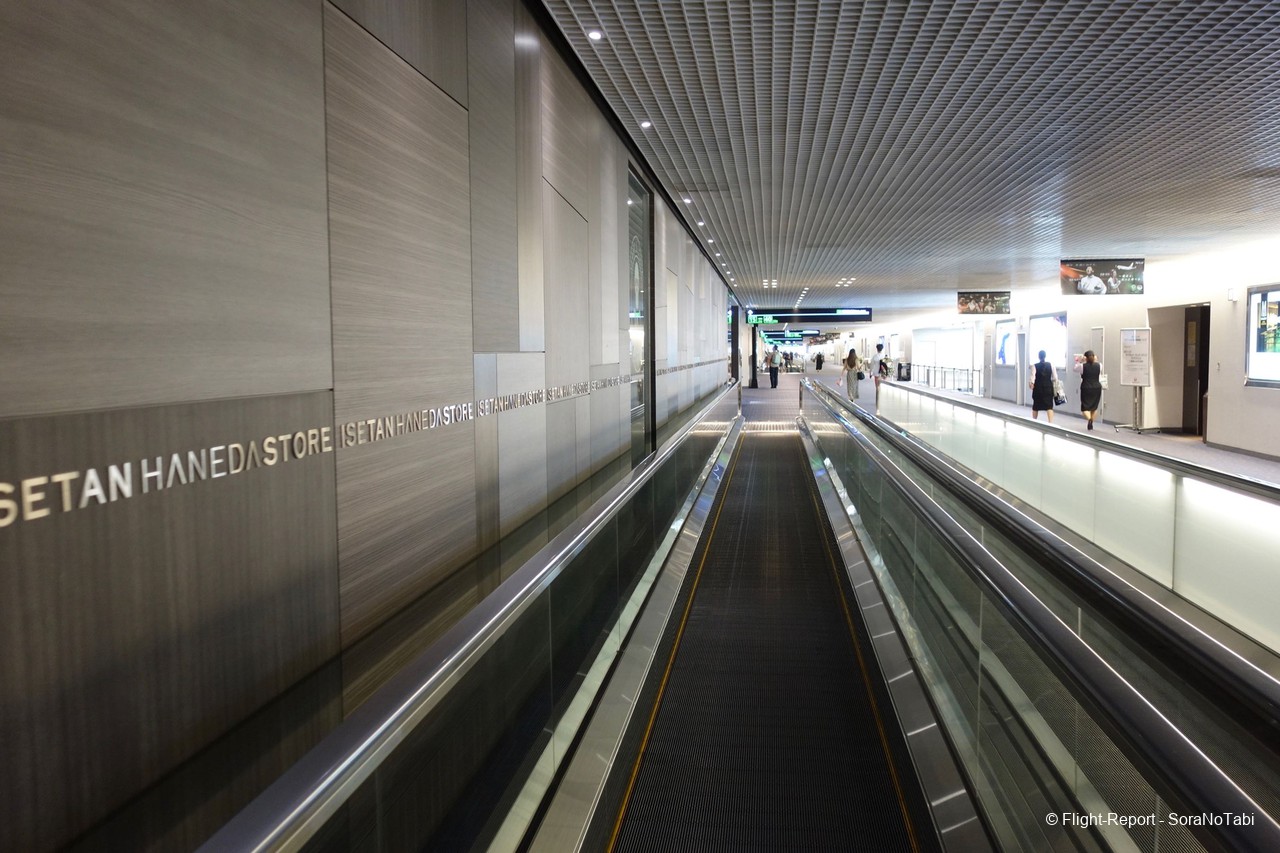
Is he a reporter on assignment for one of the many local sites dedicated to civil aviation?
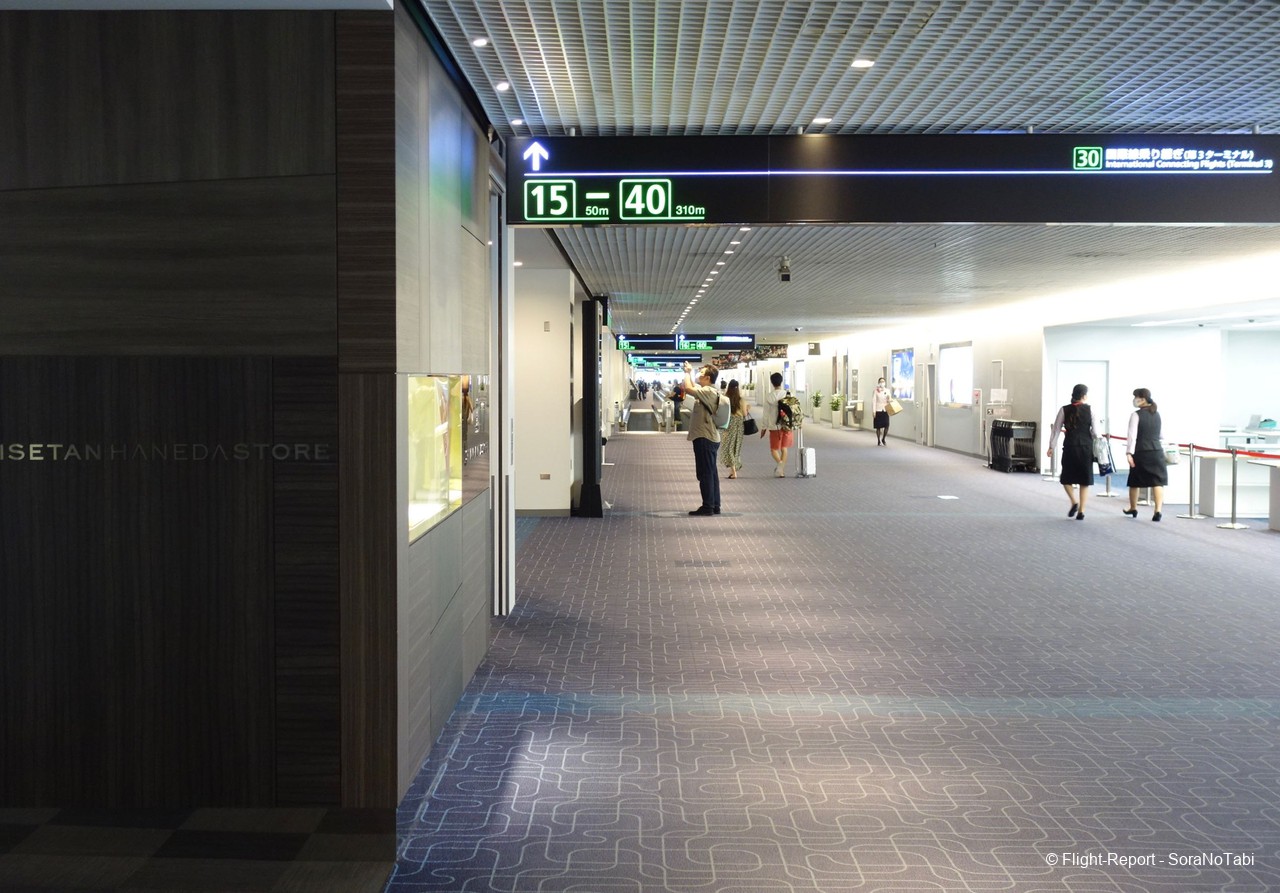
Haneda Terminal 1, christened Big Bird (ビッグ・バード)?!!?, was inaugurated in 1993 brandishing an already outdated architecture (to give some perspective, Mr. Paul Andreu Inc. designed CDG's Terminal 2A & 2B in the early 1980s, so did Sir Norman Foster Inc. in Chep Lak Kok Island by mid-1990s). Despite its conceptual obsolescence Haneda T1 works remarkably well after 30 years. And much of the building areas (including most of the lounges, gates and shops) offer, surprisingly, interesting views over the tarmac. Quite surely, such concession to limpidity (in an otherwise gloomy environment) must have been a consideration to locals’ demands. Japanese customers have been really keen to document (and enjoy) the waltz of luggages, birds & vans since the standardization of photographic equipment in the early 60’s .
A café accessible to all sort of passengers, as an illustration of the aforementioned openness. (And closed due to the pandemic, which kind of contradicts my statement on transparency …)

This means we'll have to give up the idea of enjoying a good coffee… But I really want to sit somewhere, unwind and enjoy the outside scenery before boarding our plane. We activate, then, our B plan: appeal to the generosity of our banker to gain access to calm spaces, offering good juices and unobstructed views of the runways (but a terrible coffee).
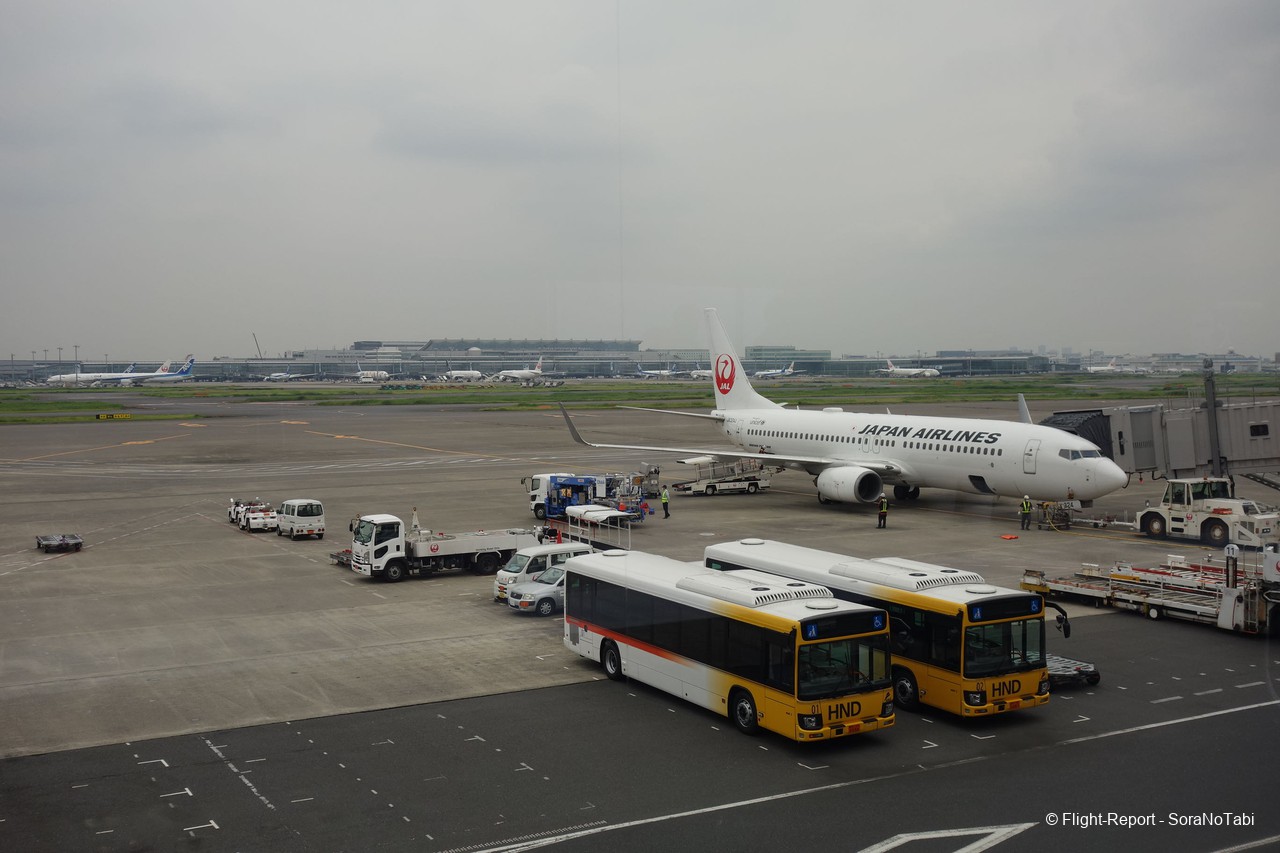
Health-prevention measures brought these cardboard cups to the lounge tables. In days of yore, they were only provided when taking your drinks away.
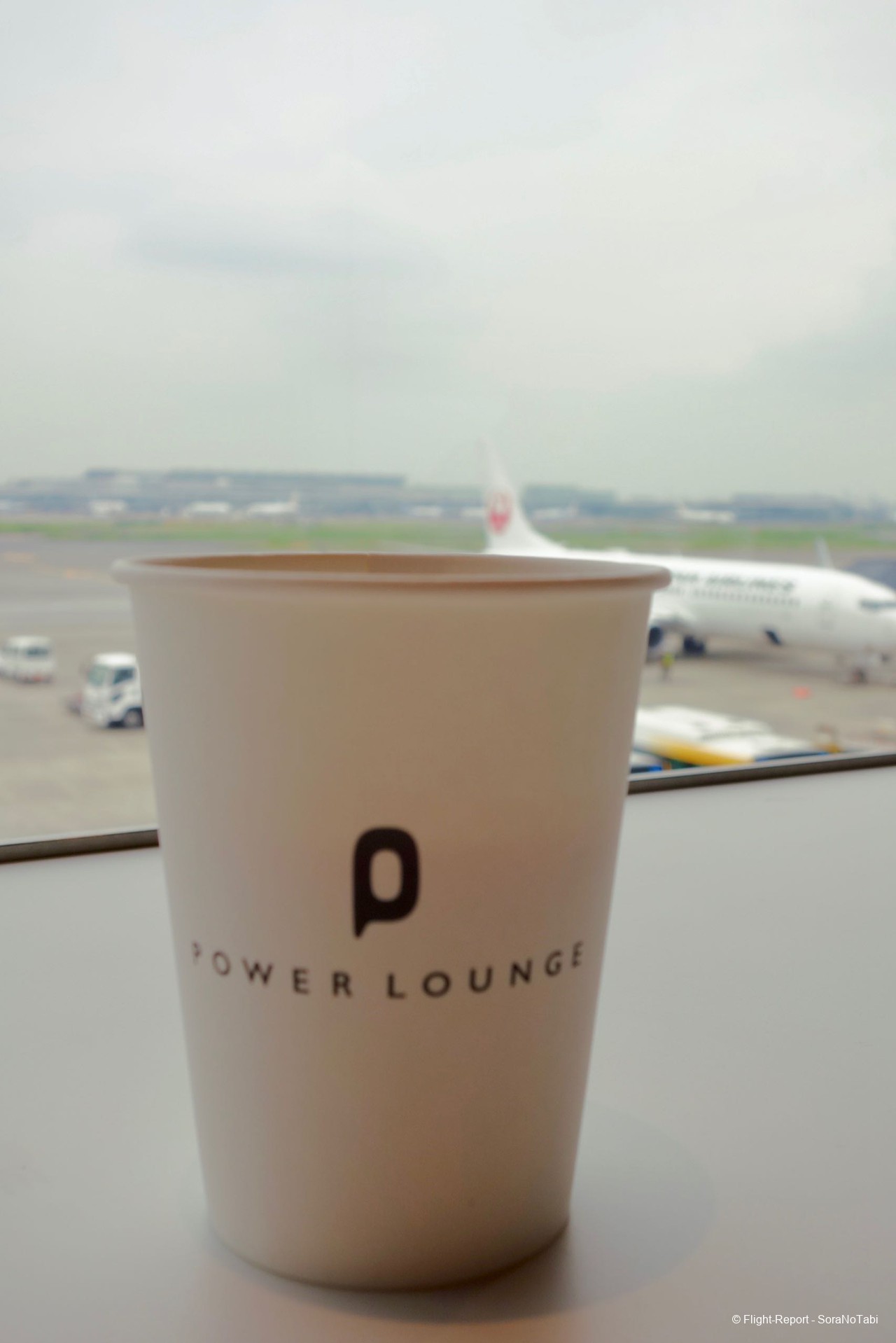
For lounge use, washable tableware was the thing to go for. Glass is, indeed, so much more engaging, gentle to the touch (and instagrammable!). Definitely more graceful -and climate friendly- than their paper counterparts.

We are, indisputably, at home here; no enemies in sight…. will those hardworking skippers be able to unfold their sails for real, even with a delay of one full year?
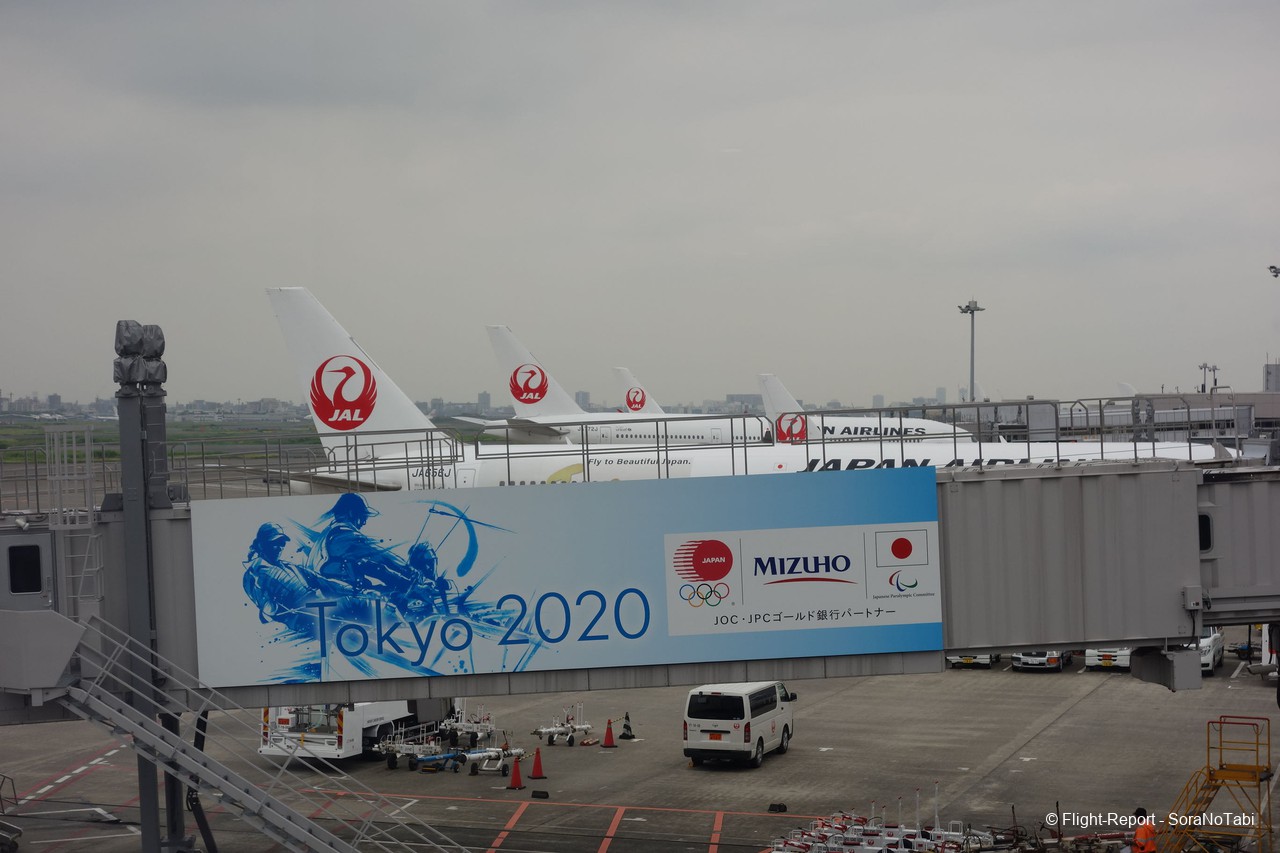
After some refreshening moments we head towards our gate (in the southern section of the terminal, as it is customary).
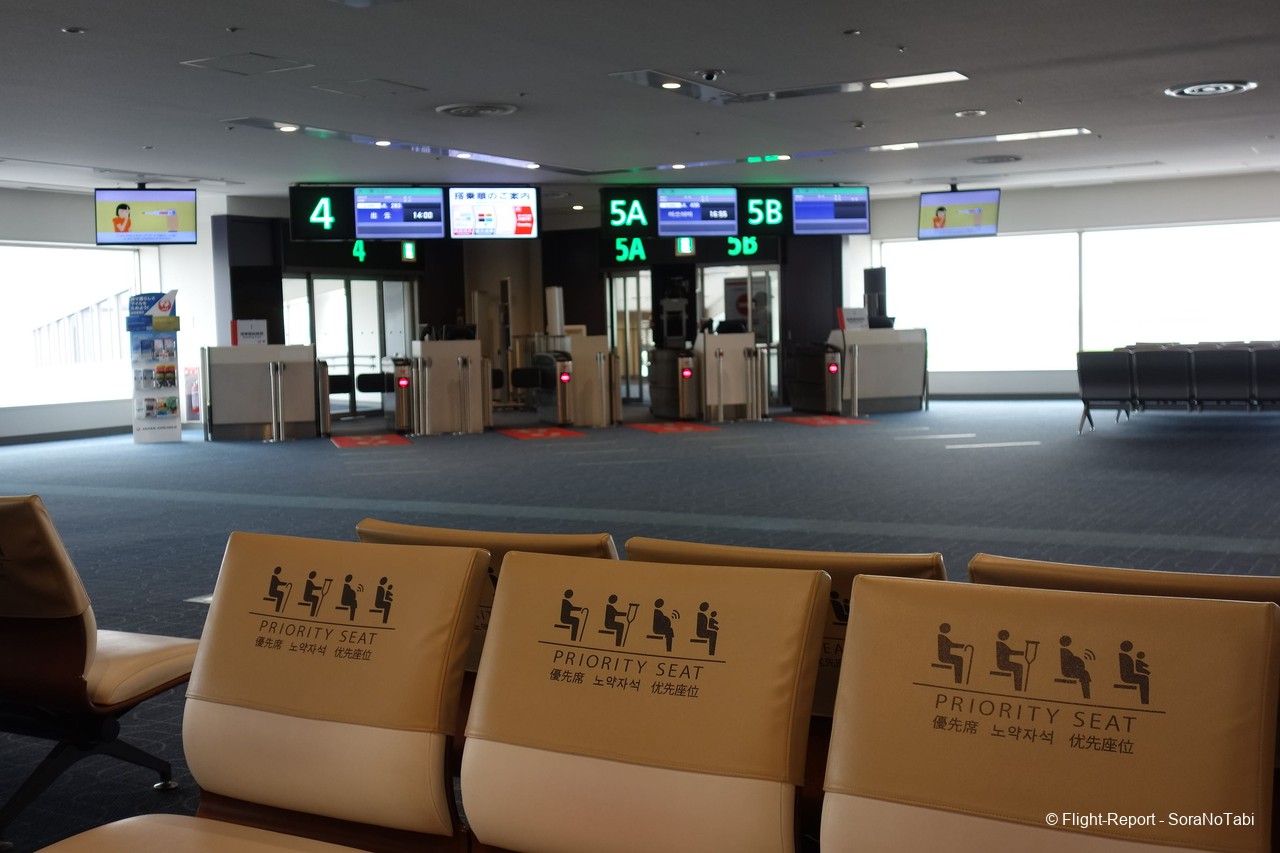
More often than not, an unfamiliar culture is perceived through simplistic lenses. But the attachment to work of the Japanese goes beyond the stereotype and flirts with reality. Here, boarding proceedings for Izumo -a remarkable shrine- or Matsuyama -our destination- are already going on, two hours, or even FIVE hours! before take-off!!!!
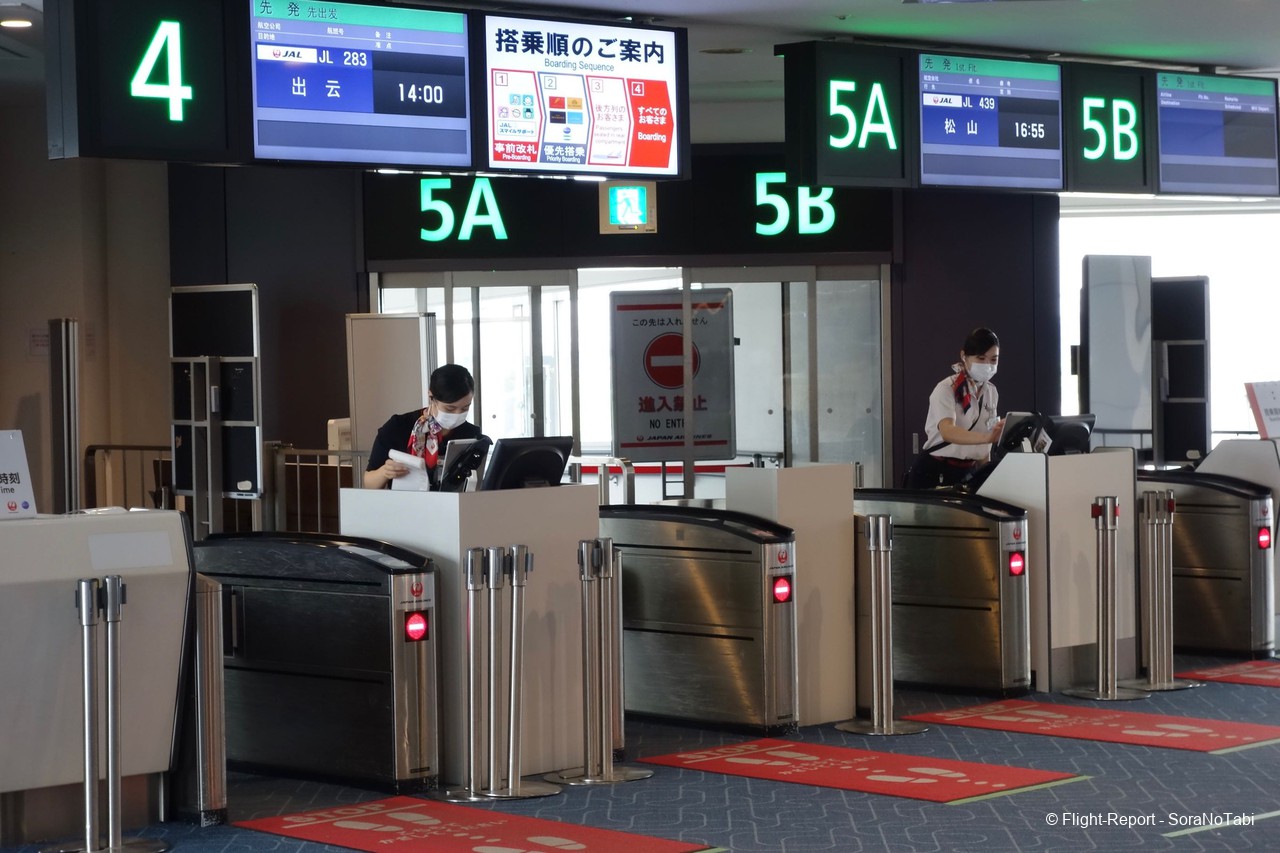
It's 9 minutes before take-off and boarding just started!?! An on-time departure under such circumstances seems unconceivable. Right? It's true that some alleviating factors need to be considered: today’s aircraft is small (single-aisle) and a delay of 5 minutes has been duly announced. But what might look like as an insurmountable task elsewhere, is feasible in Japan. I truly believe we can make it to the skies on-time… Passenger’s flow management here is elevated to something close to an art form.
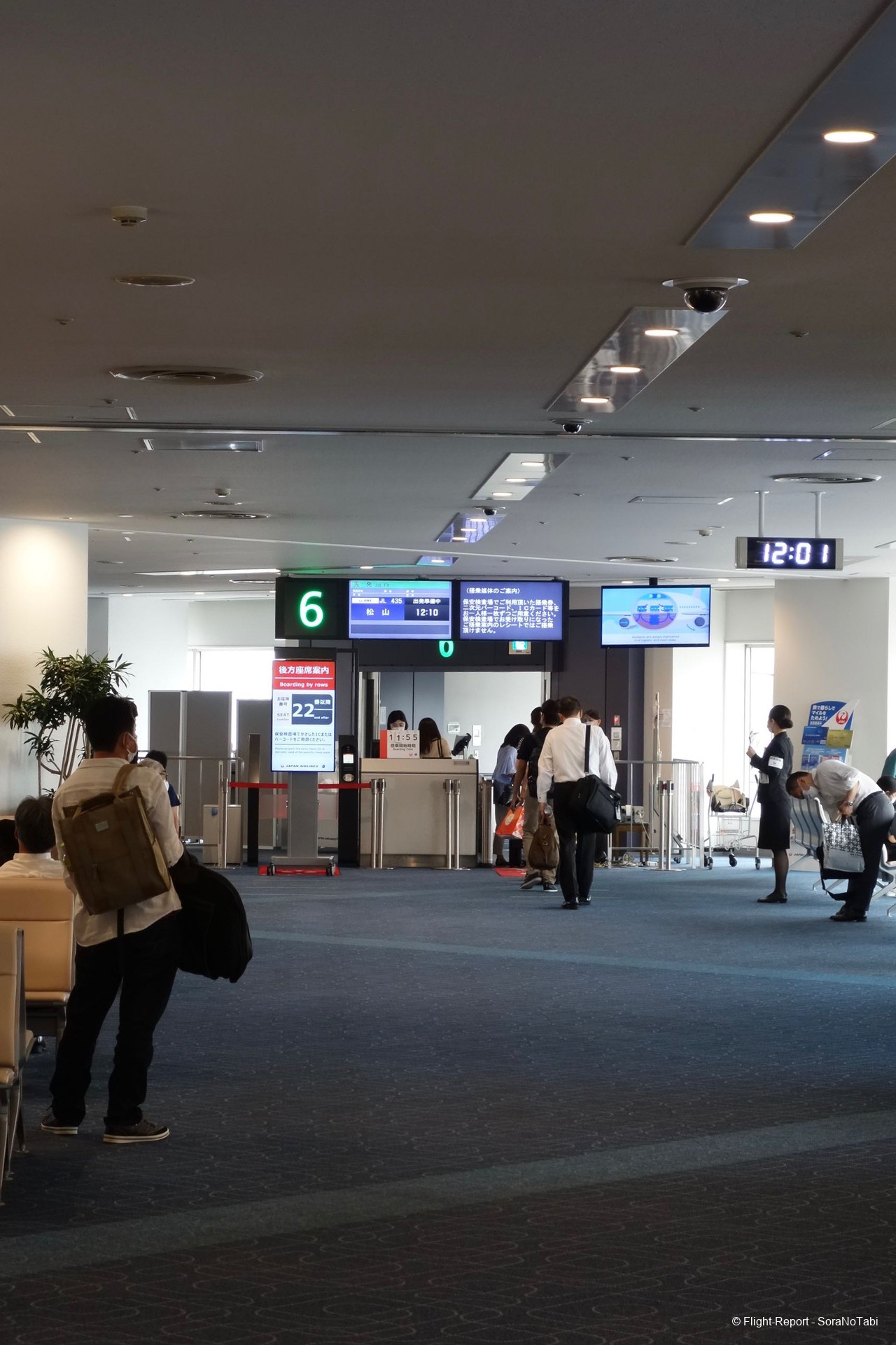
サプライズ
I introduce you todays’ bird. Oh! Uh! Small surprise! It is even smaller than expected! Usually the HND-MYJ route is operated by JAL on its B-737’s. Quite surely, pandemic-related disruptions are responsible for this last-minute swap (of company and of aircraft). Our bird will be a J-AIR one, then. The company operates under JAL codes and is 100% owned by JAL. Thus, it is a bit of a headache to tell the difference between them (you will only find any when considering air-fleet or flown routes). Perhaps J-AIR could be described as the regional branch of JAL, serving minor destinations from Osaka (ITM, its base), Fukuoka (FUK) and Sapporo (CTS) airports.
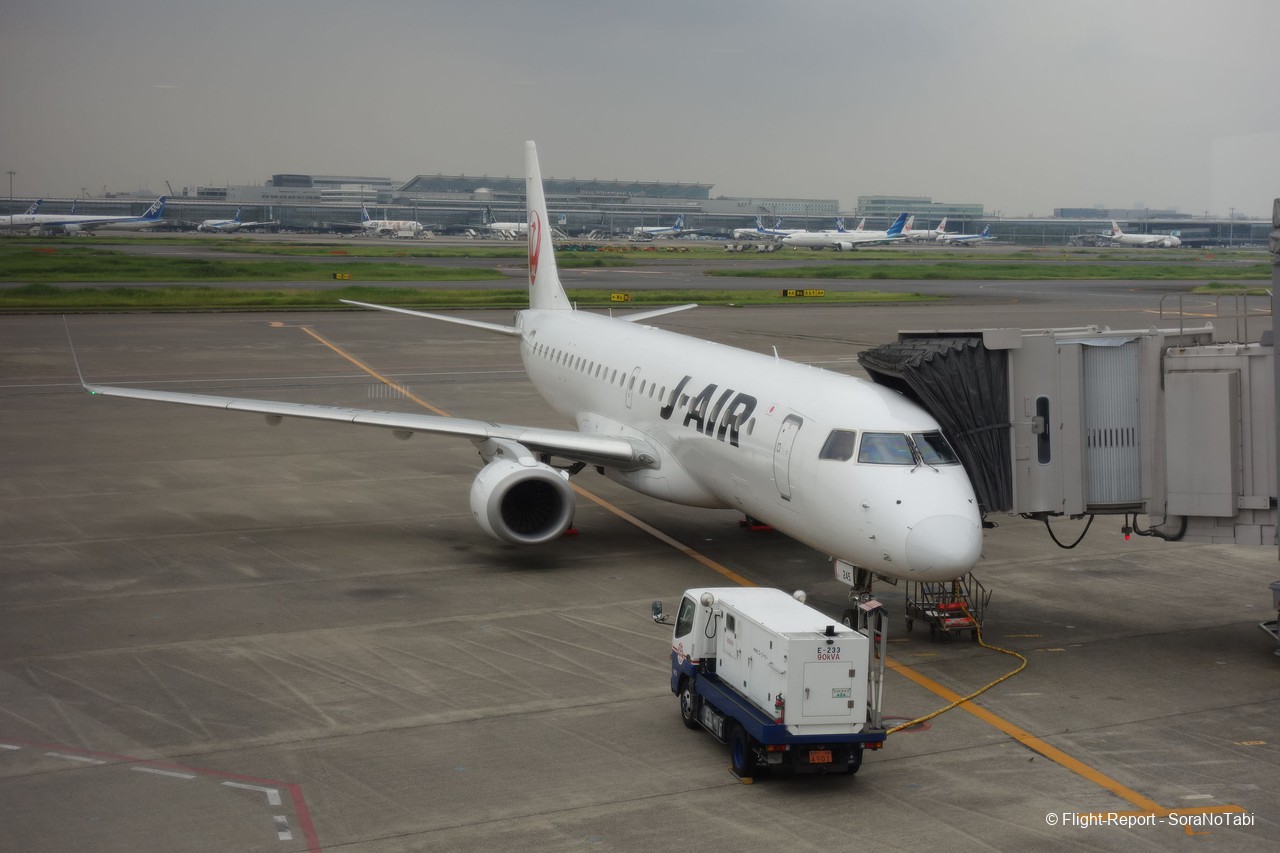
Our jetliner had just celebrated his second anniversary by the time we met.
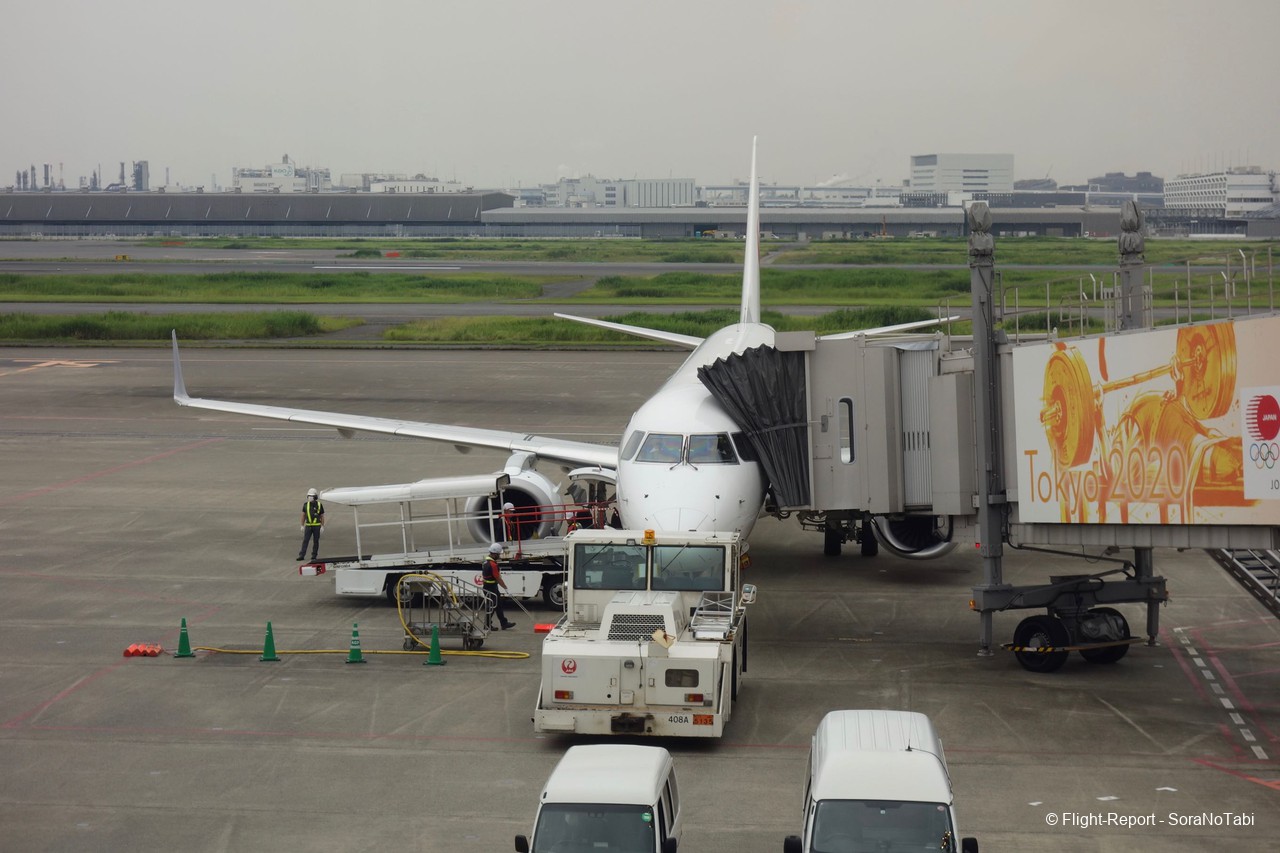
In here, the jet bridge leading to our plane (this time without CM -shiieme or advertisment, in local slang-)
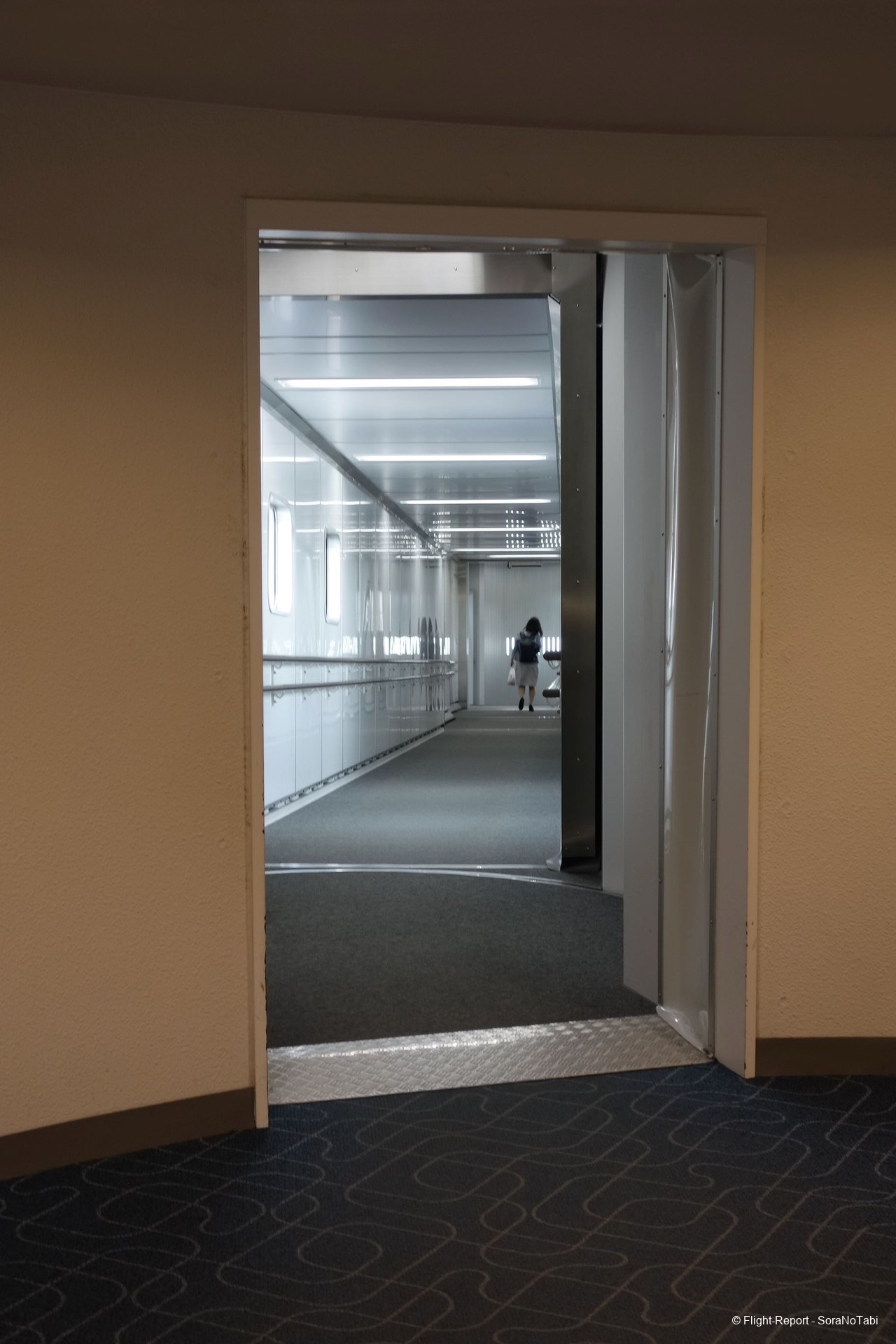
A really awkward picture showing the control console of the walkway.
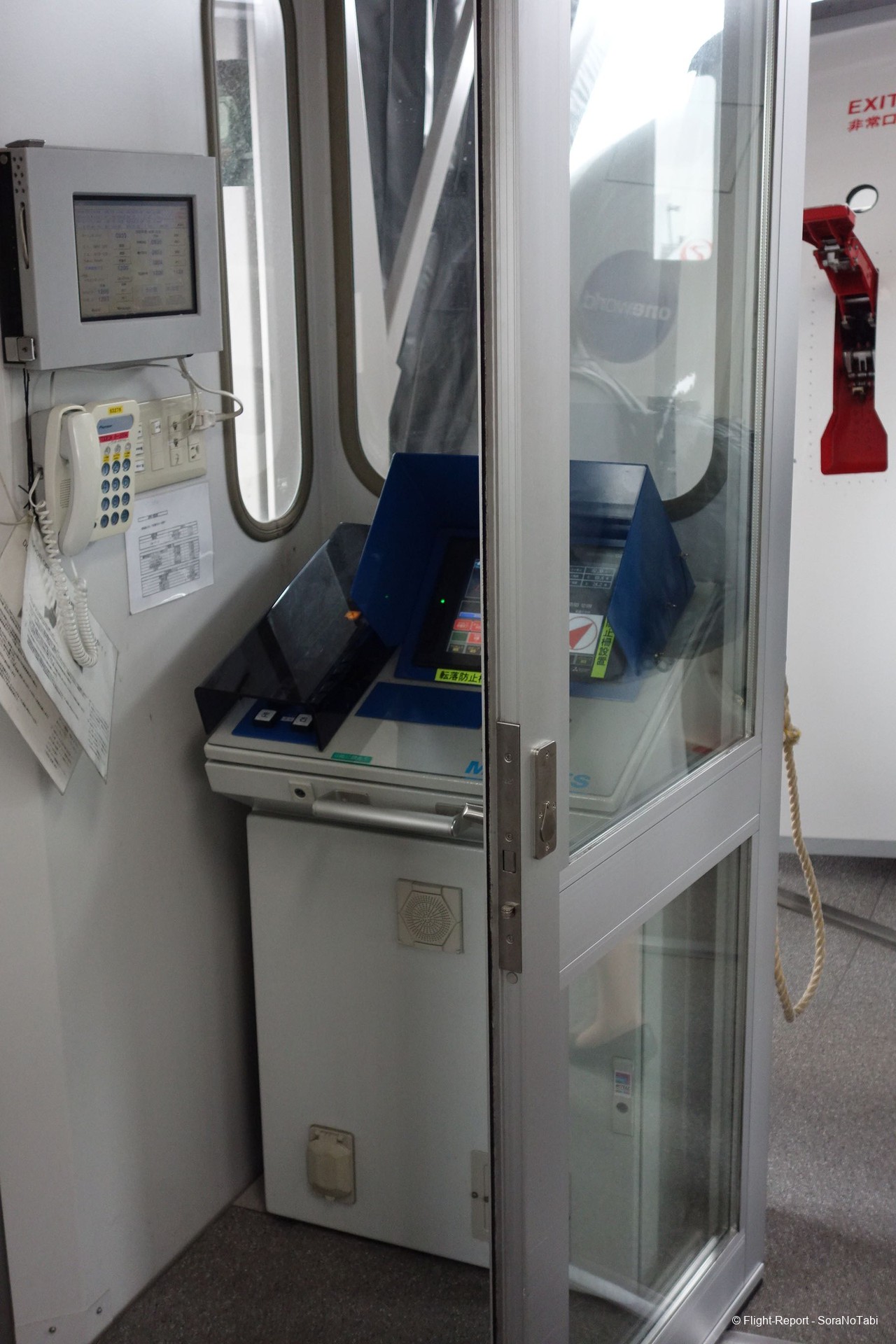
And the opposite view. Our airliner is being unsettlingly duplicated on the mirror. Is this some sort of trick, out of the top hat of an illusionist?
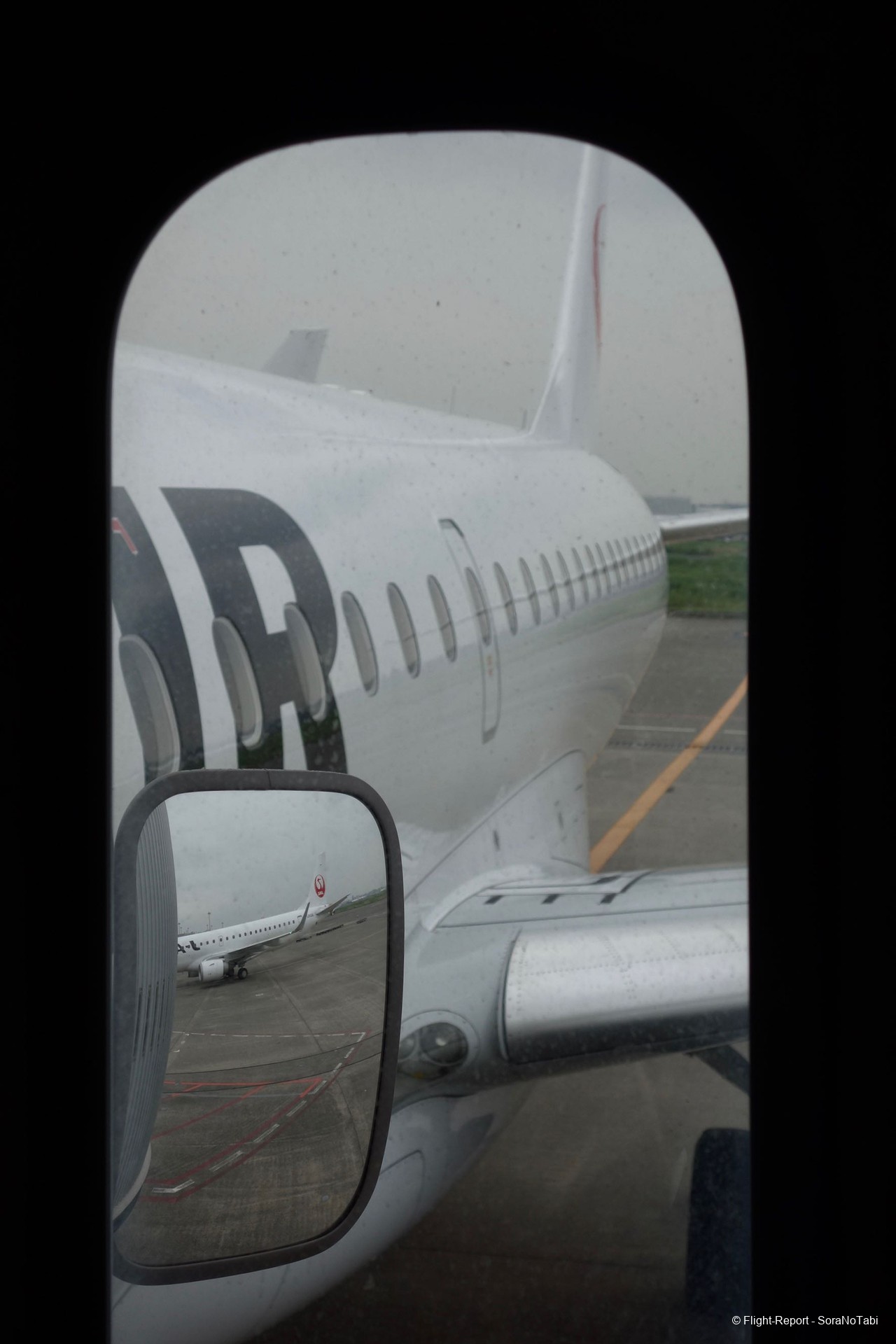
Kunimo-san* II stands in the hallway, just before welcoming us aboard.
*(long story made short, this is a very personal way of referring to solicitous and professional cabin attendants).
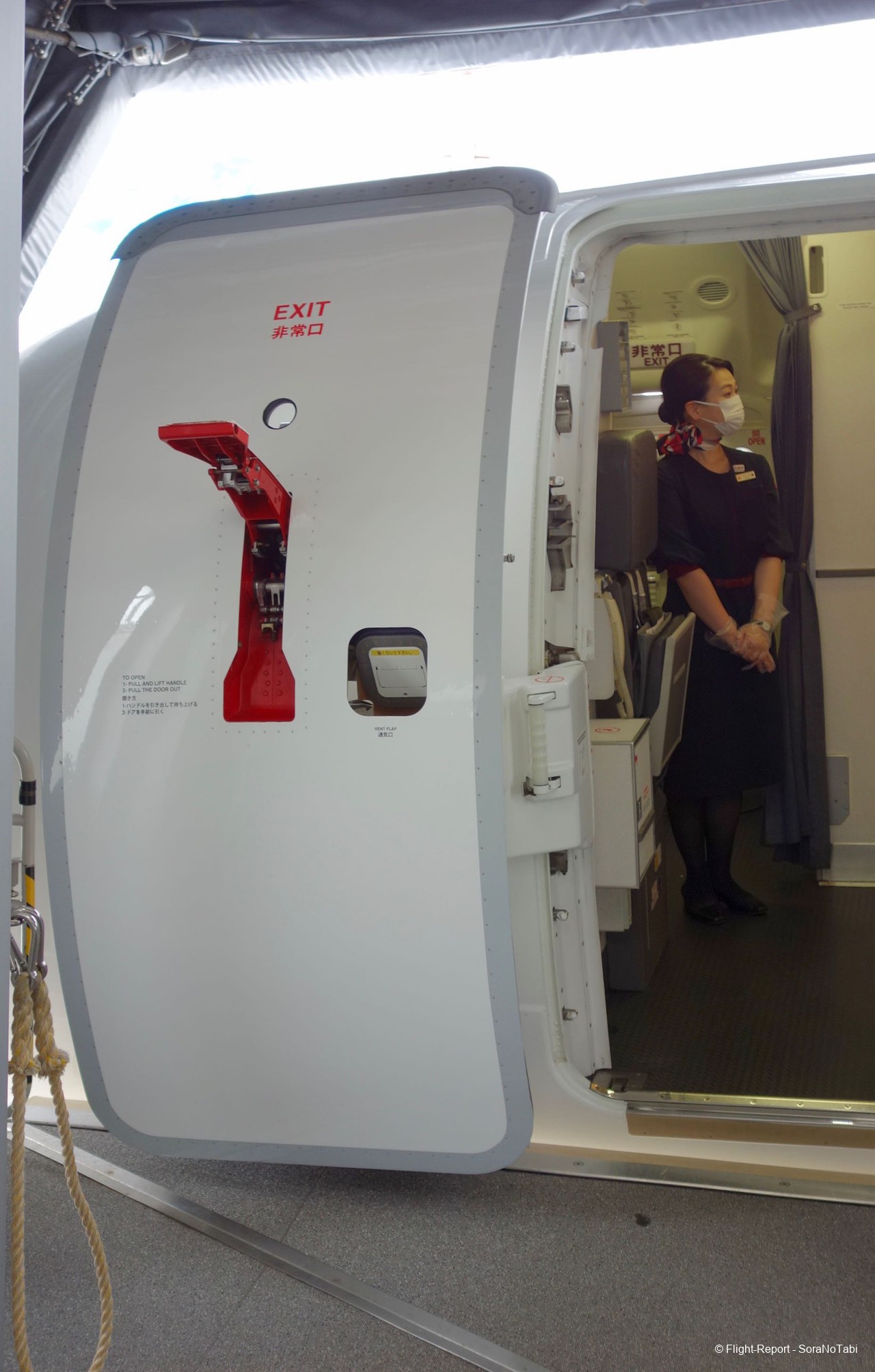
Usually, I like to board among the last passengers. Today, latecomers more concerned with their personal affairs than the common welfare make it difficult to accomplish the task.

These will be my living quarters for the next 100 minutes. Without doubt, this is the best seat in this cabin (especially on this flight, where the seat next to me will remain vacant). Obviously, my judgement is debatable… and I will be defending my case intermittently, throughout the subsequent paragraphs.

Kunimo-san II is about to close the door.
The J-Class in this aircraft comprises 15 seats (5 rows in a 1-2 formation).

The tractor pushes our vessel towards the taxiways.

The main reason for awarding a ‘Best Seat of J-Air’s E-190’ label to 15 A has to do with its (incredible) pitch. I'm not the shortest person in the world and with my legs extended I couldn't reach the back of the seat in front of me. And, mind you, we are not seating on an emergency exit.
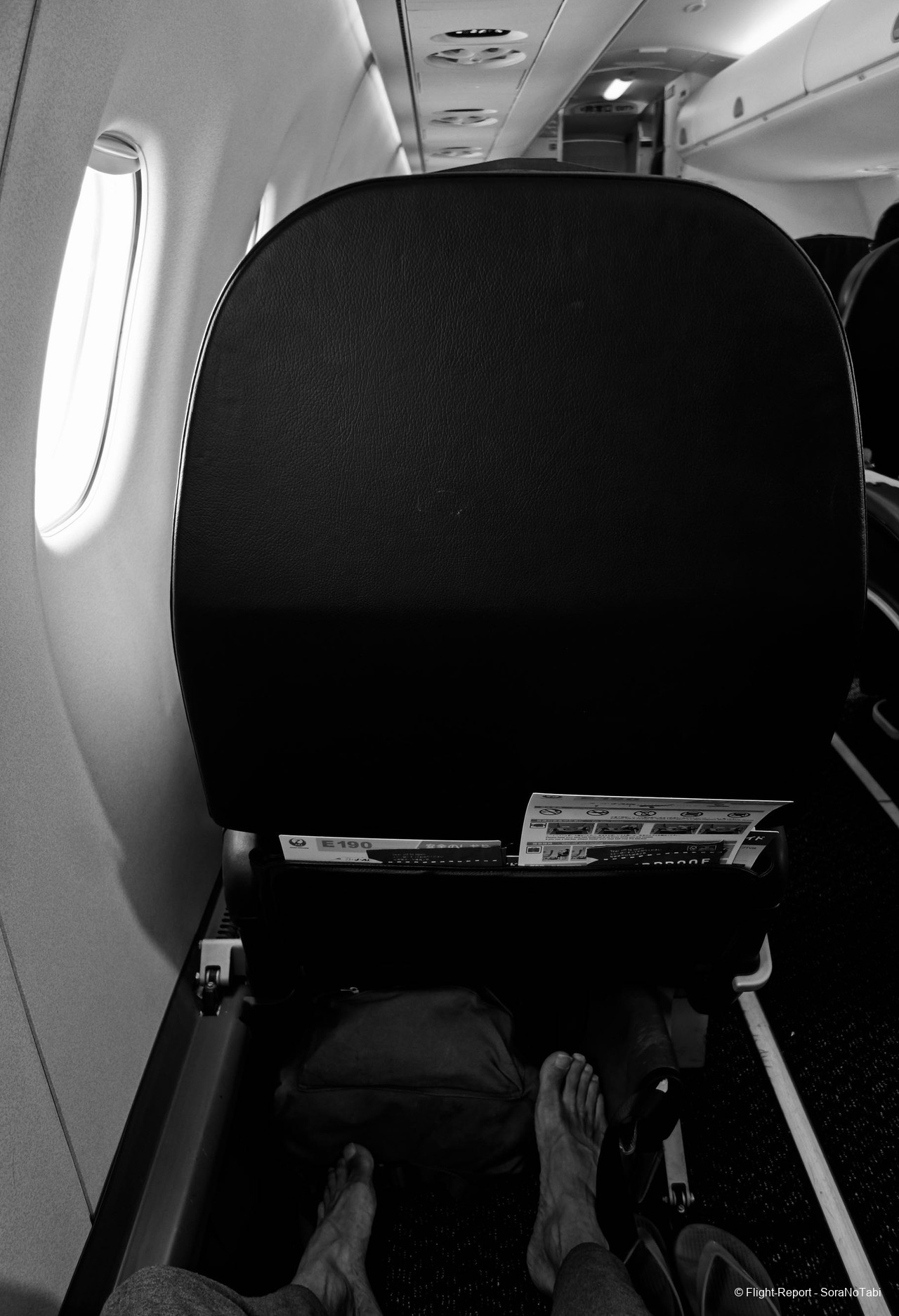
The wizard’s trick is disclosed henceforth: one of our twin sister planes was just parked next to us, revealing unpretentiously her curves and silhouette on the looking-glass. (She might perhaps be going through a rebellious phase as her two Mohawk spikes -worthy of infamous shops along King's Road or sweaty basement pits in a bygone Soho).

Kunimo-san II, who apparently does not follow the Carnaby Street fashion of the 1980s, tells us what to do in case of emergency.
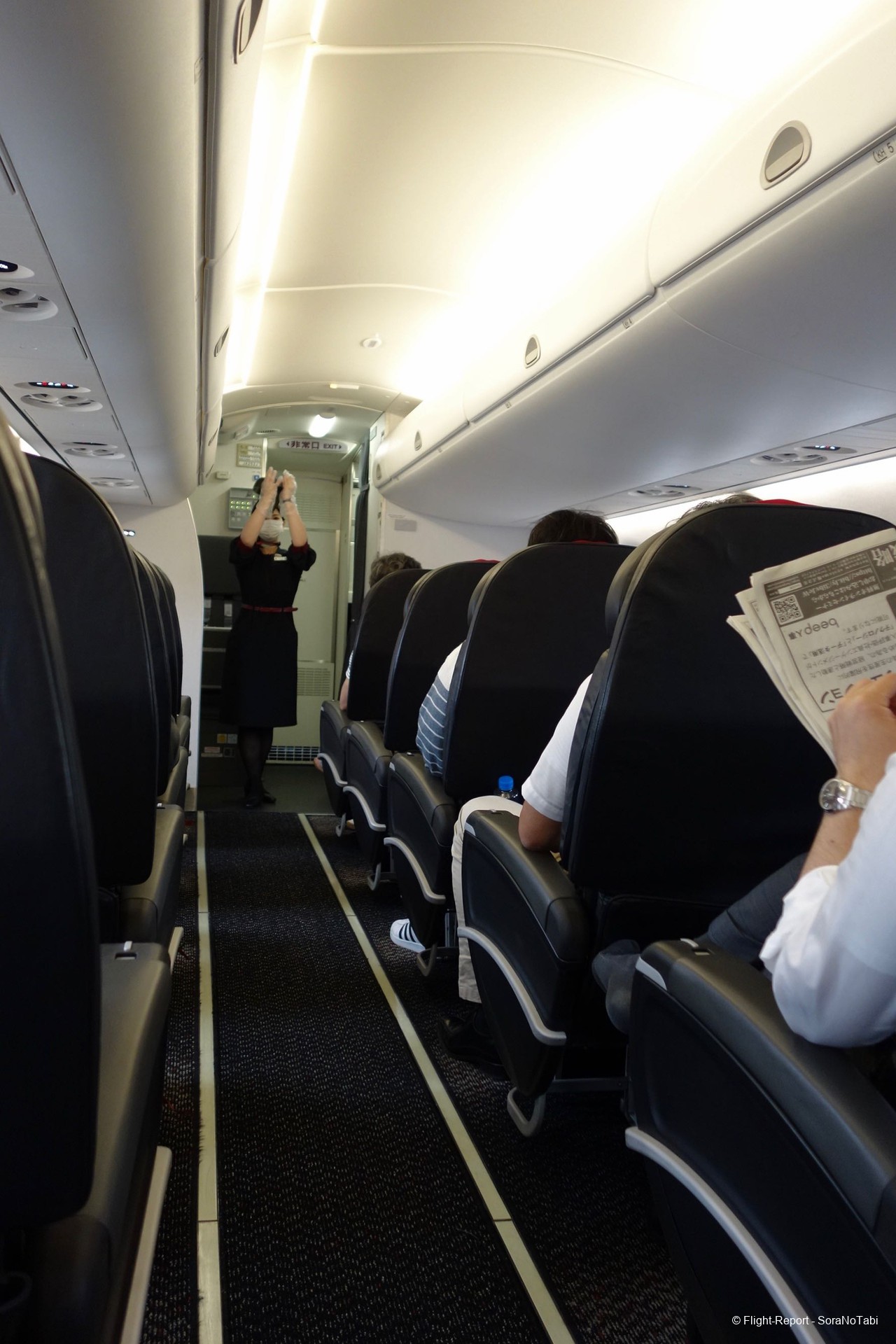
As a passenger, I prefer this old-fashioned interaction to pre-recorded messages reproduced on screens.
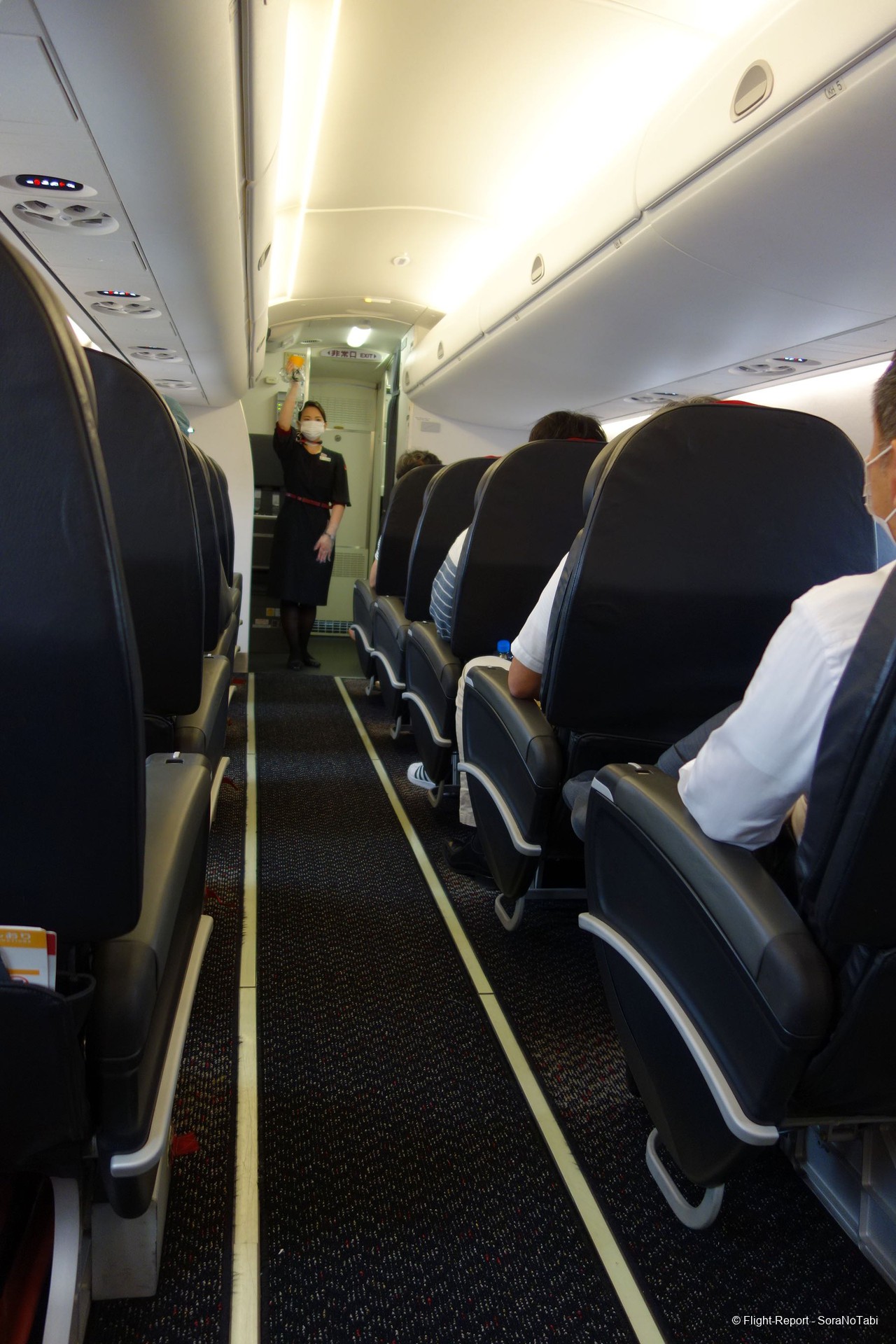
A limpid chicane adorns the cabin ceiling. Beyond its sculptural attractiveness, its shape really adds to the qualities of this seat, bringing in a pleasant feeling of spaciousness. And at foot level, it shields the window passenger from aisle traffic (this is not the case if you are sitting in the contiguous seat, which is really exposed to the elements).
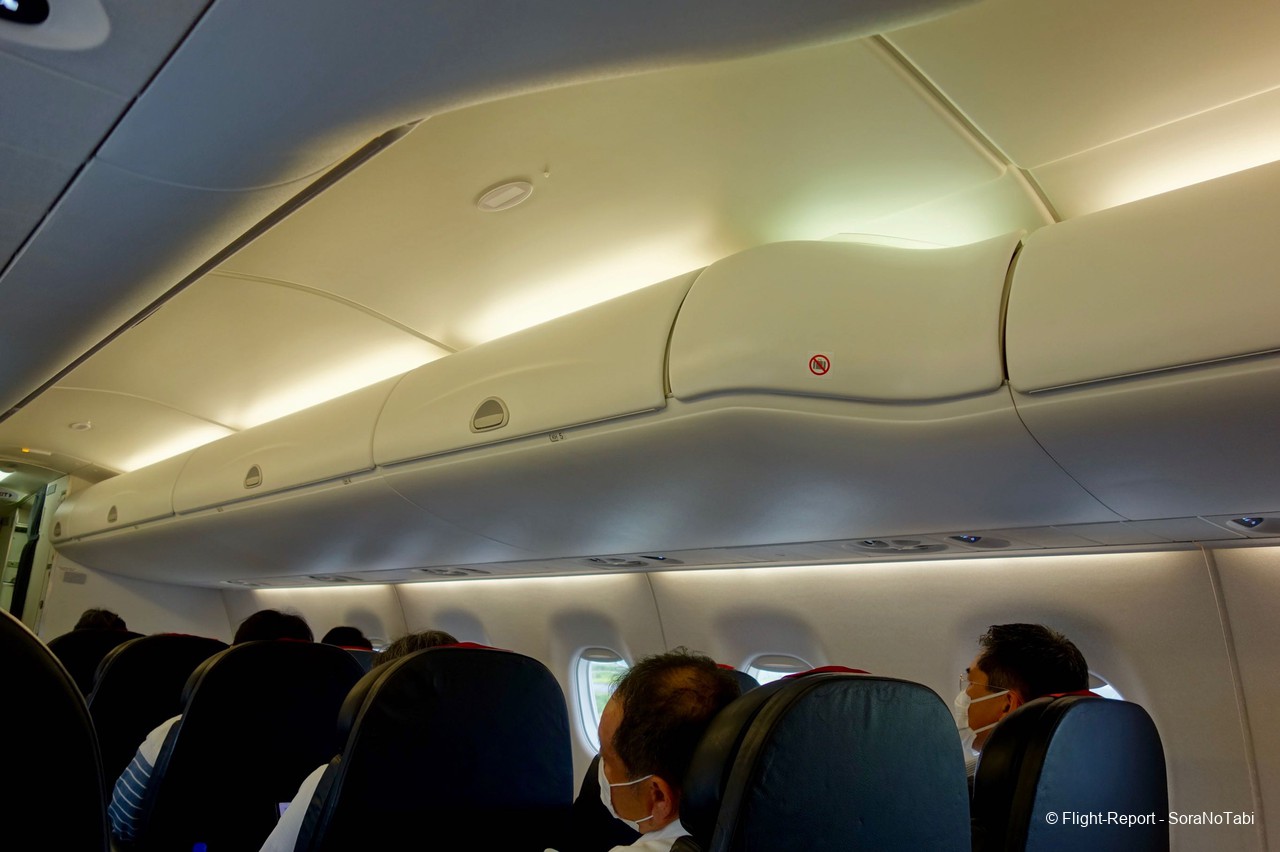
A pair of safety cards share a seat pocket. Rest assured, this is not a case of negligence from the cleaning staff (far from it! Such a miss would be almost unconceivable in these latitudes!! '-)). One seat at the front, two seats at the back. The laws of physics do not offer plenty of solutions to conjugate differently the set of cards…
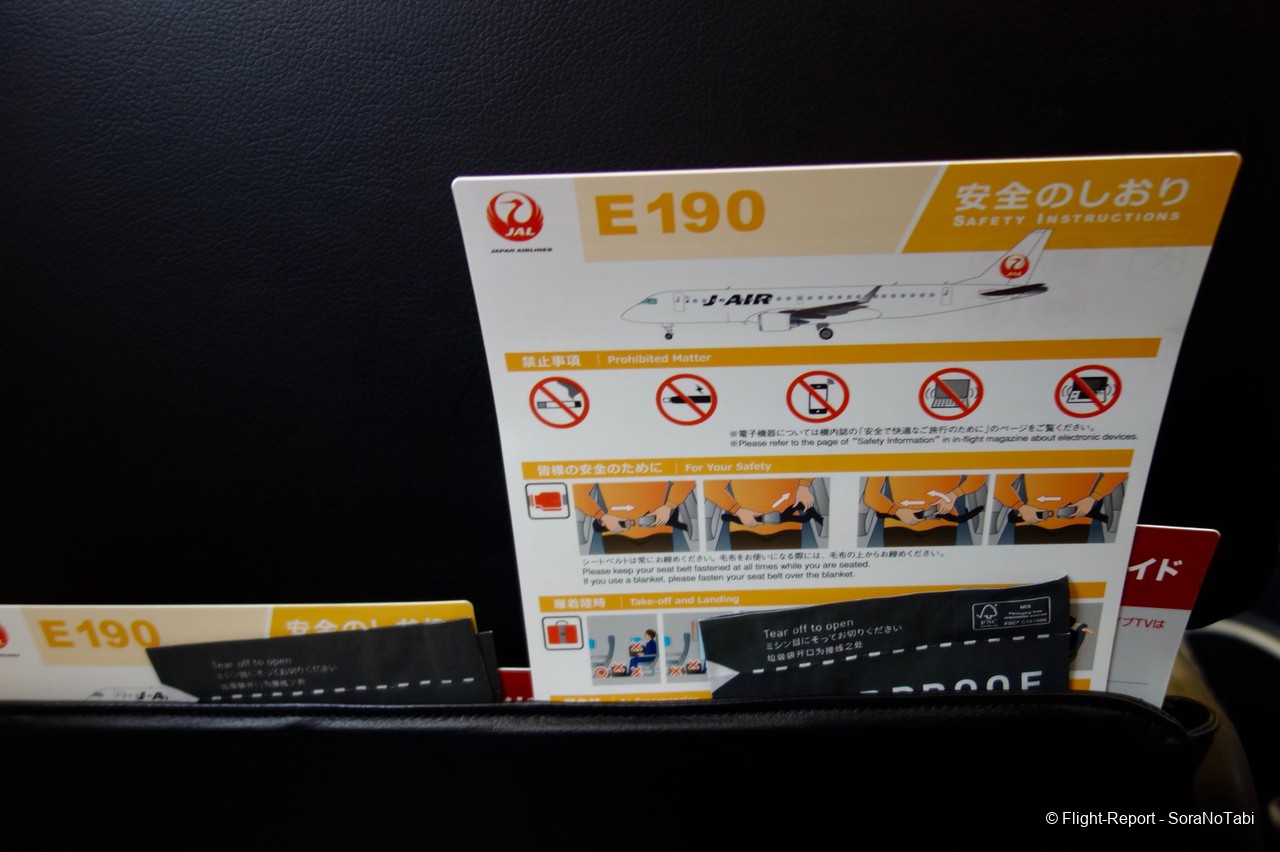
This ageing aircraft was taking a short break at the time, but it is highly likely that, at the moment of writing these lines, it has ceased to exist, it has become an ex-aircraft…..At any rate its defective Pratt & Whitney engines sealed the end of its services for JAL.

Parts of the Evil Empire fleet take shelter behind voluptuous barriers.

But with the appropriate precautions, it is possible to trespass their lines and get near their repositories. Our troops have even managed to infiltrate a spy! (perhaps two!)…
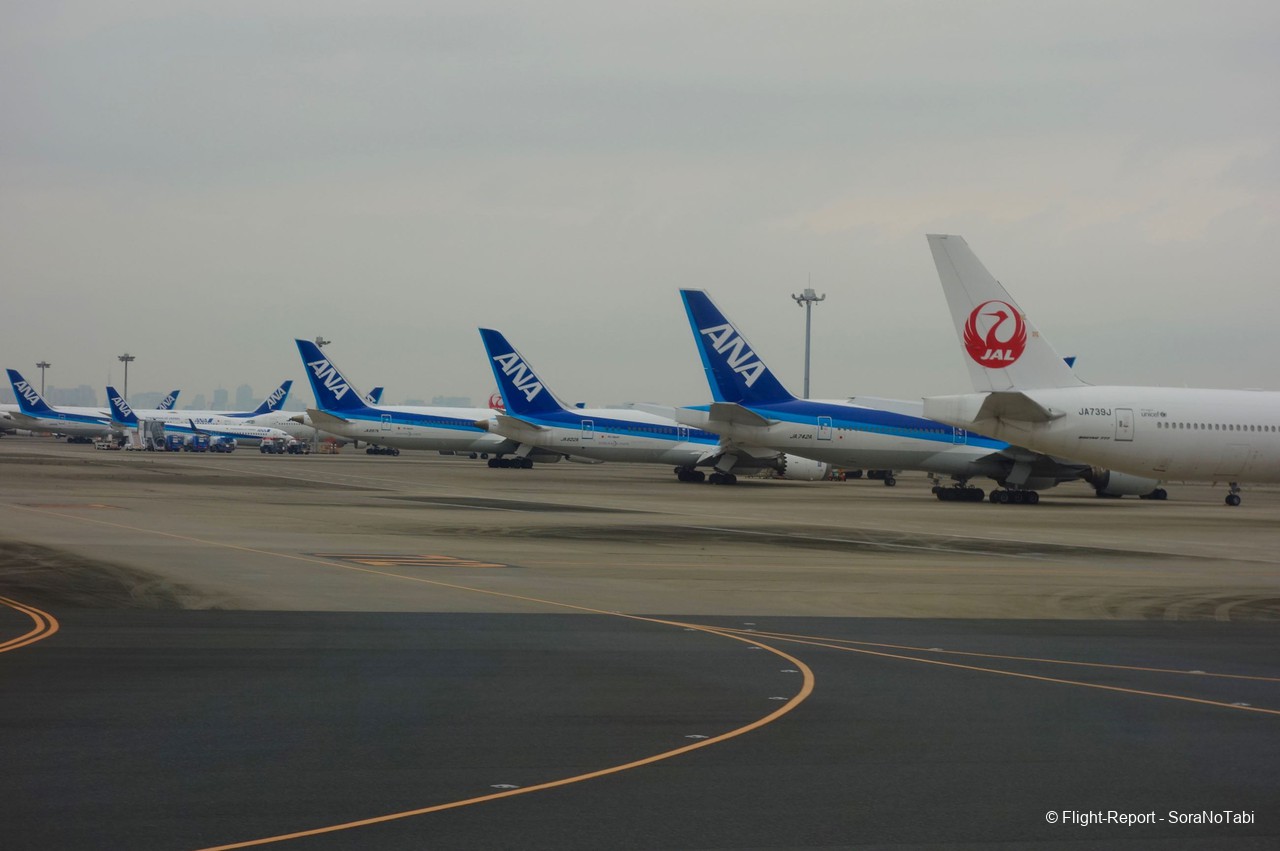
All the colours of the world are gathered in one single livery. A bit too baroque for my tastes.

This other livery, on the other hand, is really beautiful!
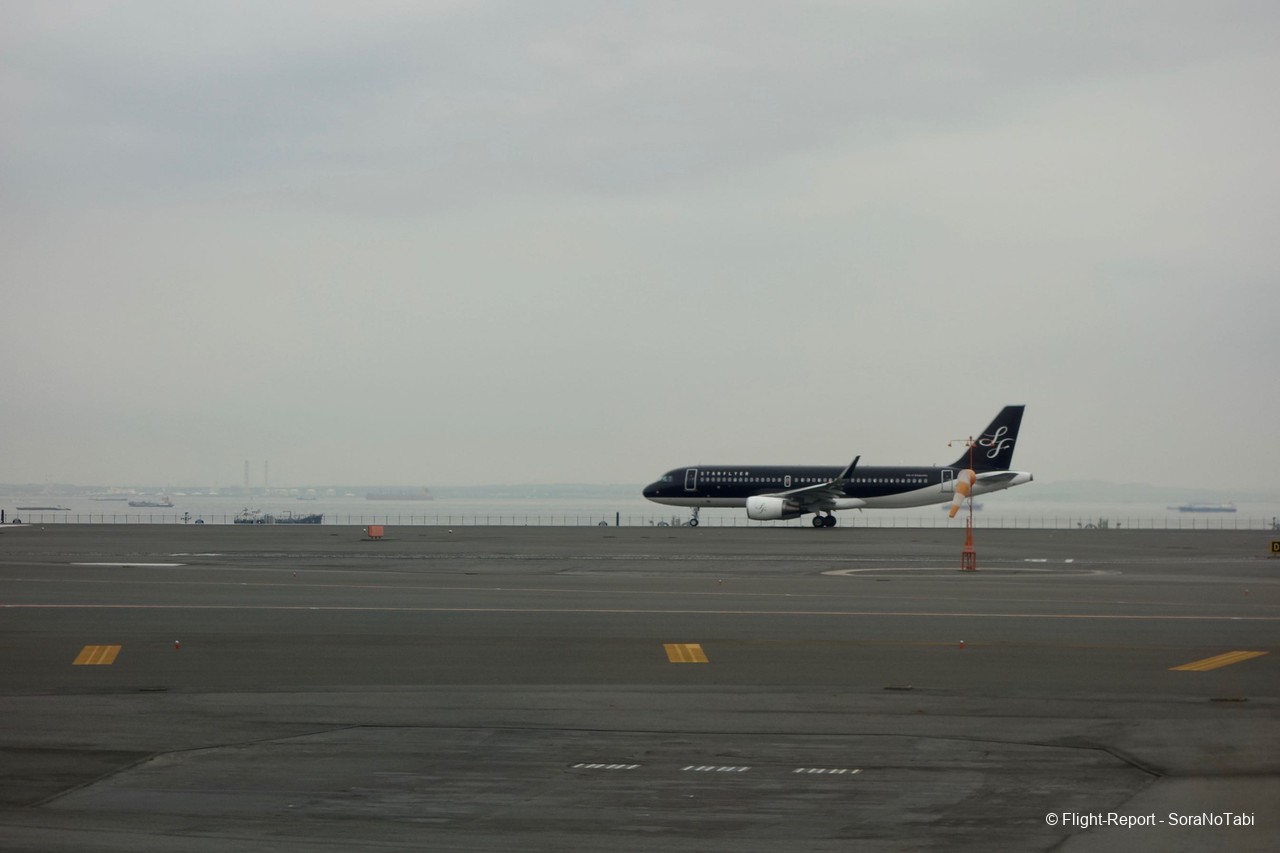
Sober and elegant. I've never flown StarFlyer (7J), but I'd like to try them one day.

They have just taken off and they will be surely heading towards Kyushu (or perhaps Yamaguchi). We won't be flying far away from each other, I presume.

air, air air
Following their footsteps.
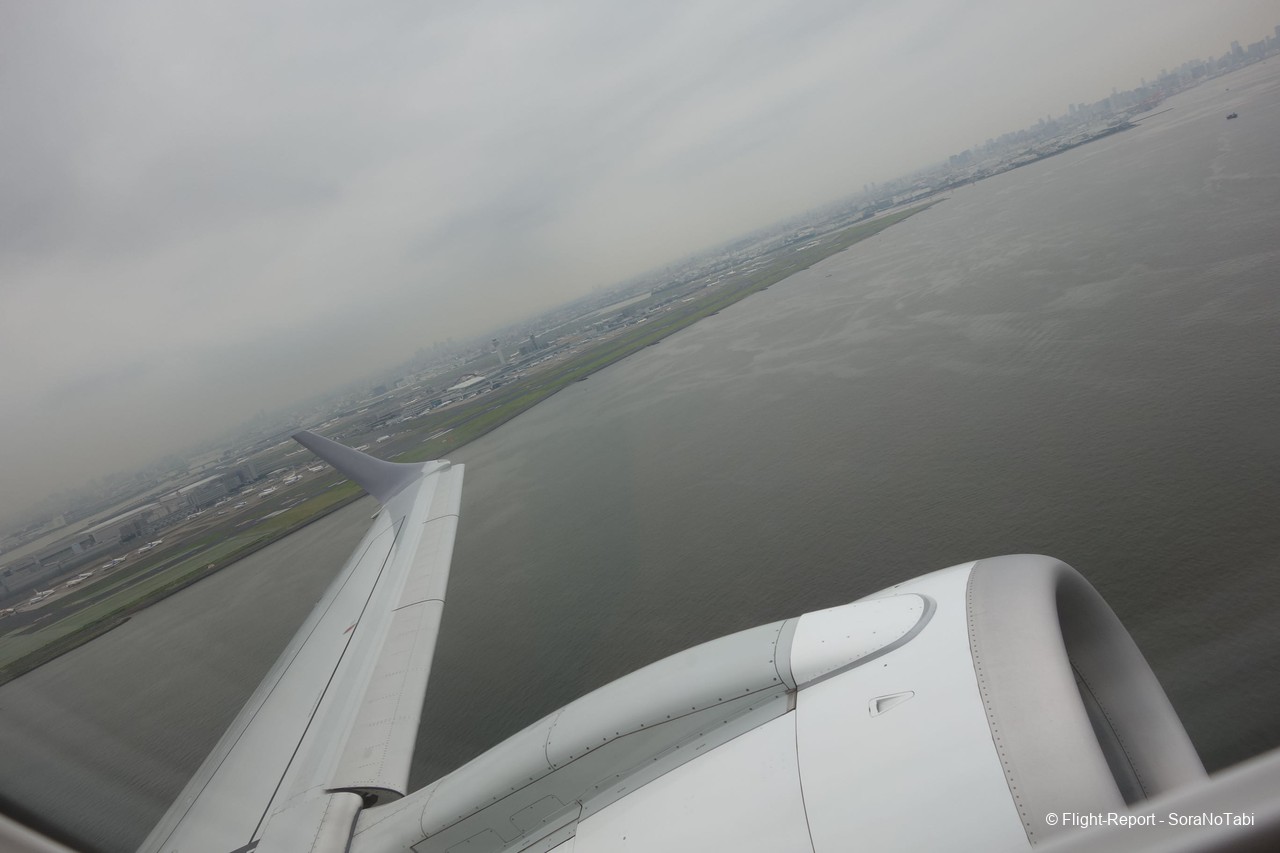
Two Tokyo landmarks that are very easy to spot when taking off from Haneda: Tokyo Skytree and Tokyo Gate Bridge.
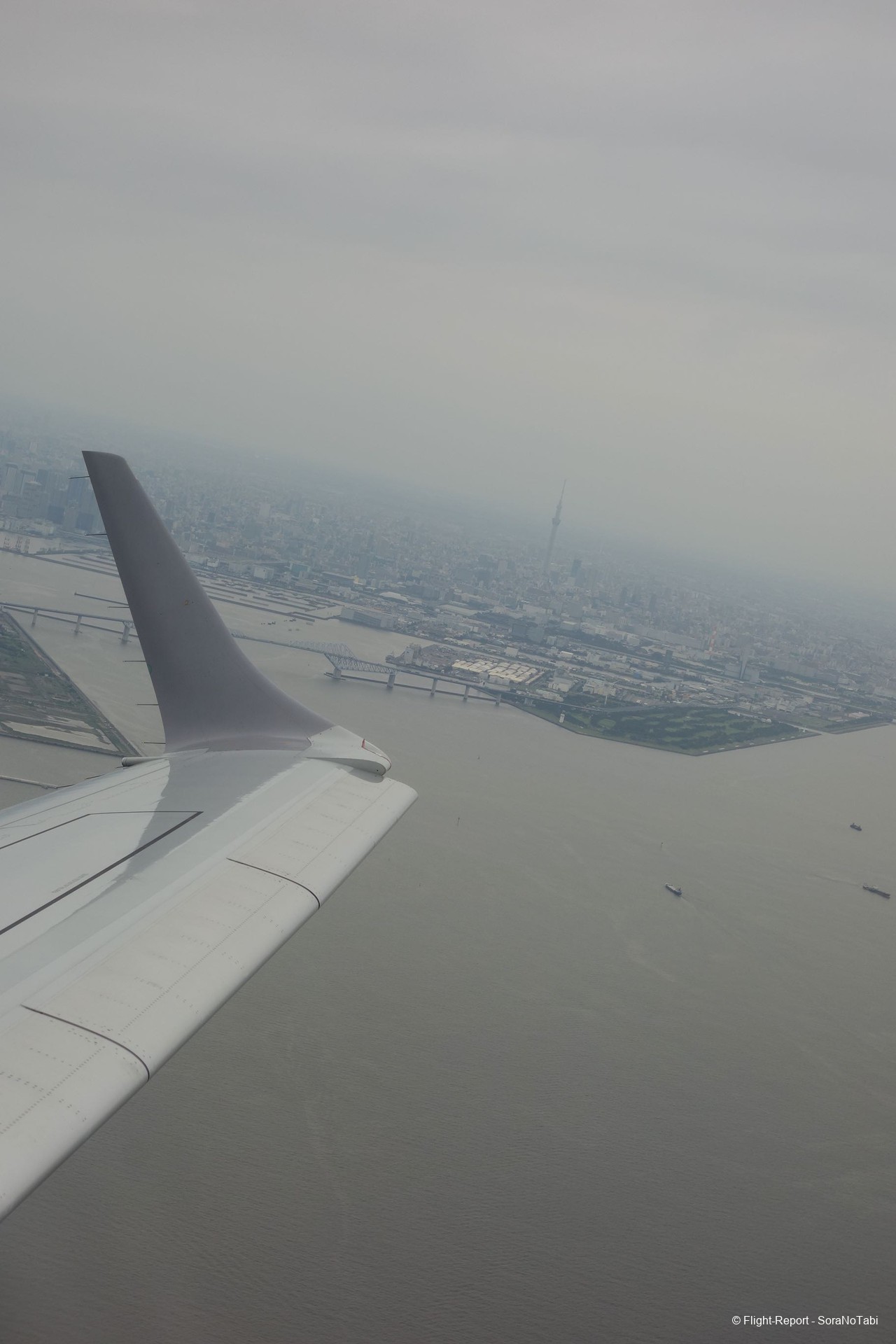
Breathtaking colour palette (for the sensible mind, I guess).
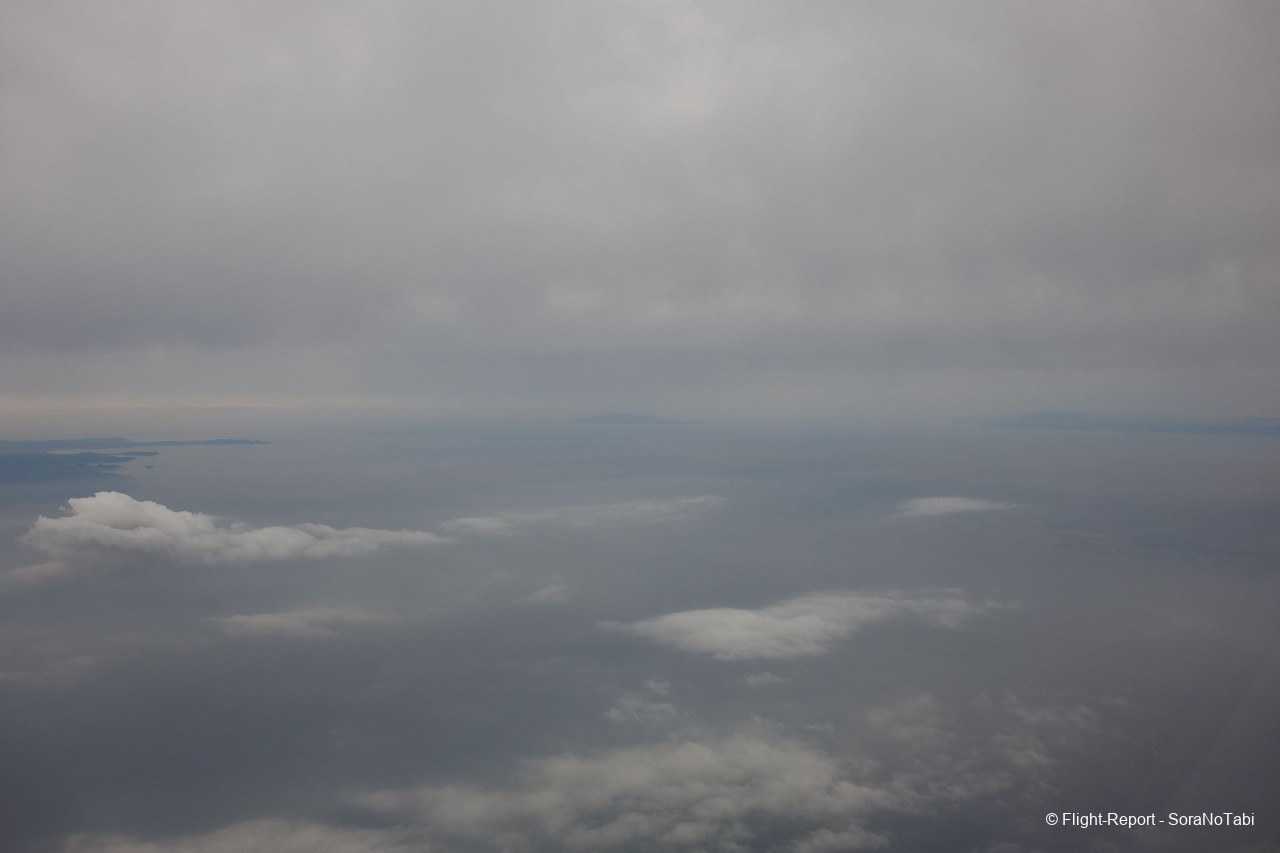
Recognizing landscapes under today’s weather conditions amounts to deciphering hieroglyphs, but if I had to put a toponym to the landscapes passing in front of our windows right now, I would bet on the Suno Cape 洲崎, at the western tip of the Bouso Peninsula 房総半島.
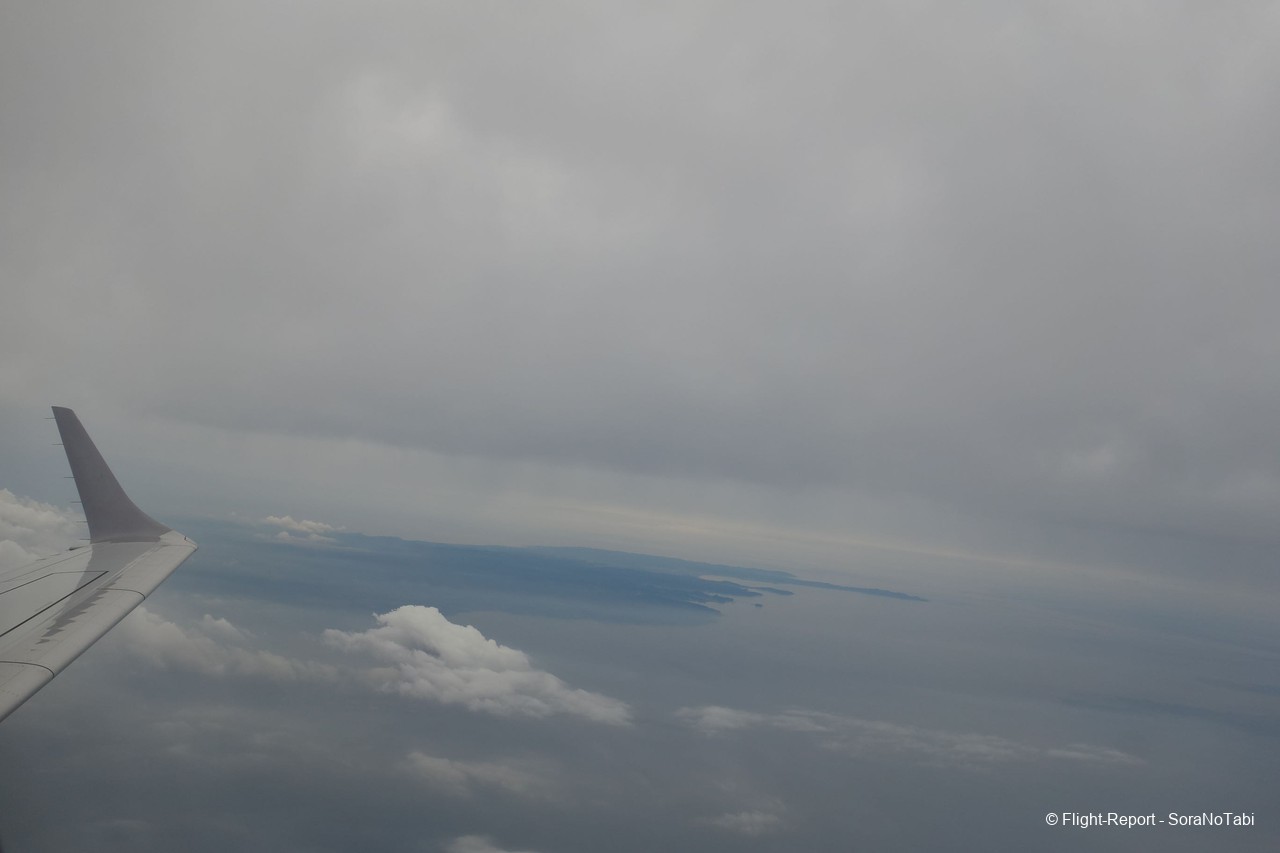
Here it's definitely easier. In the foreground we can see tanks and reservoirs lining up along the Negishi Bay 根岸湾. Towards the top of the image, the Miura Peninsula 三浦半島 spreads out gracefully.

Seems that we will have to content ourselves with interior landscapes from now on….
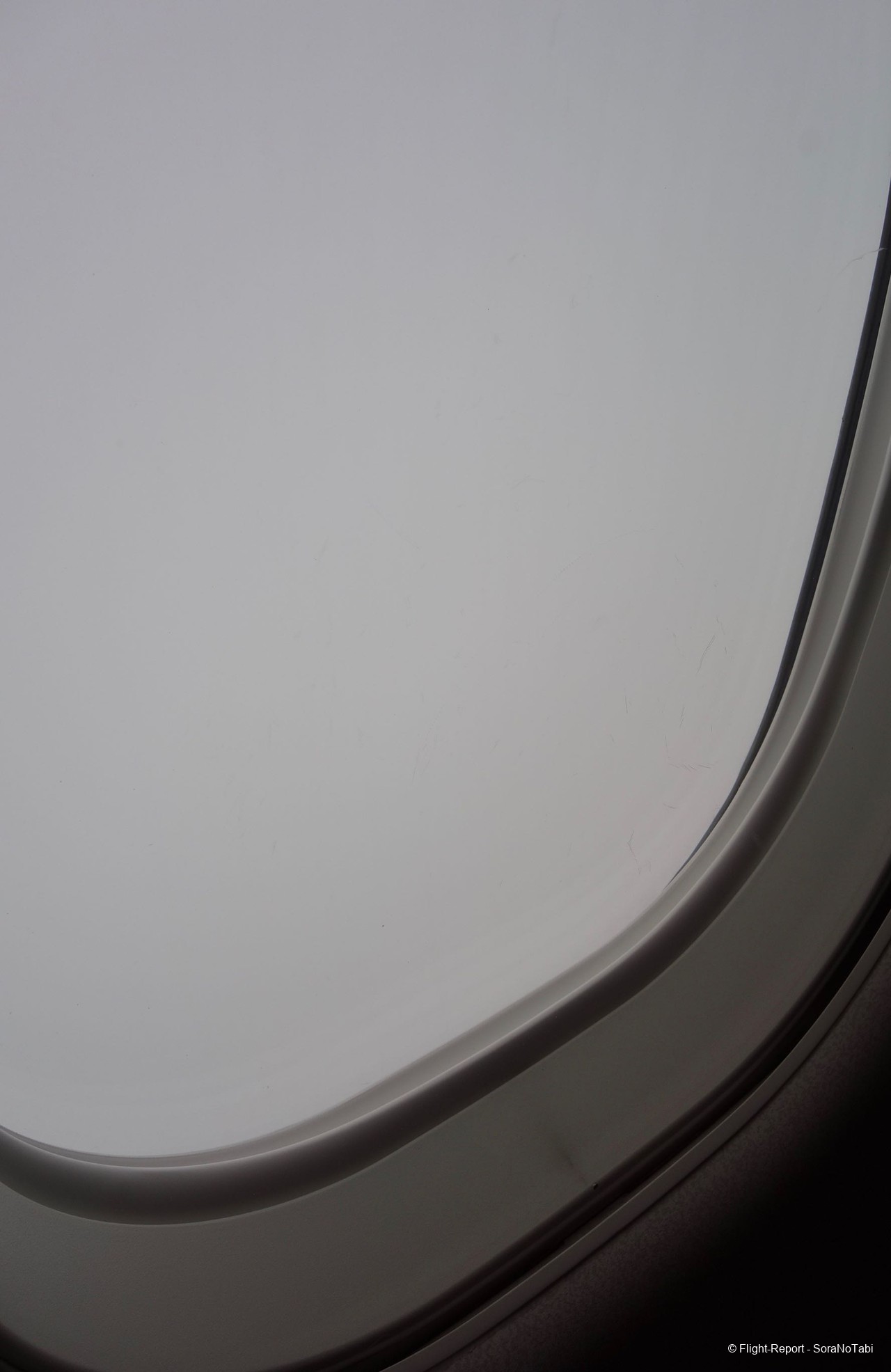
The ceiling light has a simple, modern design
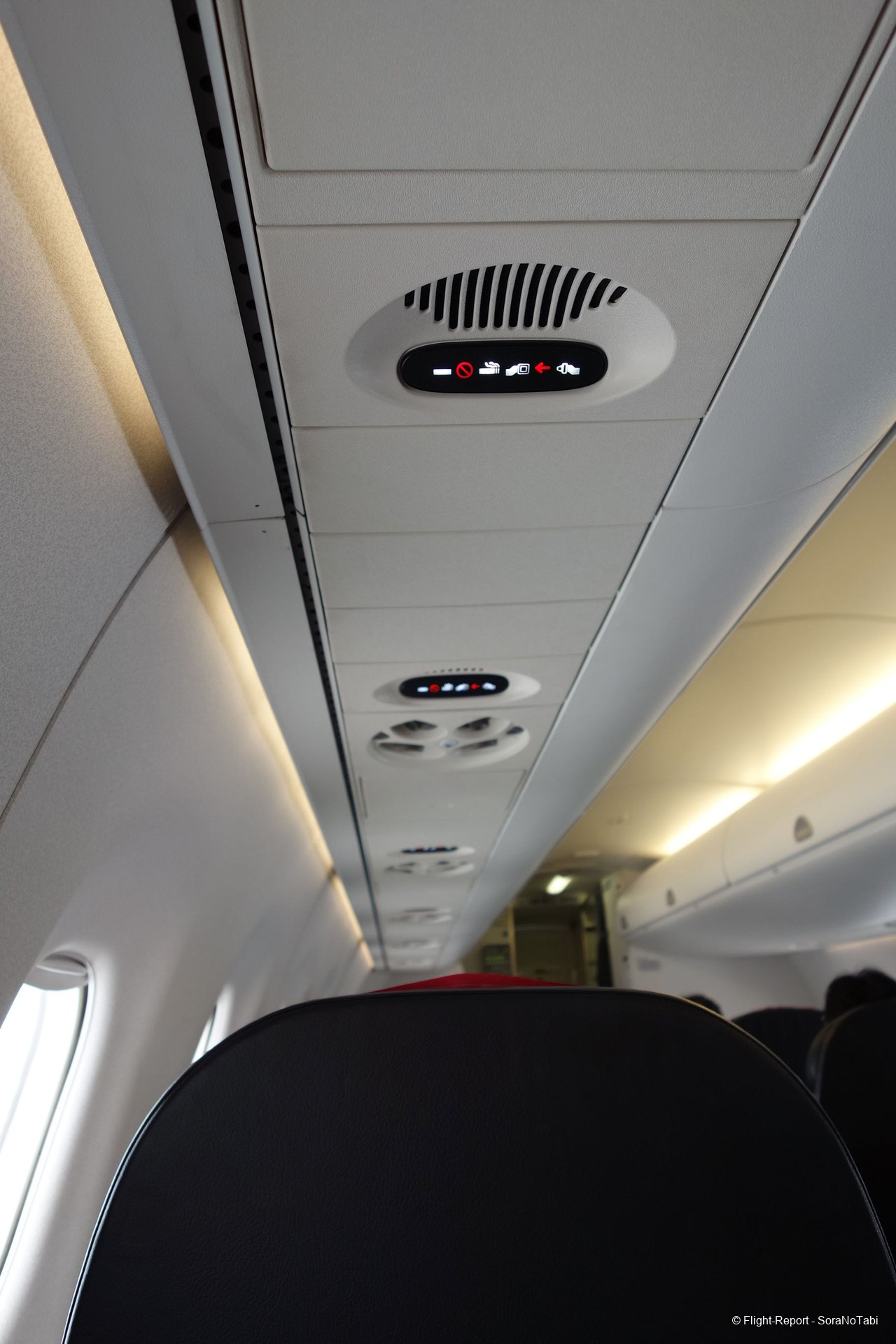
The door of the cockpit… well, it is a door. If your reading terminal allows you to enlarge the picture, you will be able to confirm that our captain today is Mr. Haritani, our co-pilot Mr. Ota and the pursuer Ms. Kunimo (uh sorry…. Ms. Onishi…) On Japanese aircrafts it is customary to make public the names of the people in charge of the flight
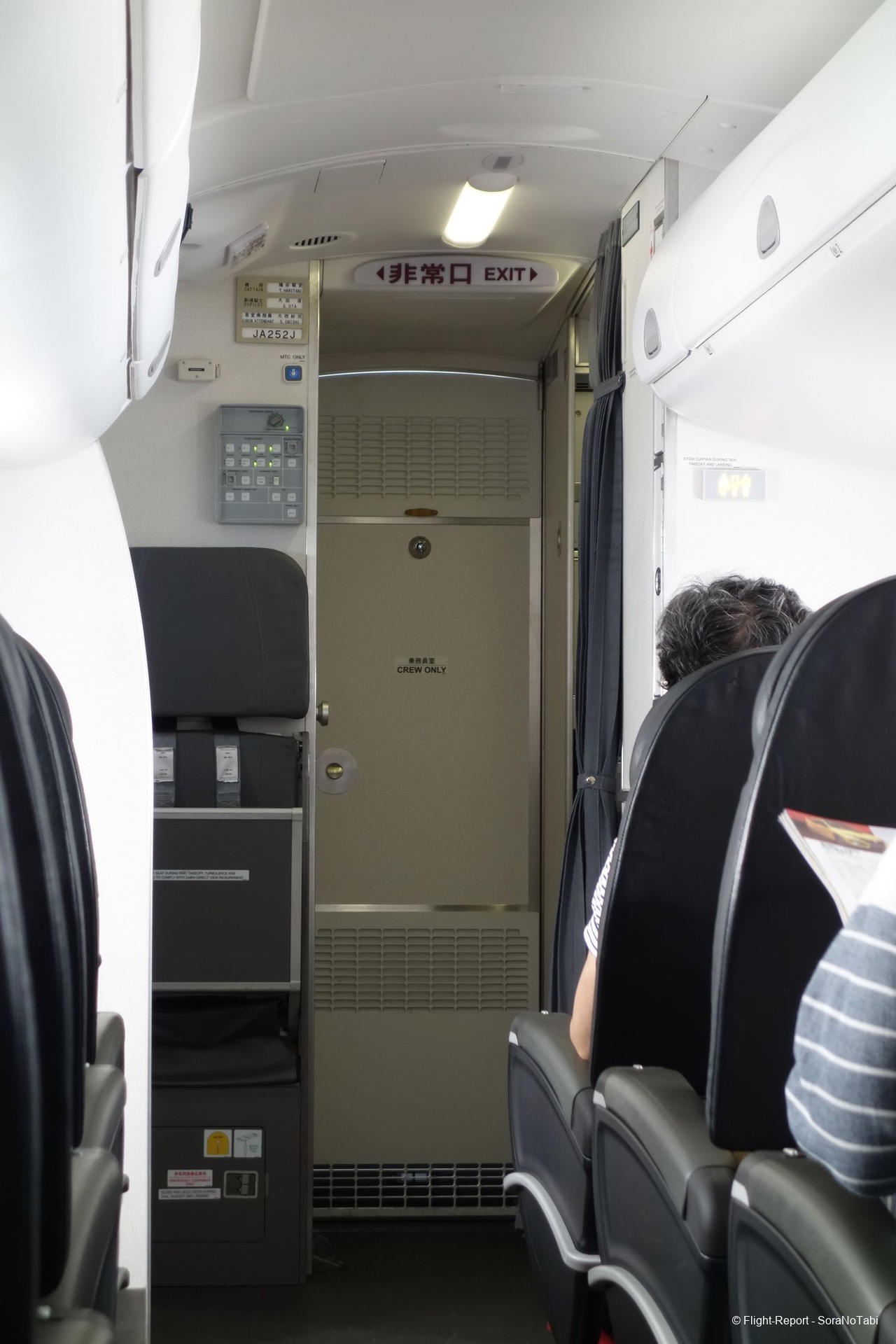
The floor is clean and the finishing touches are perfect

Kunimo-san II and her colleague start the service.
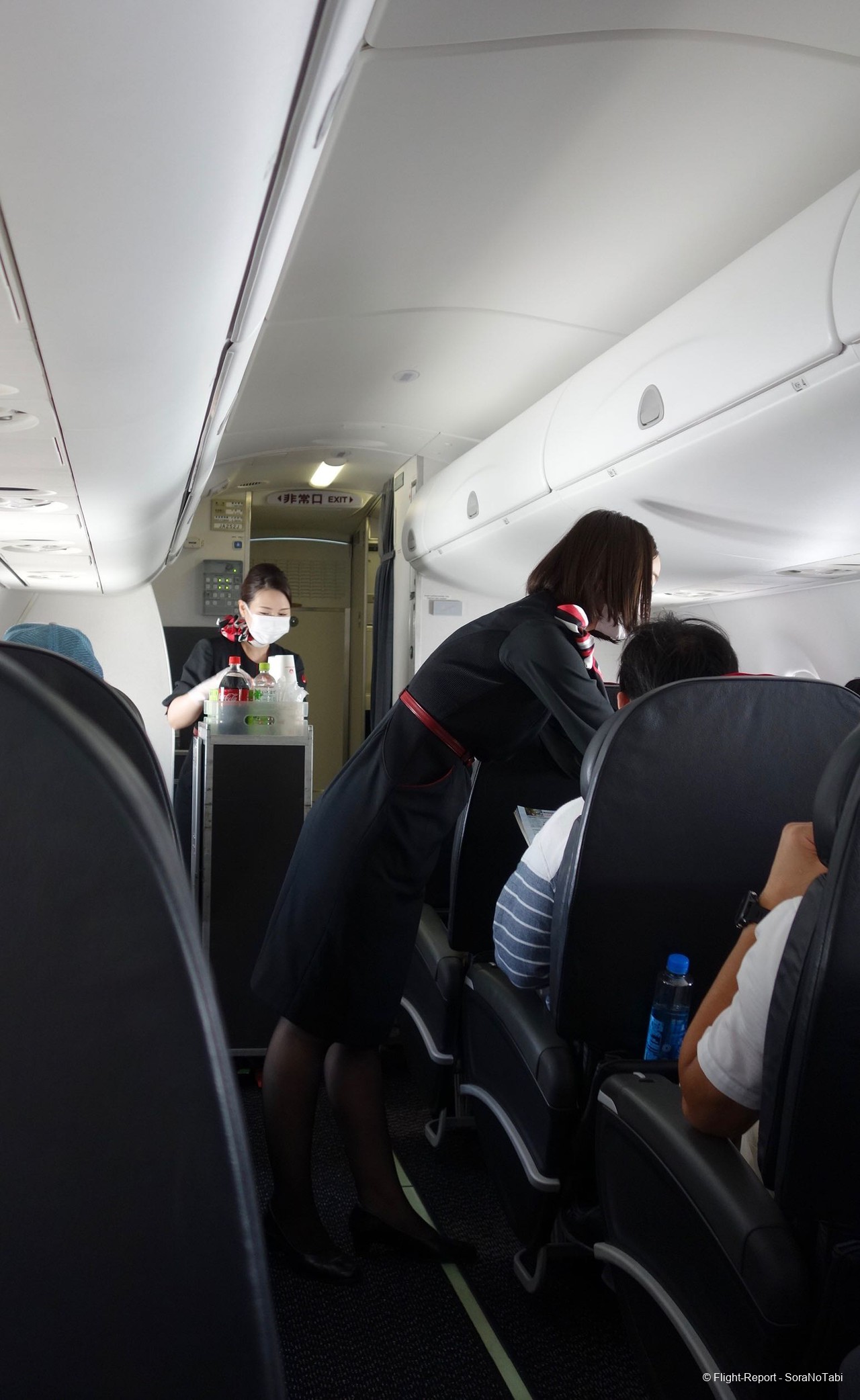
If we are to believe discussions on the internet, onboard offer is what differentiates most J-AIR from JAL: the regional operator lacks in-flight shopping and the choice of drinks is limited, or even non-existent (on shorter flights).
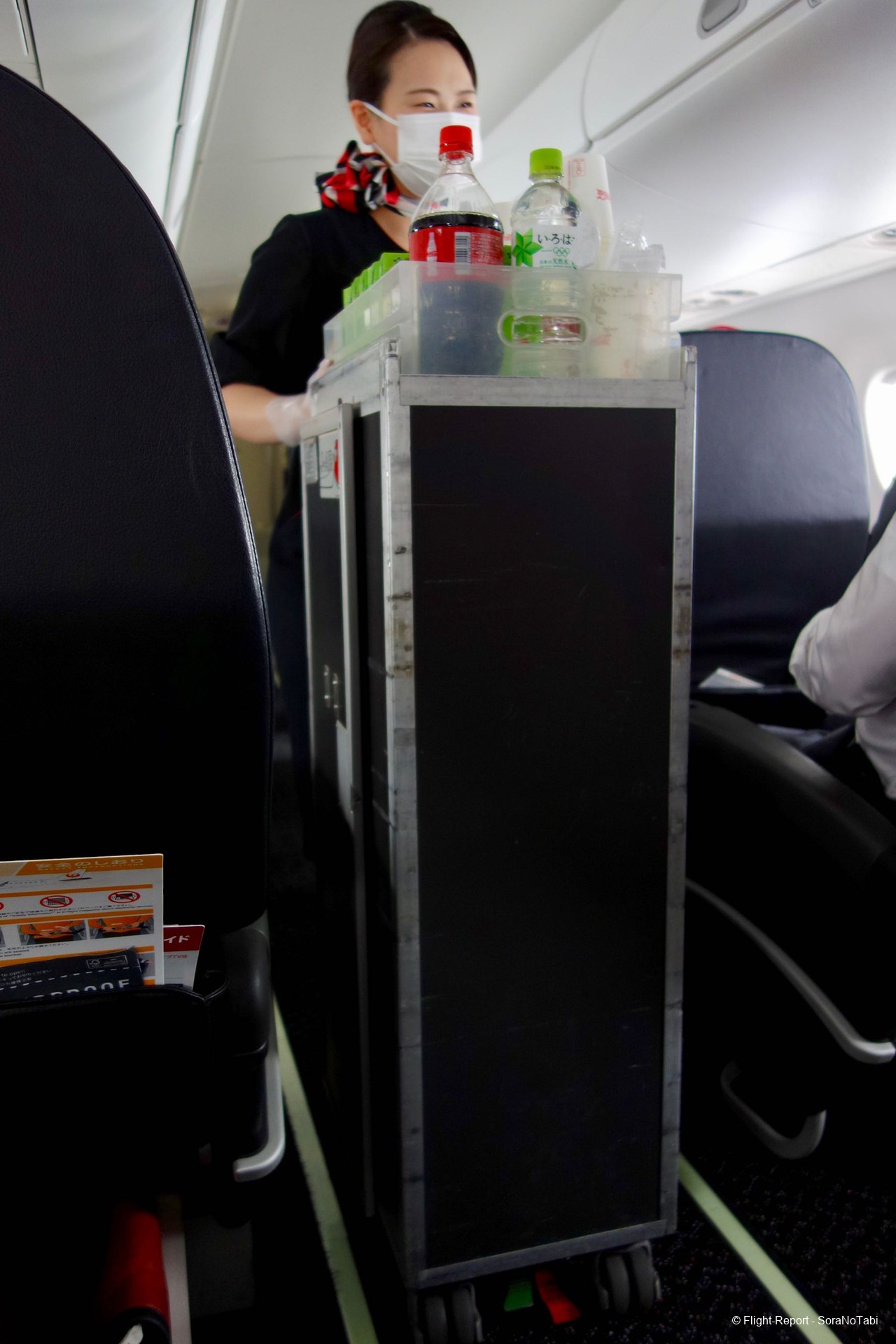
Nevertheless, my experience under the current pandemic was quite dissimilar. While the parent company only provided a meagre TetraPak of green tea, at J-Air we were offered ‘Atlanta soda’, plain water, black tea, the aforementioned TetraPak and lots of smiles!
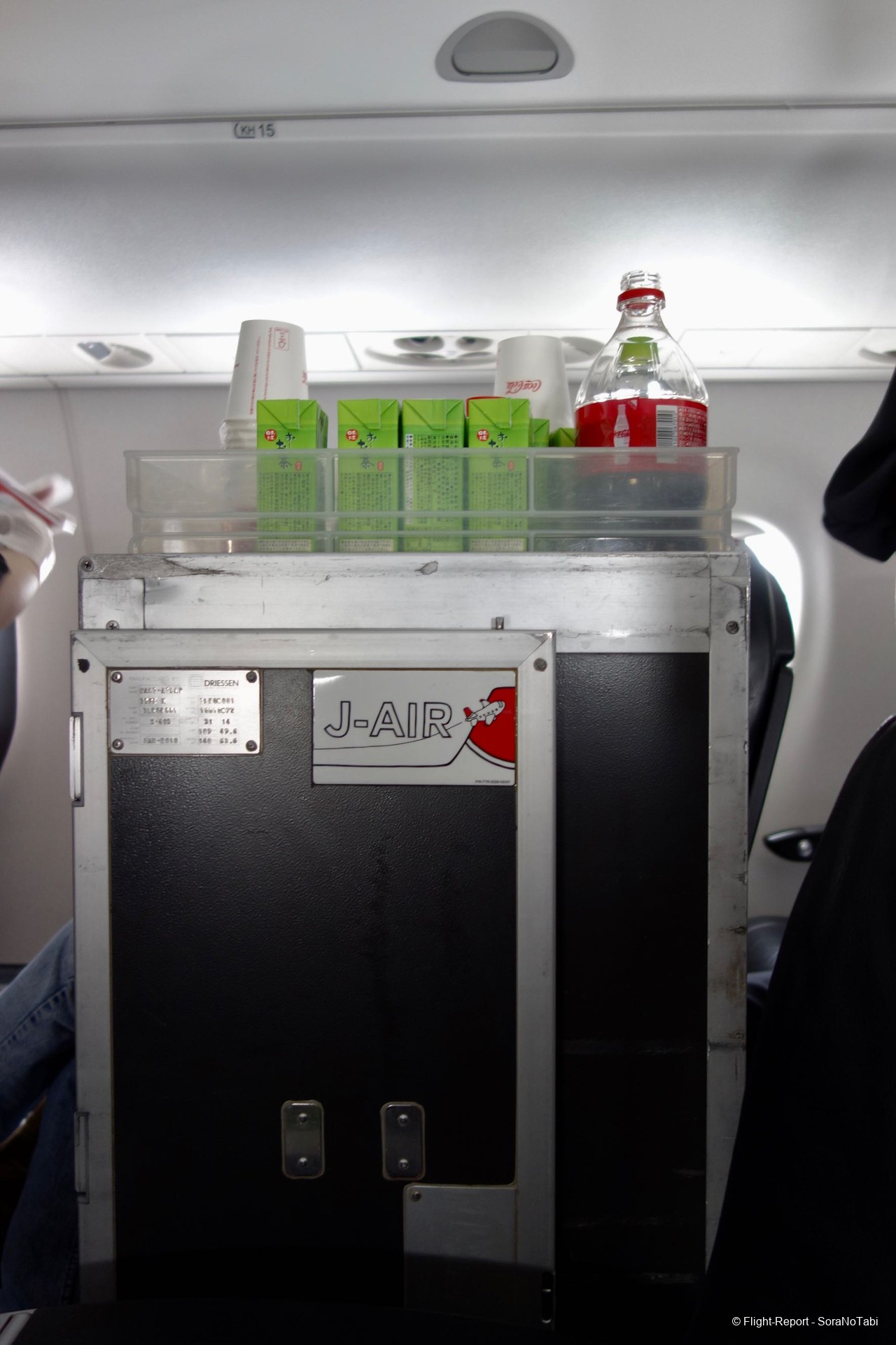
As a safety measure, J-AIR advises us to fasten the seatbelt around shopping bags, if they are placed on passengers’ seats. (Kunimo-san II took care of this; done elegantly and with a smile).
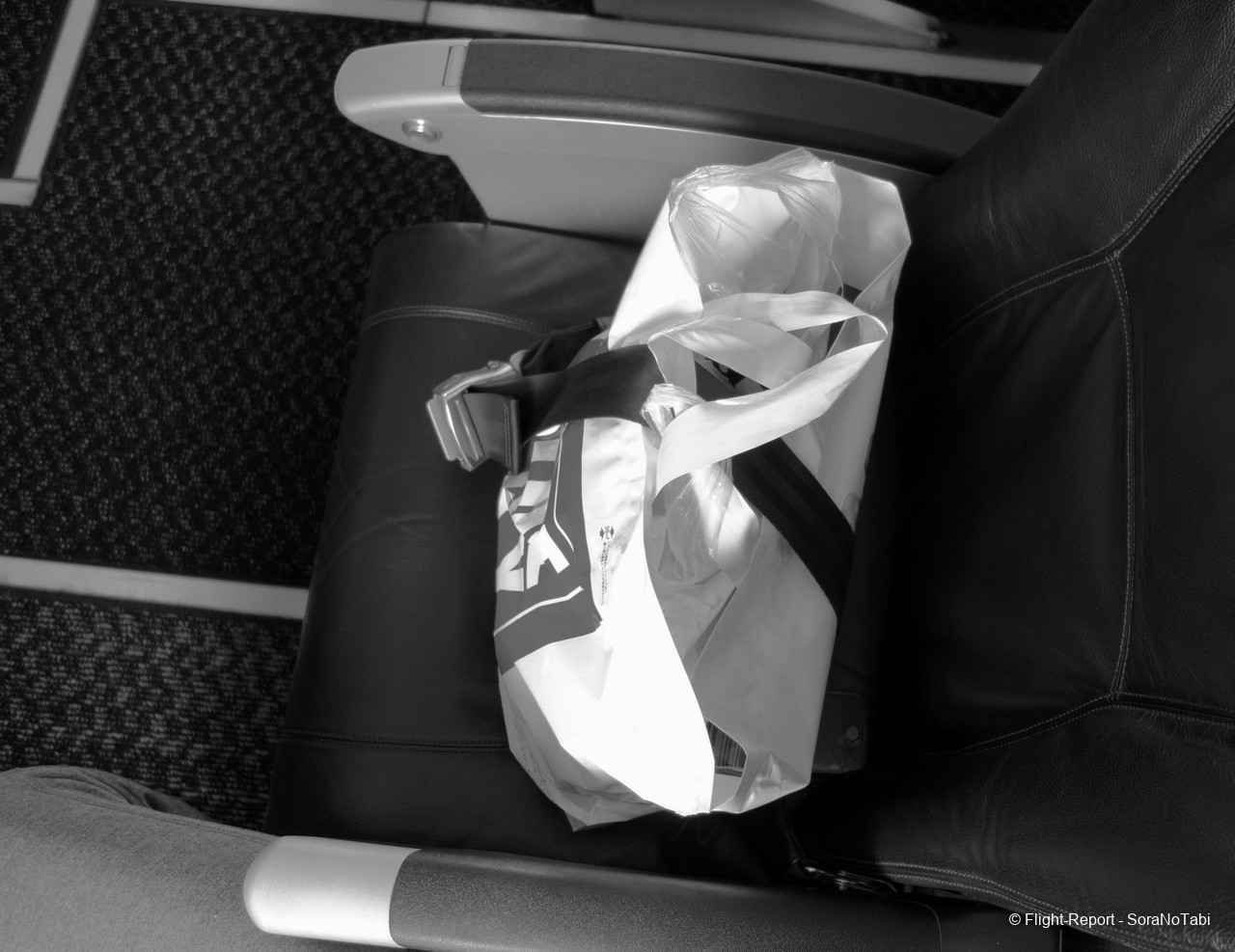
Shortly afterwards, the outlines of small islands begin to appear.

And the descent procedures commence. Visibility is close to nil.

Guessing our location becomes a nightmarish puzzle. Even in a region which is not completely strange to me. The fact that the Seto Inland Sea is dotted with countless islands and islets does not really help.
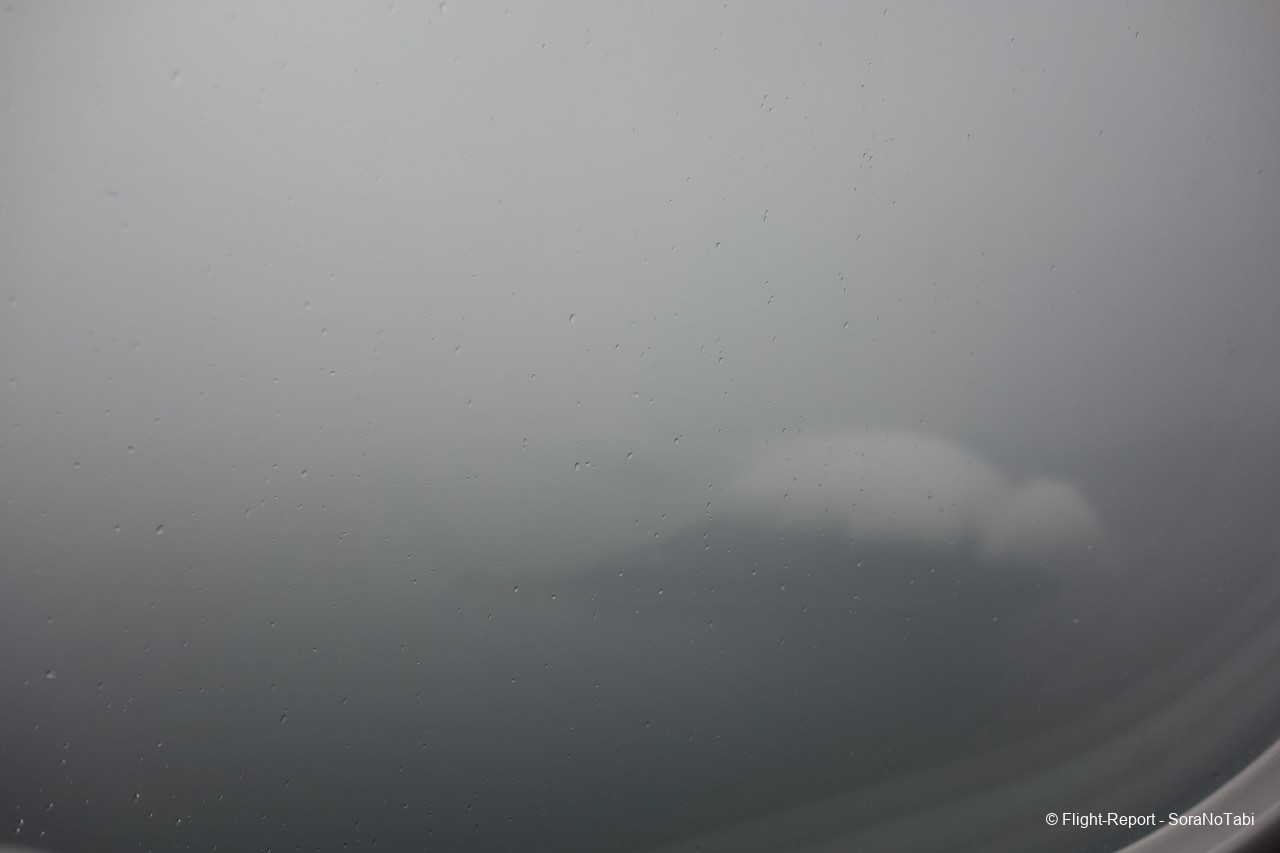
Could this possibly be the village of Jinwa 神和村 on the island of Nuwa 怒和島, part of the Kutsuna archipelago 忽那諸島? This group of islands was controlled by the lords of Matsuyama and those of Ozu. It served as their ultimate base camp before negotiating the crossing of the Inland Sea (on their biennial visits to the Tokugawa shogun). The last primary school in Nuwa had just closed when we flew over it, due to lack of students.
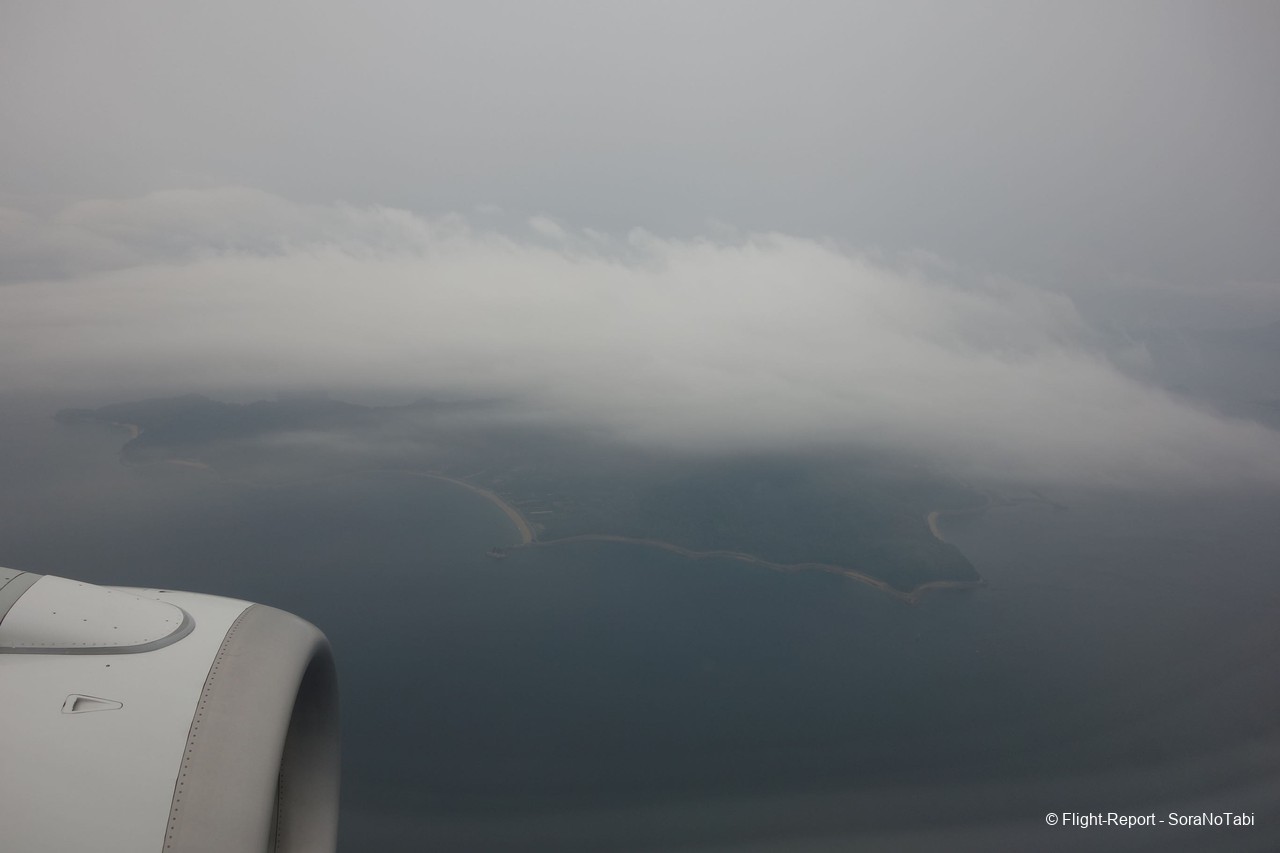
It’s tipping down.

Despite the fog and the blurriness of the picture, what our camera captured beyond the jet engine is, with a lot of certainty, the island of Gogo 興居島, very close to the coast of Shikoku Island. The island is well connected by public transport (train + ferry) and many residents commute to Matsuyama, the capital.
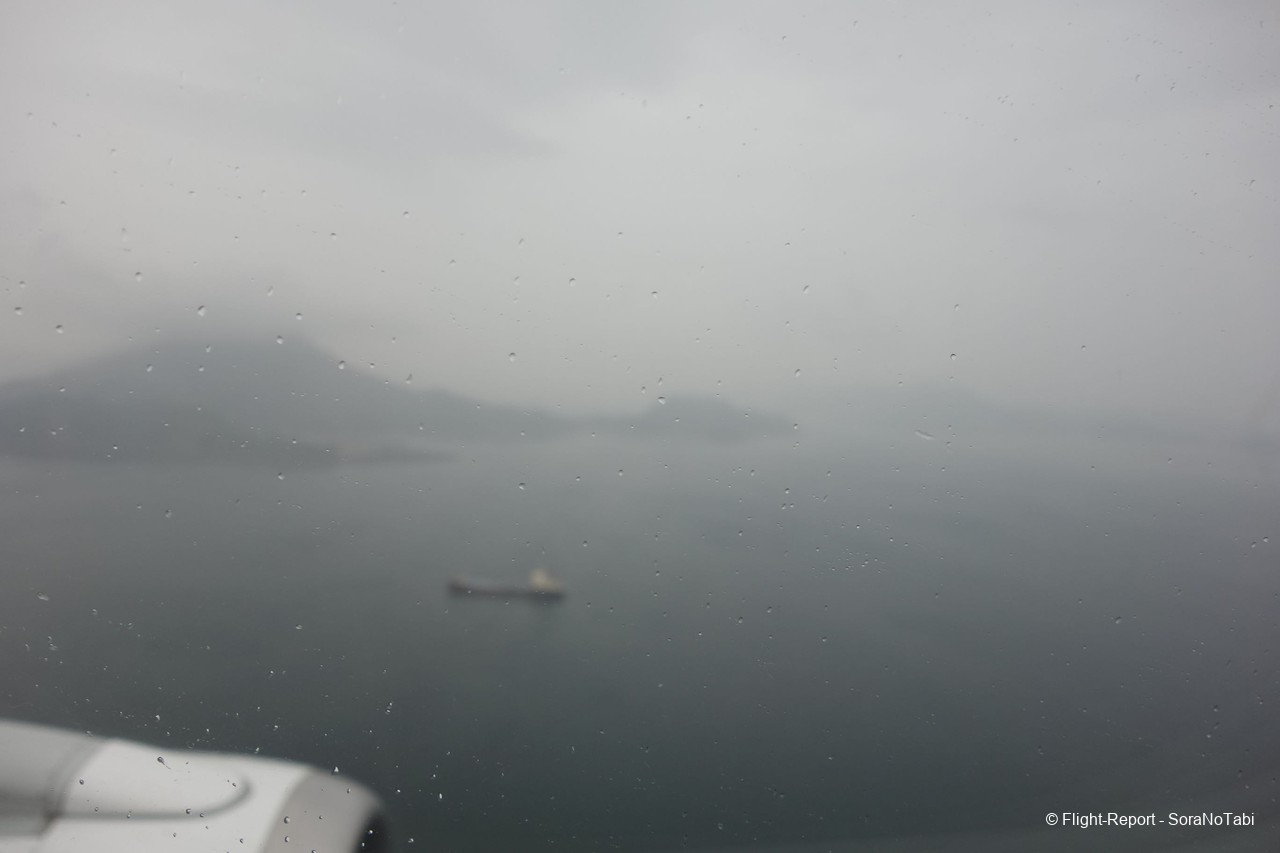
This time the auto-focus function worked just fine. At the centre of the image, the historical bay of Mitsuhama三津浜. On the left, airfield premises begin to get the attention of our lenses.
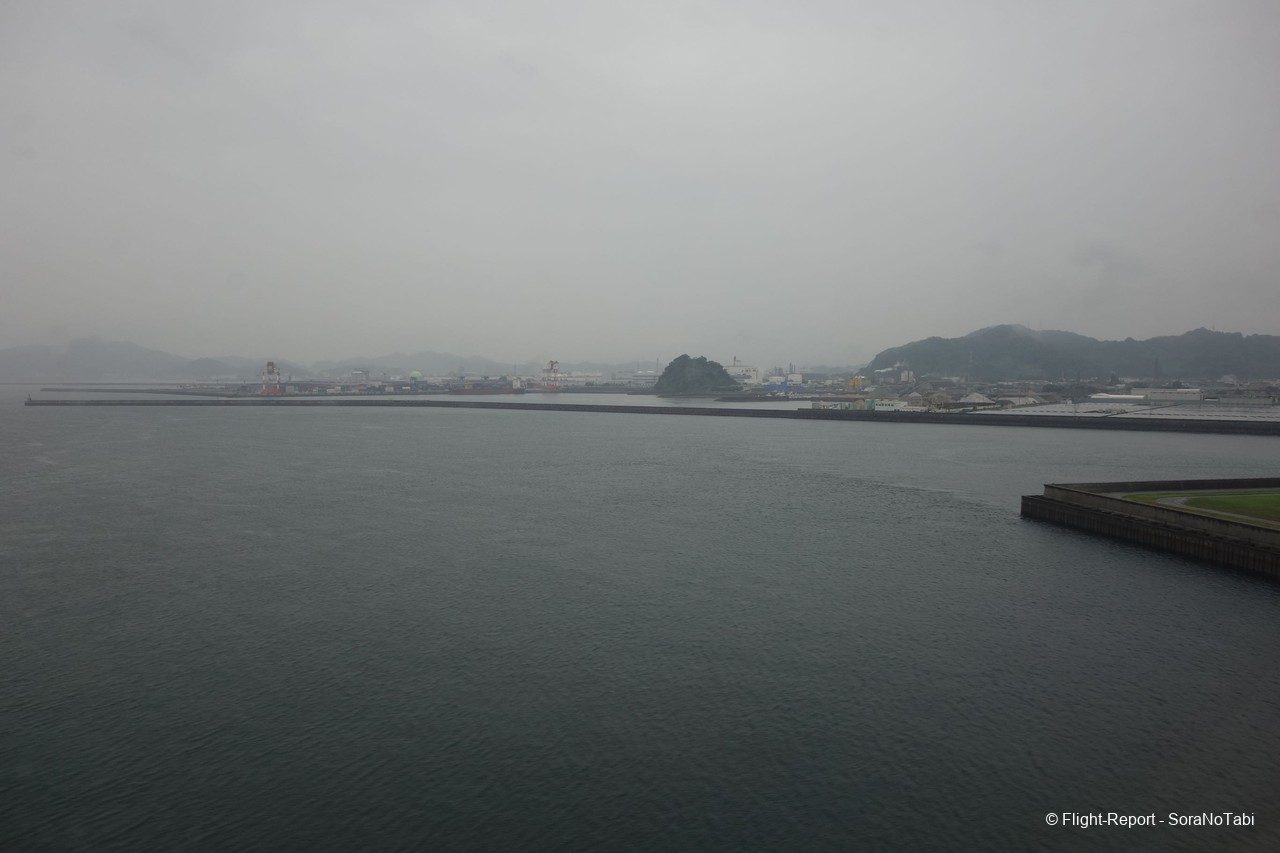
Slight relief…. there won’t be any water landing this afternoon… The chimneys of the Teijin plant, producing aramid and other high-performance fibers, rise into the horizon.

We have just landed. Under such weather conditions is not easy to recognize where we exactly are.
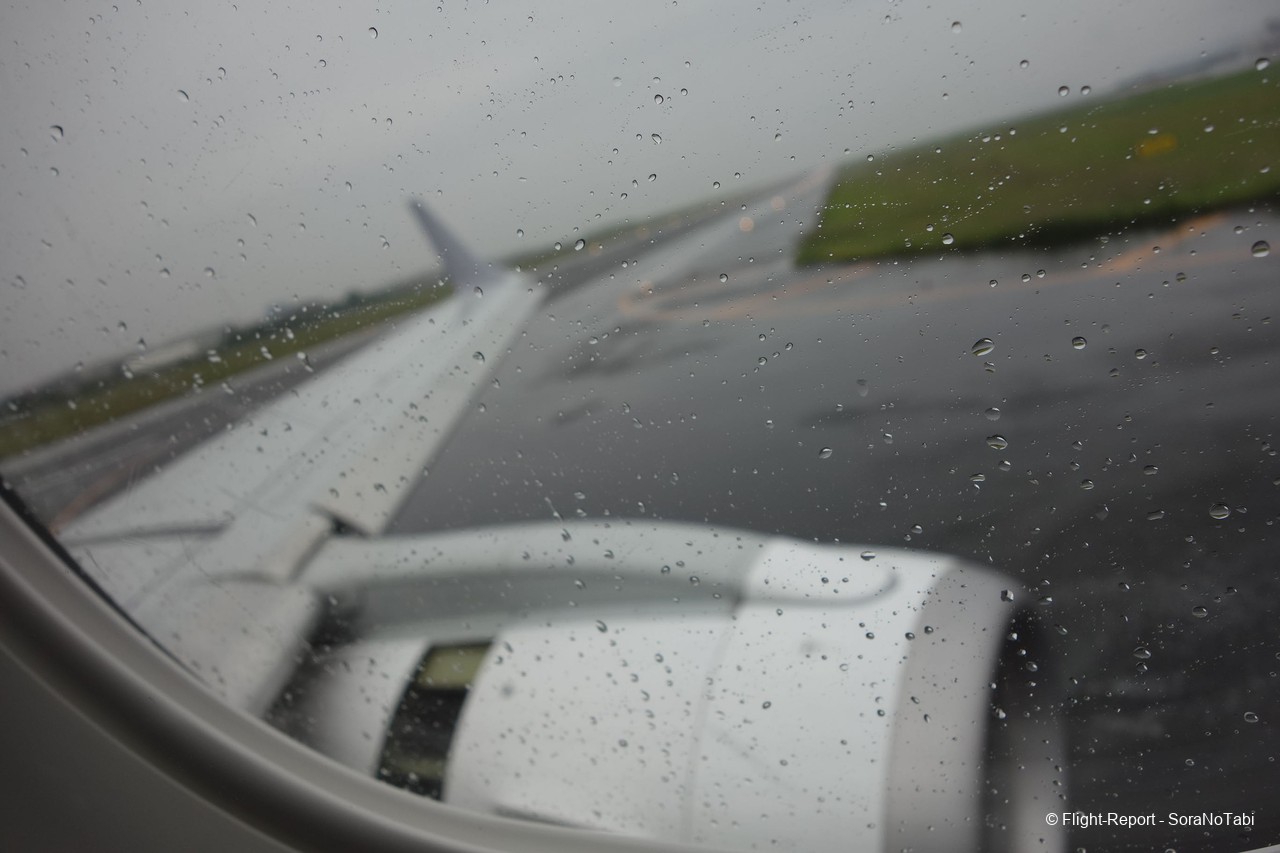
It's raining cats and dogs
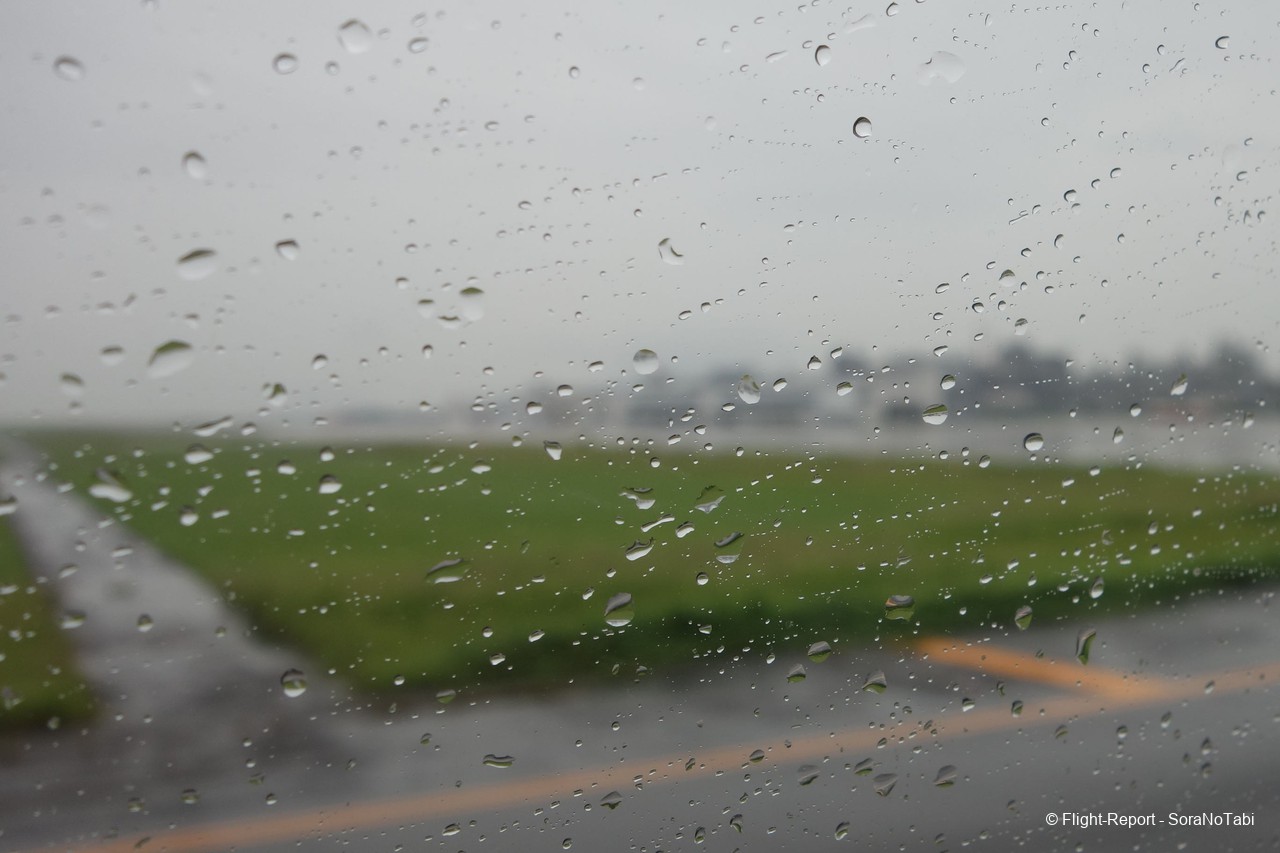
The forces of the empire are about to take off for Osaka or Nagoya, using one of their noisy DHC-8.
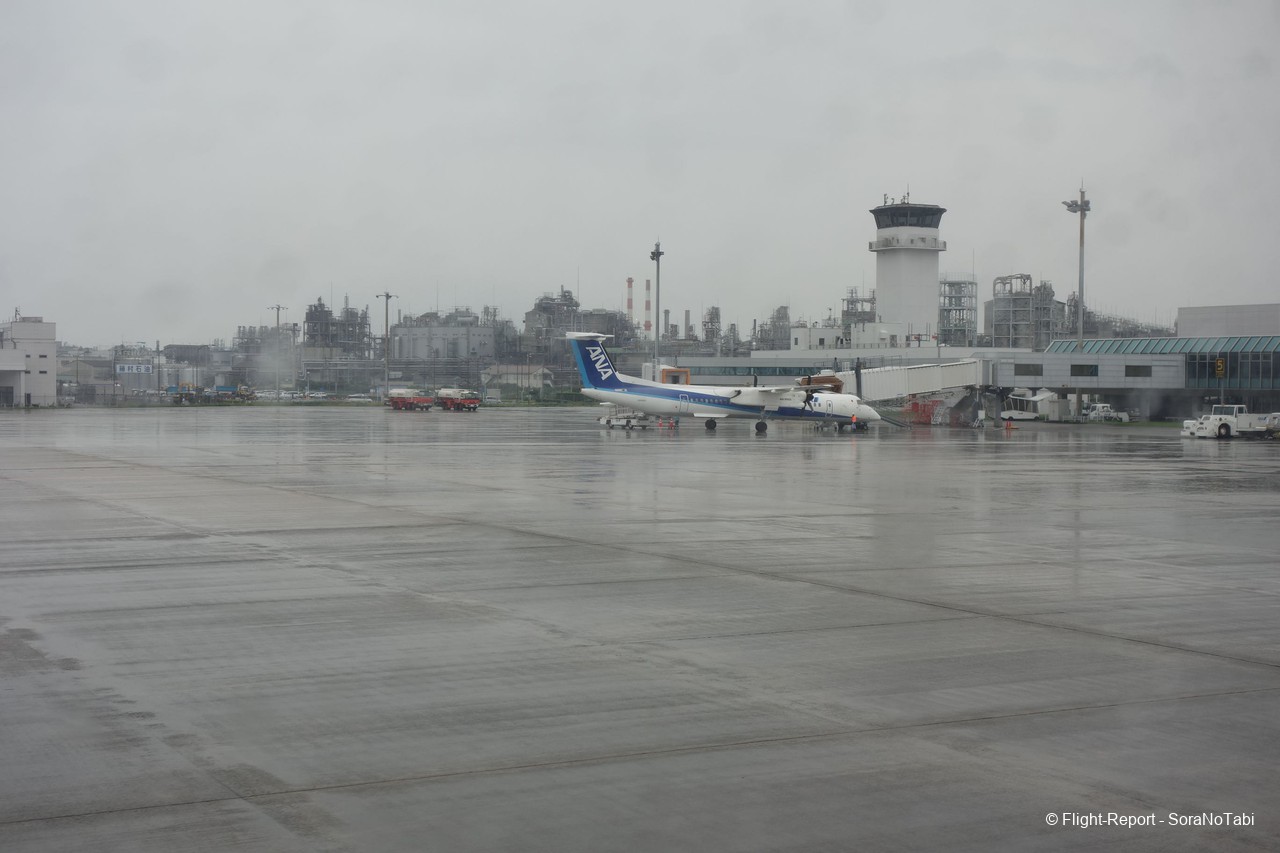
Final turn, under a torrential rain.
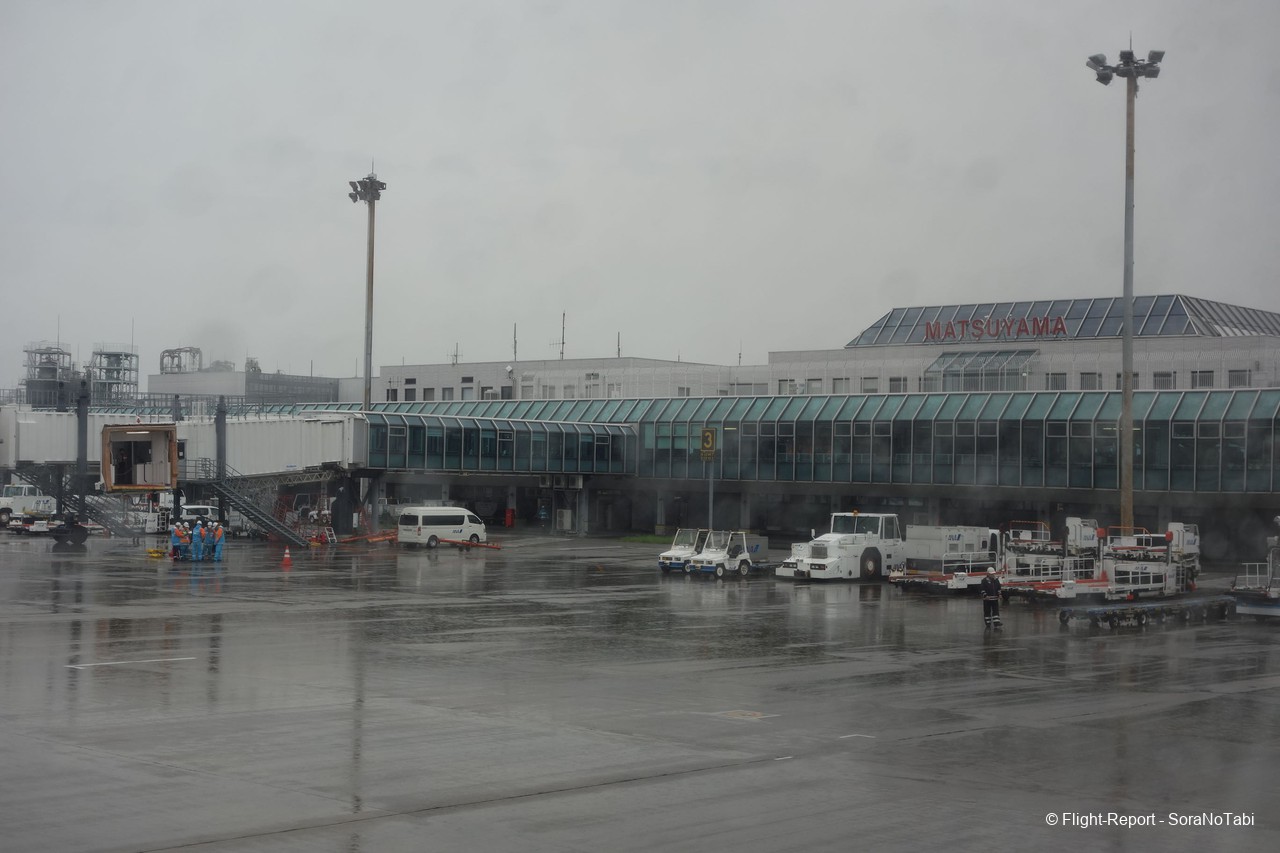
Below we present you with a rare epic, truly uncommon in our latitudes. A short tale in which impulses and self-preservation instincts (really?!?) prevail over the pursuit of togetherness and social harmony,
(footnote: train commuters in Tokyo -and to a lesser extent, in Osaka- may disagree with what I just wrote)
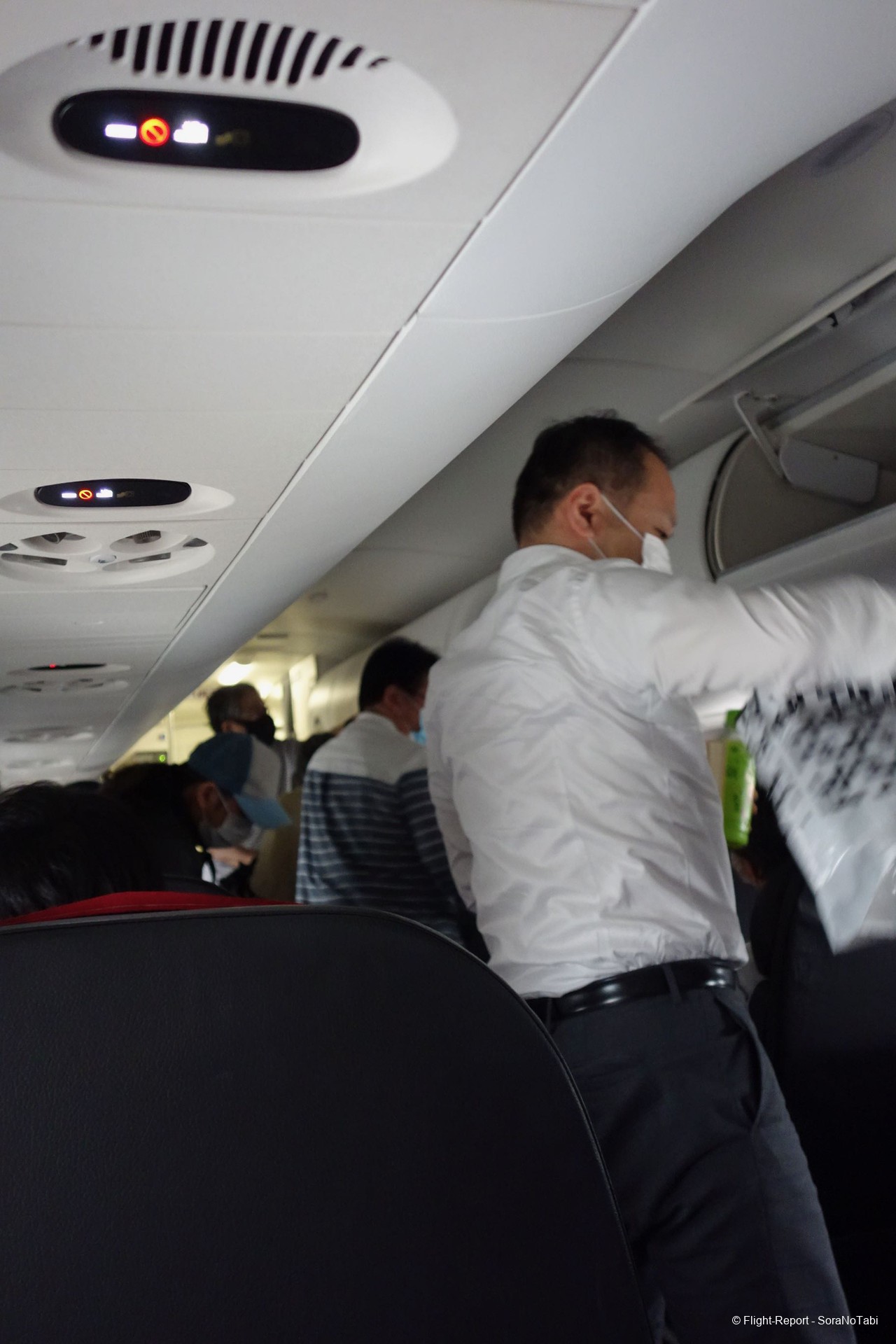
We get the opportunity of be involved in such a saga even in these troubled times and despite being firmly urged by the cabin crew to keep our distances. Presumably disembarking an aircraft in a calm and orderly manner does not belong to the -vast- list of good manners permeating contemporary Japan.

Today the battlefield remains relatively tranquil. Ultimately no material worthy of tabloid-columns will emerge. But the disparity with the parsimony and ease displayed when boarding the plane really astonishes me.
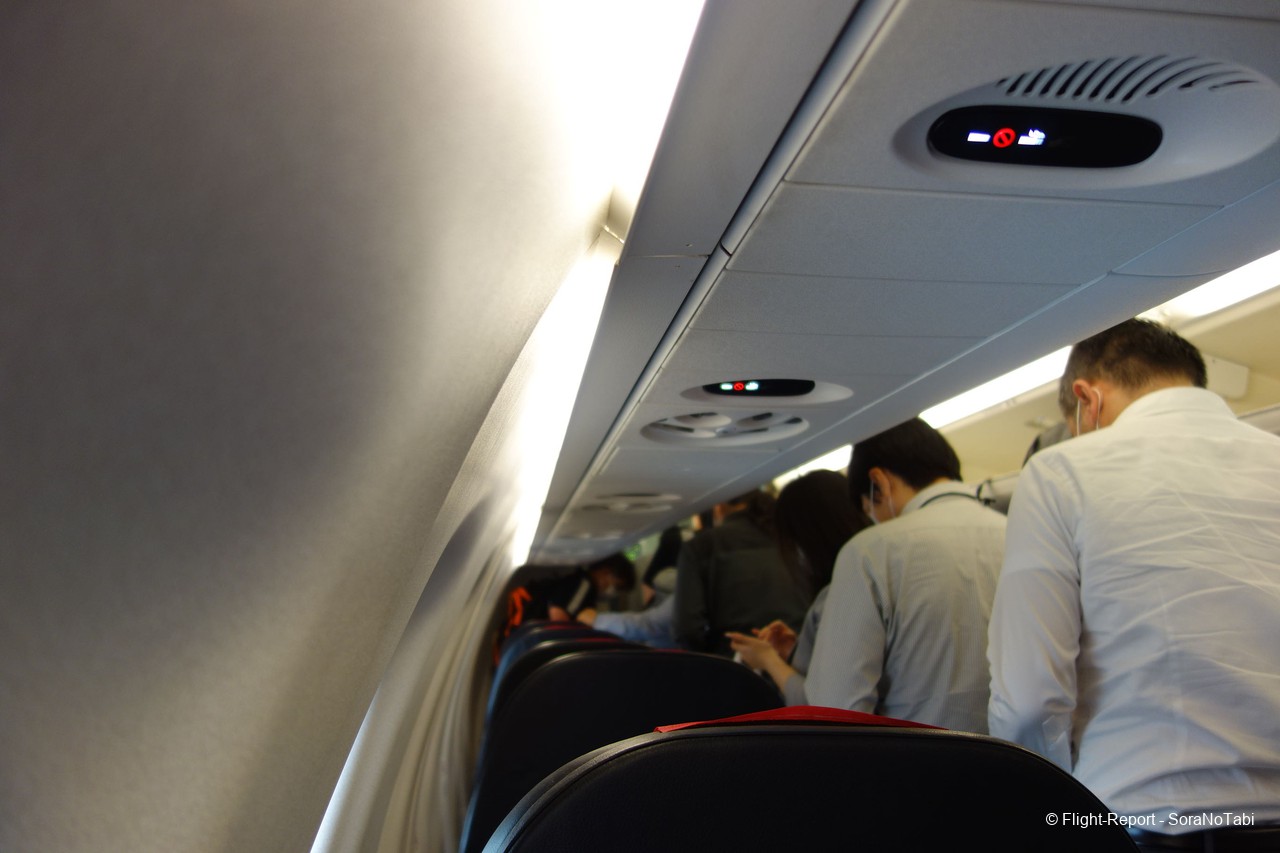
Final reasons for awarding maximum points to my seat today: ergonomics and comfort are excellent.
Of course, these features are shared by all seats in economy class but they stand out when compared to J class seats (although wider, much less comfortable). Adding such comfort to all the plus points described previously, it is quite easy for me to declare the 15 A the big winner of this cabin configuration.
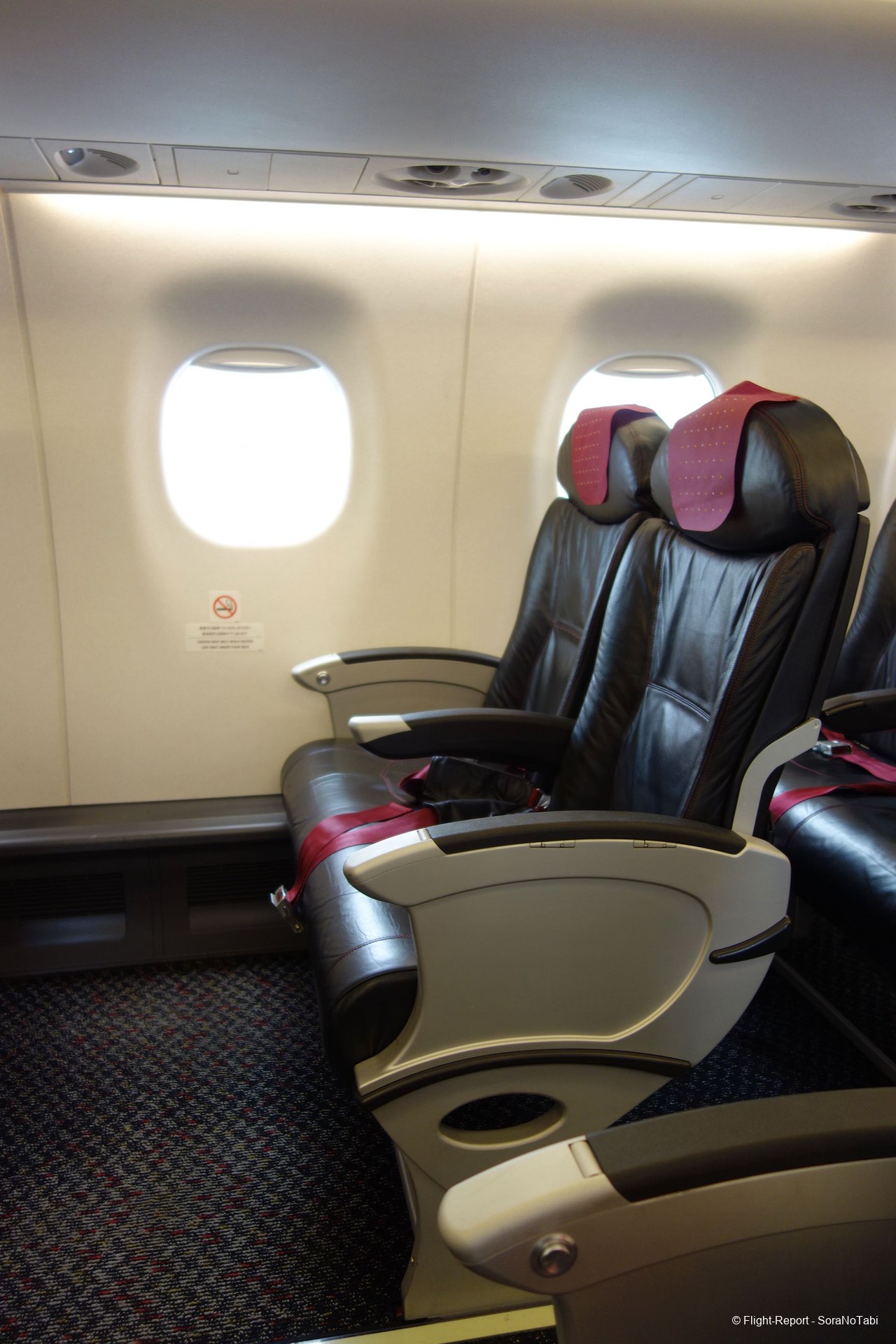
A series of stills depicting the (lovely) economy cabin
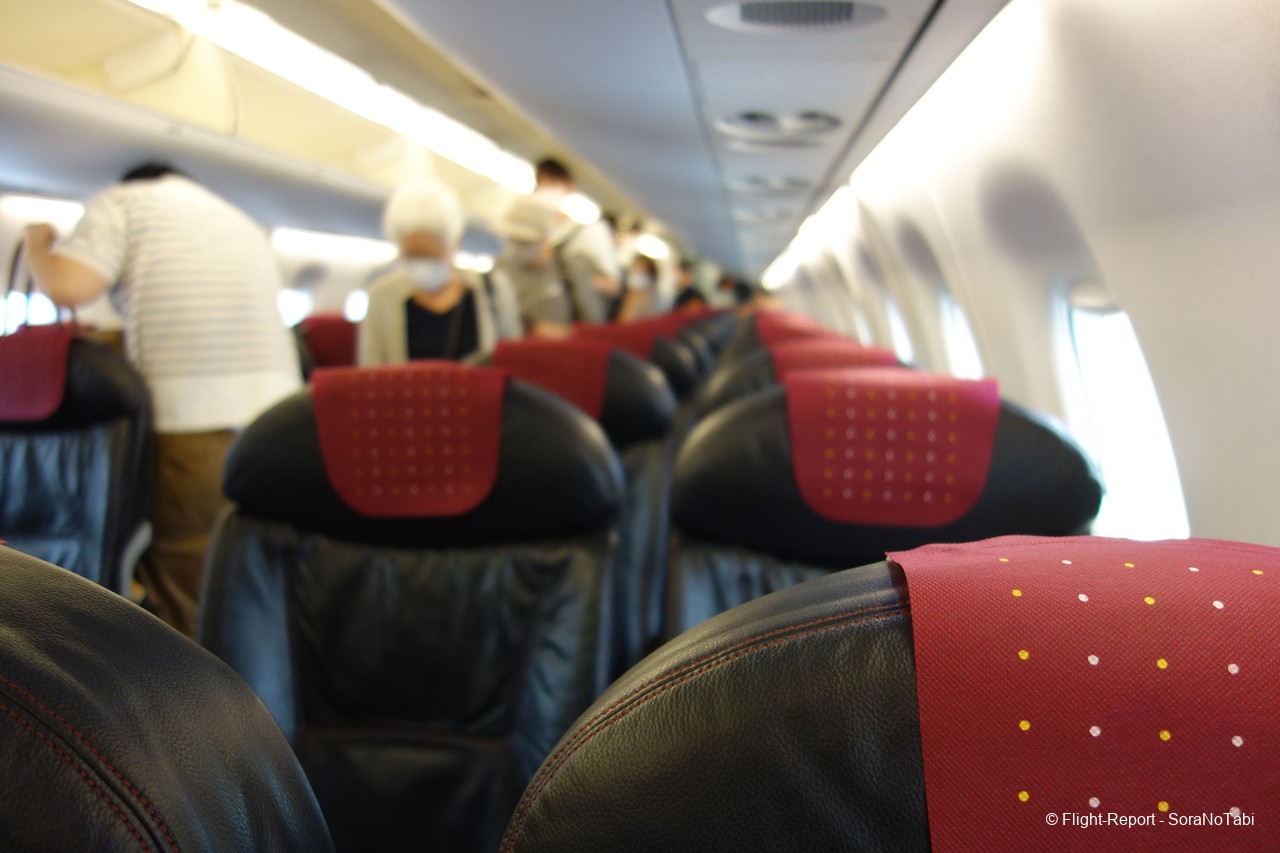
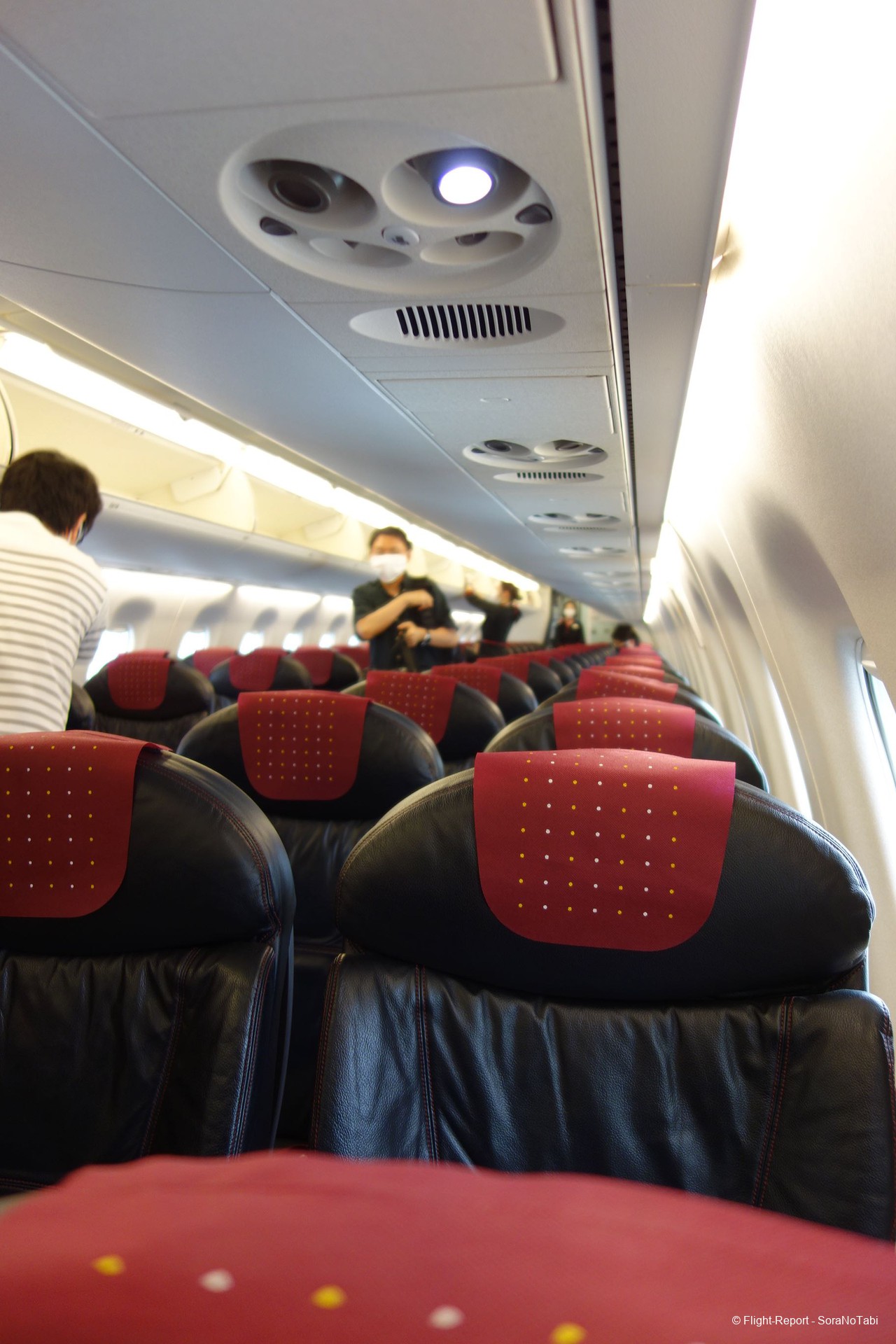

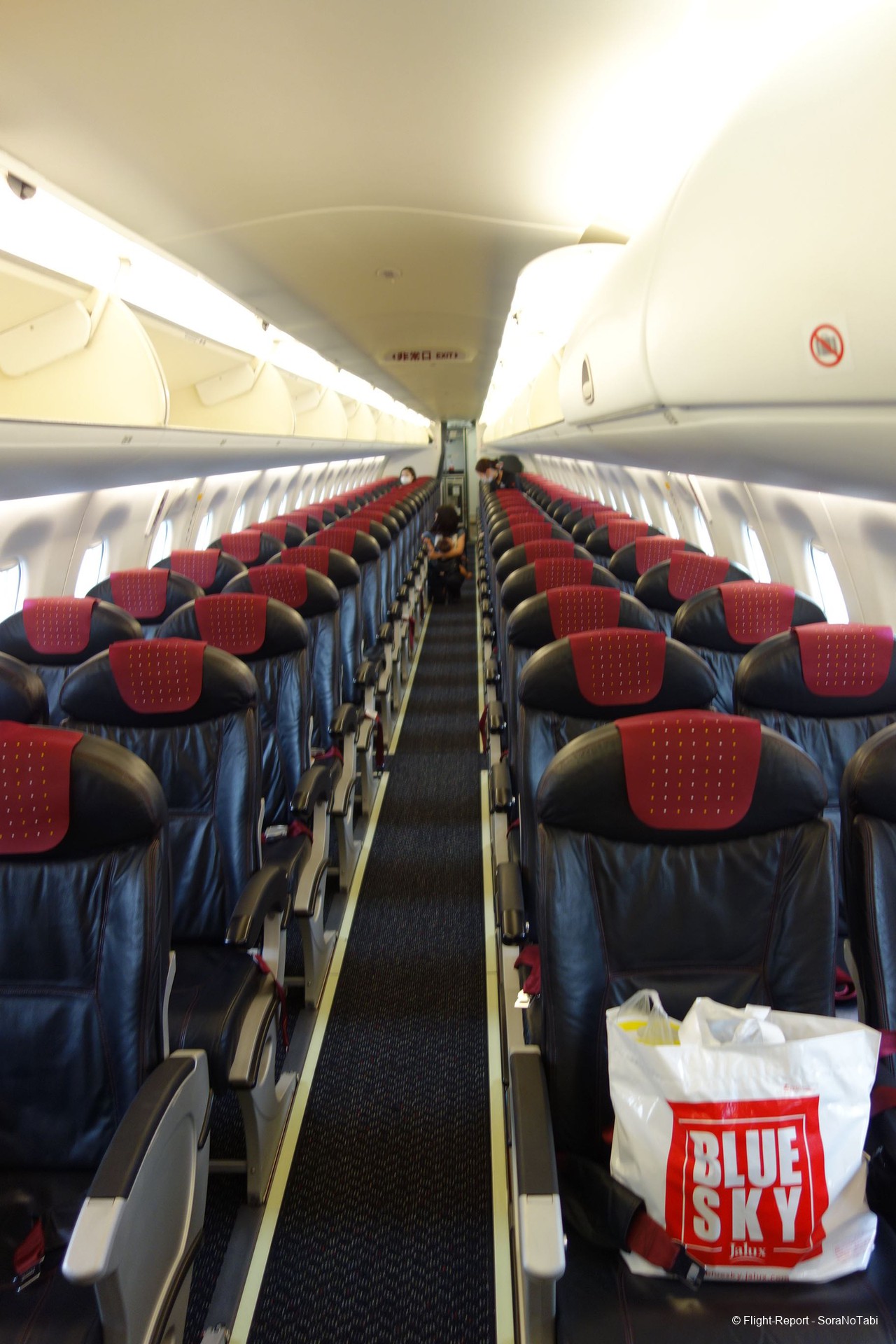
Very saddened to say goodbye to our little aircraft. It was just so charming and welcoming!
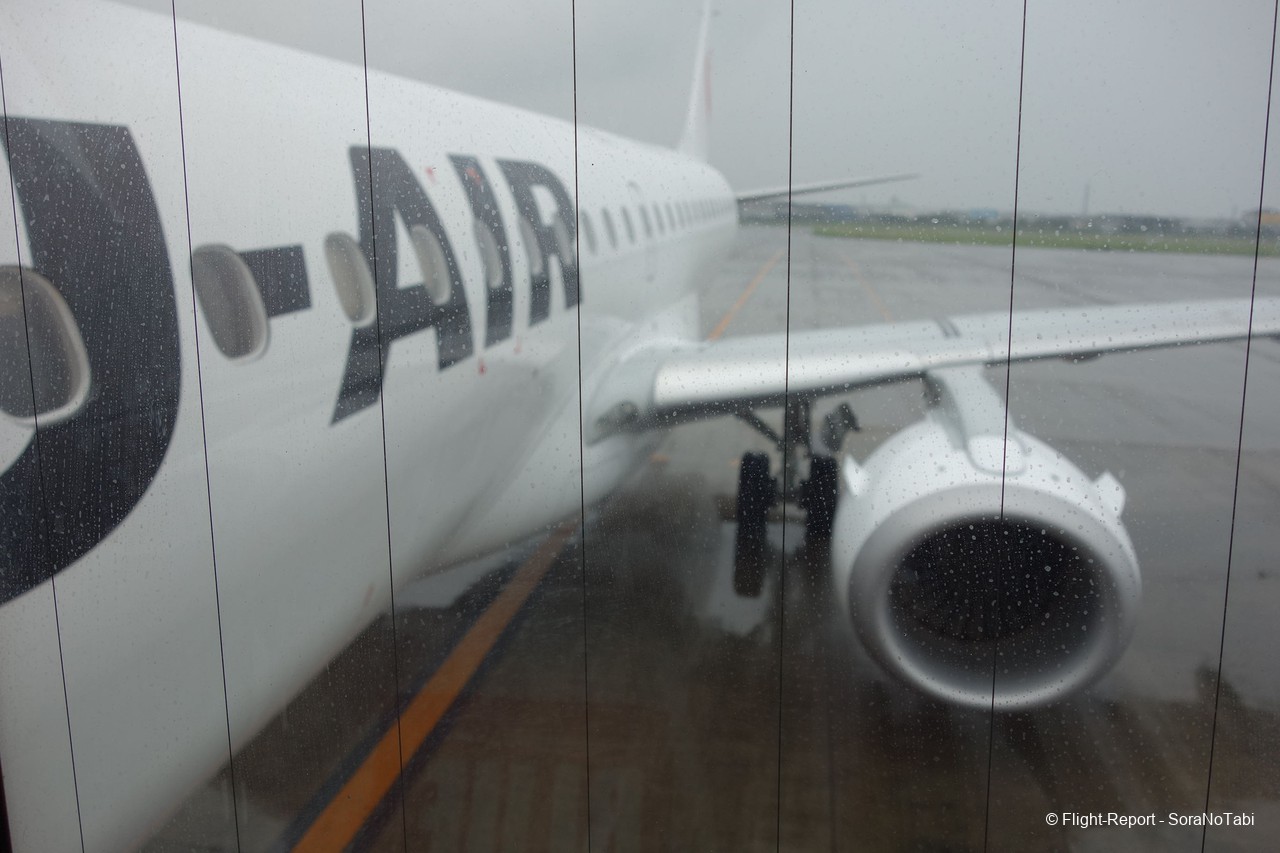
At MYJ advertisements are to be found nowhere (or just about). In my opinion this is a great and subdued way to say welcome.
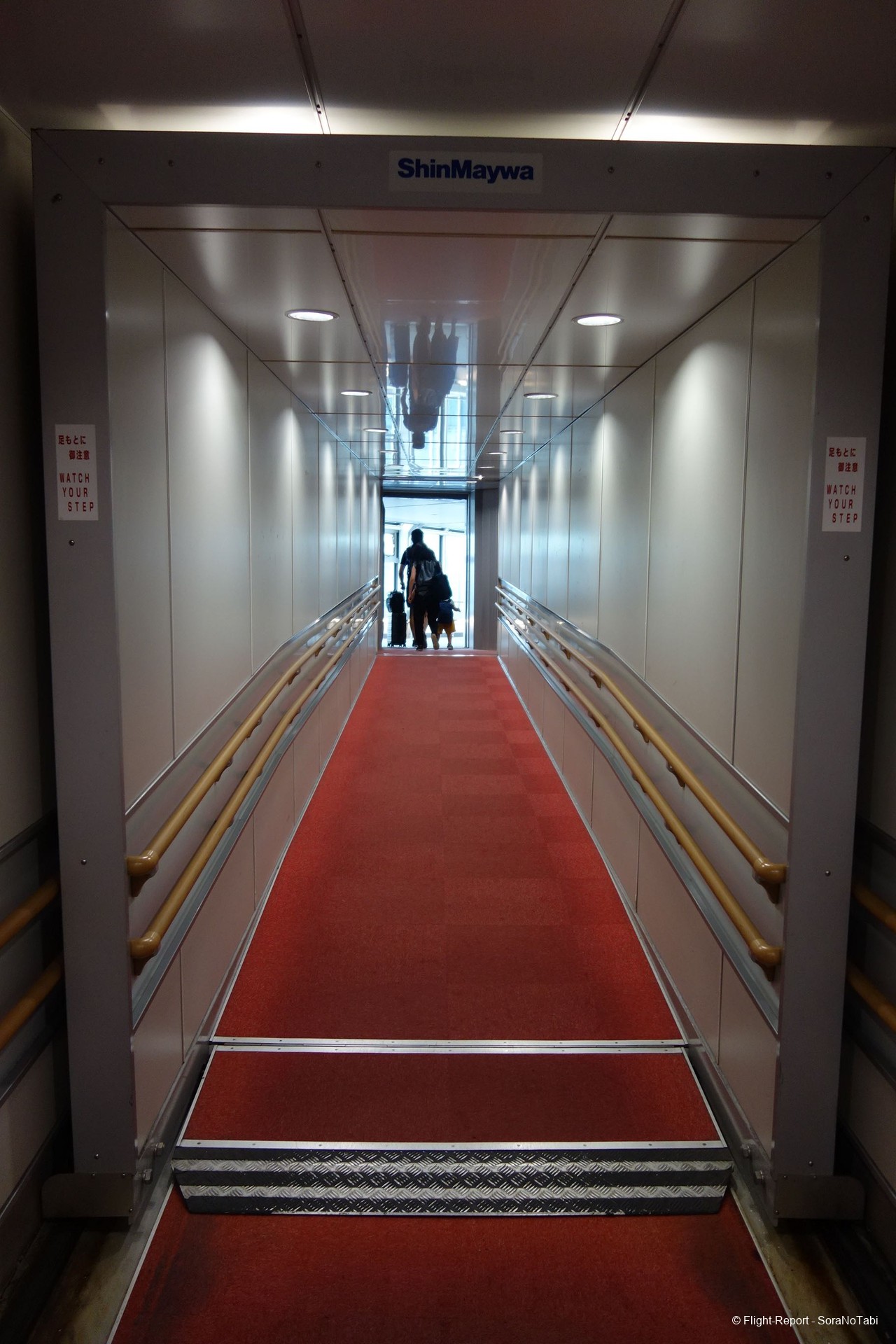
In the picture below greetings are more explicit and printed in different languages. The Japanese version is oriented towards the temporary visitor, at the expense of local residents.
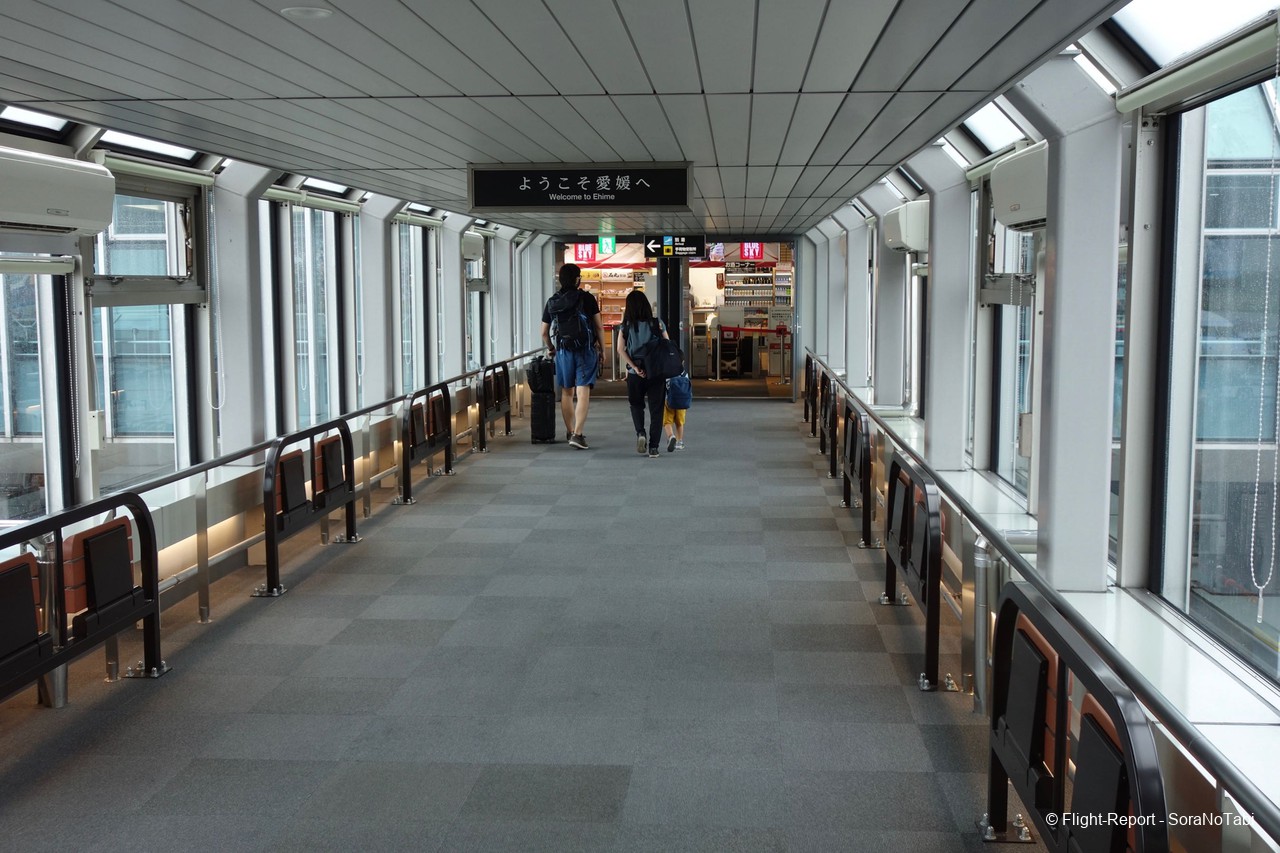
Supplies await to enter the stage. Our bird really deserves to refill energies and satiate its thirst.
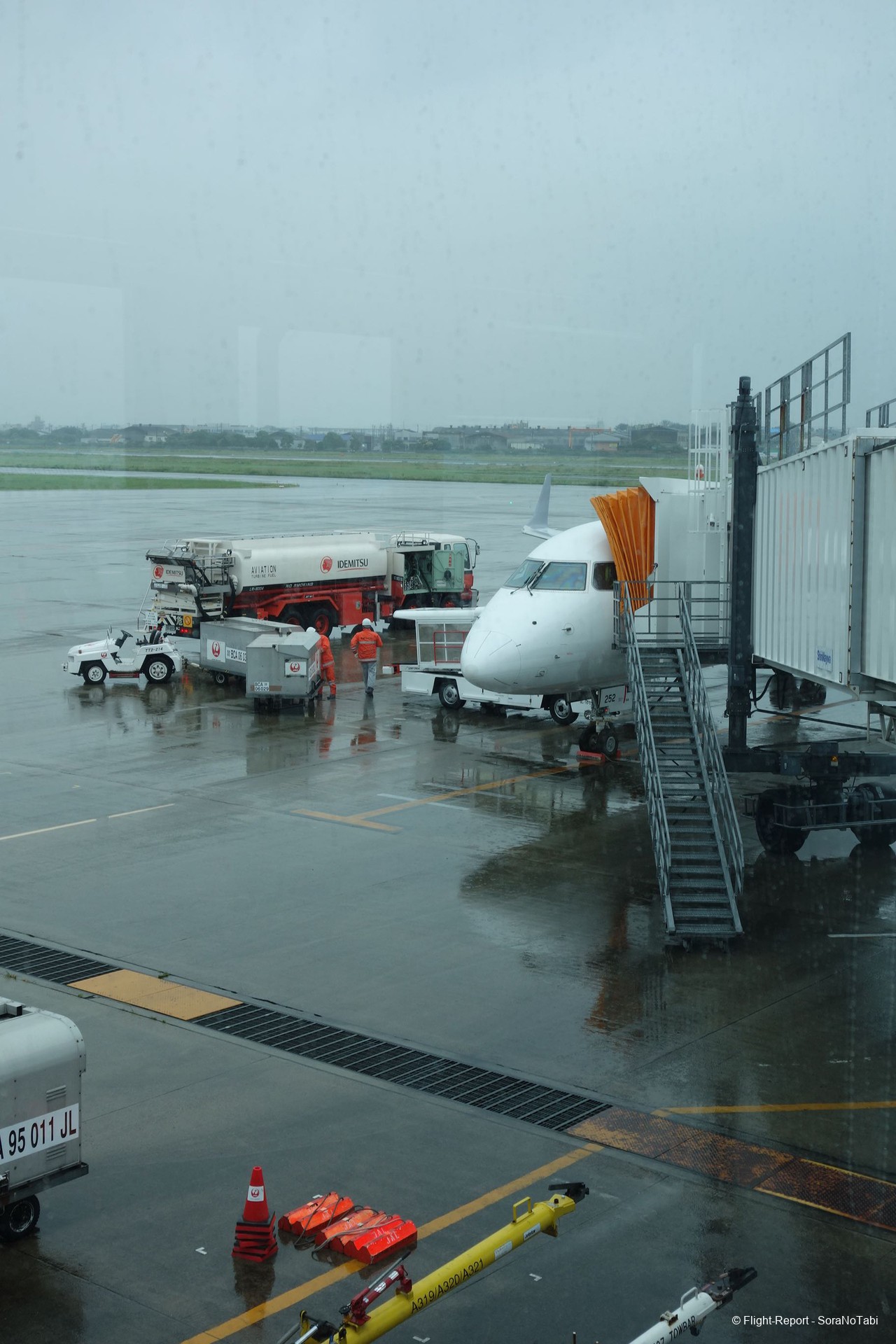
Last view from the arrival hall (which doubles as departure hall).

And first view from the observation deck.
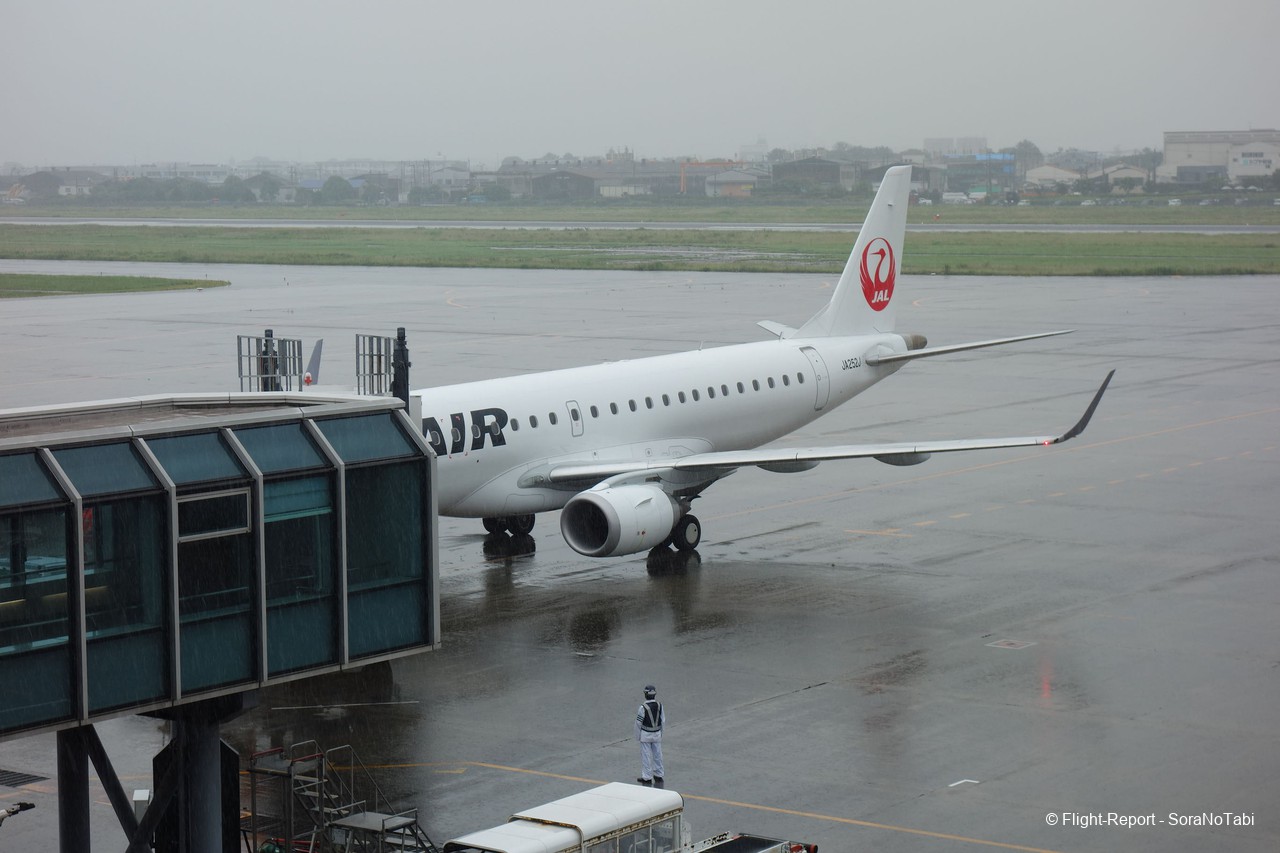
Horrible weather, indeed. Nonetheless, at least for me, this space retains all its charms (I know, I know I am very easily pleased, when it comes to bird gazing….).
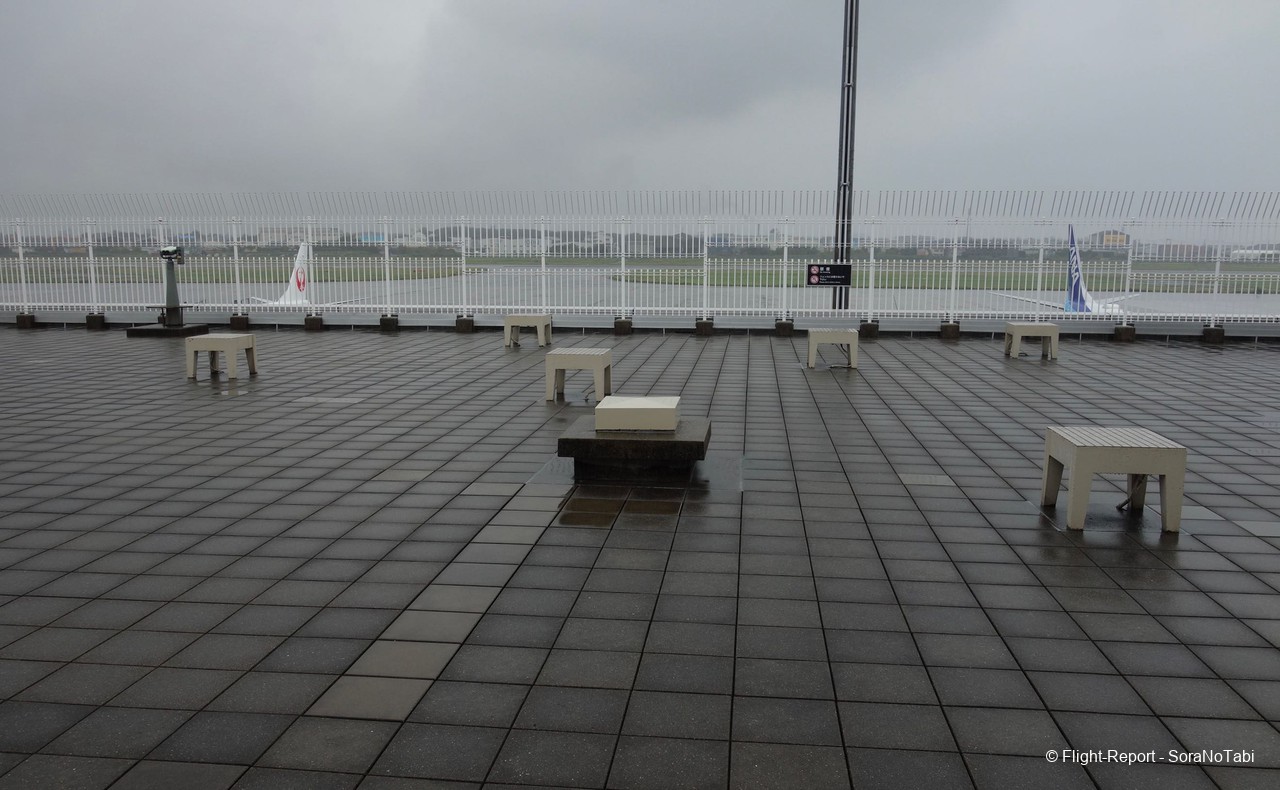
Hard to find a soul around. Quite understandably, in view of the scanty traffic and the bad weather.
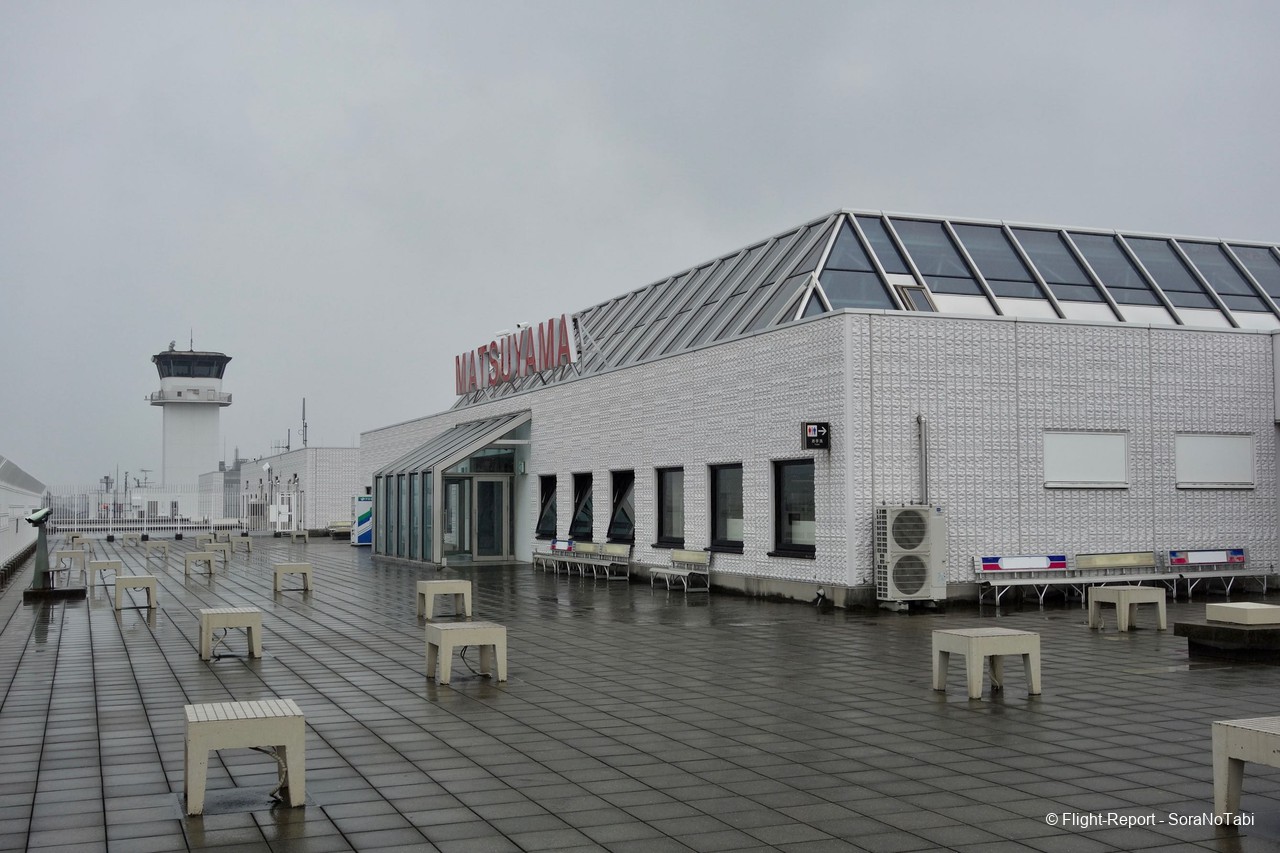
I can't quite quit my travelling companion.


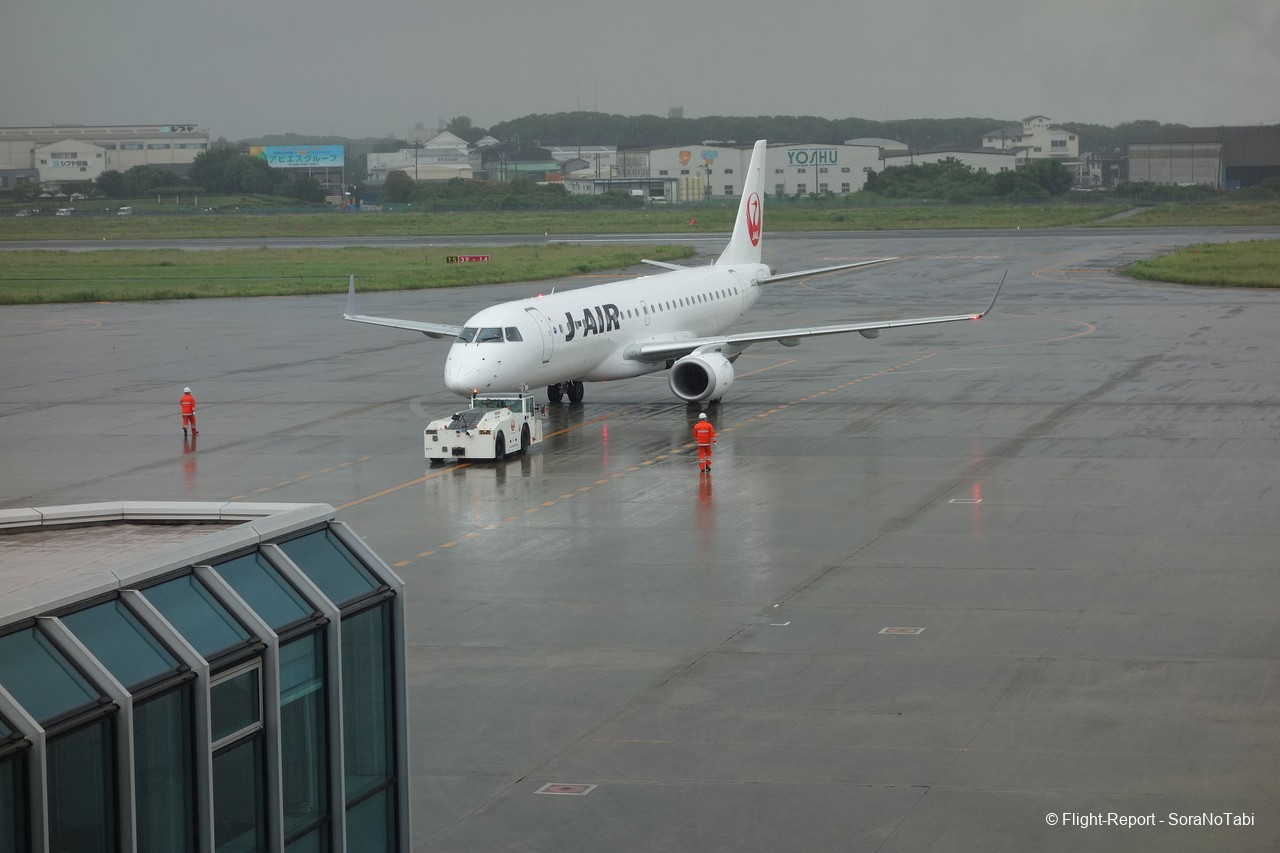
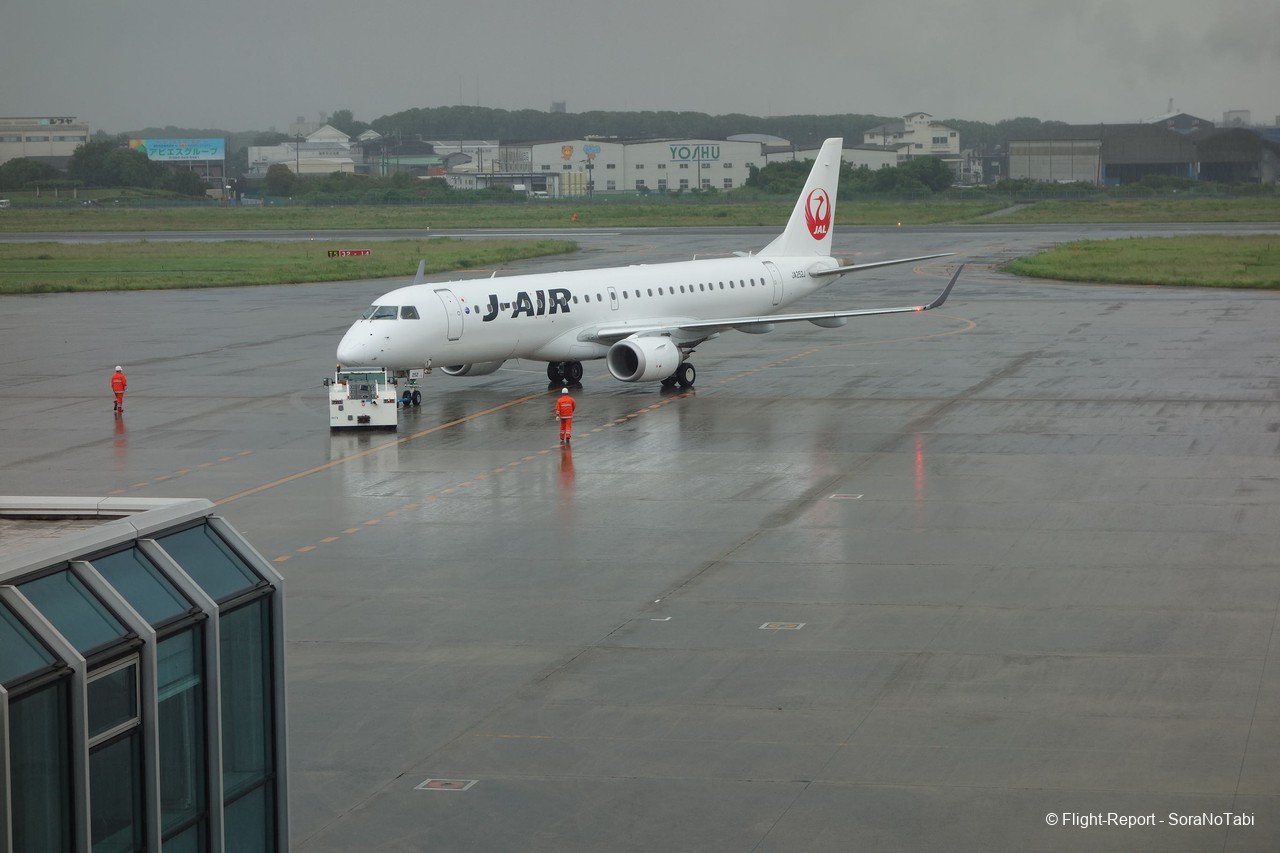
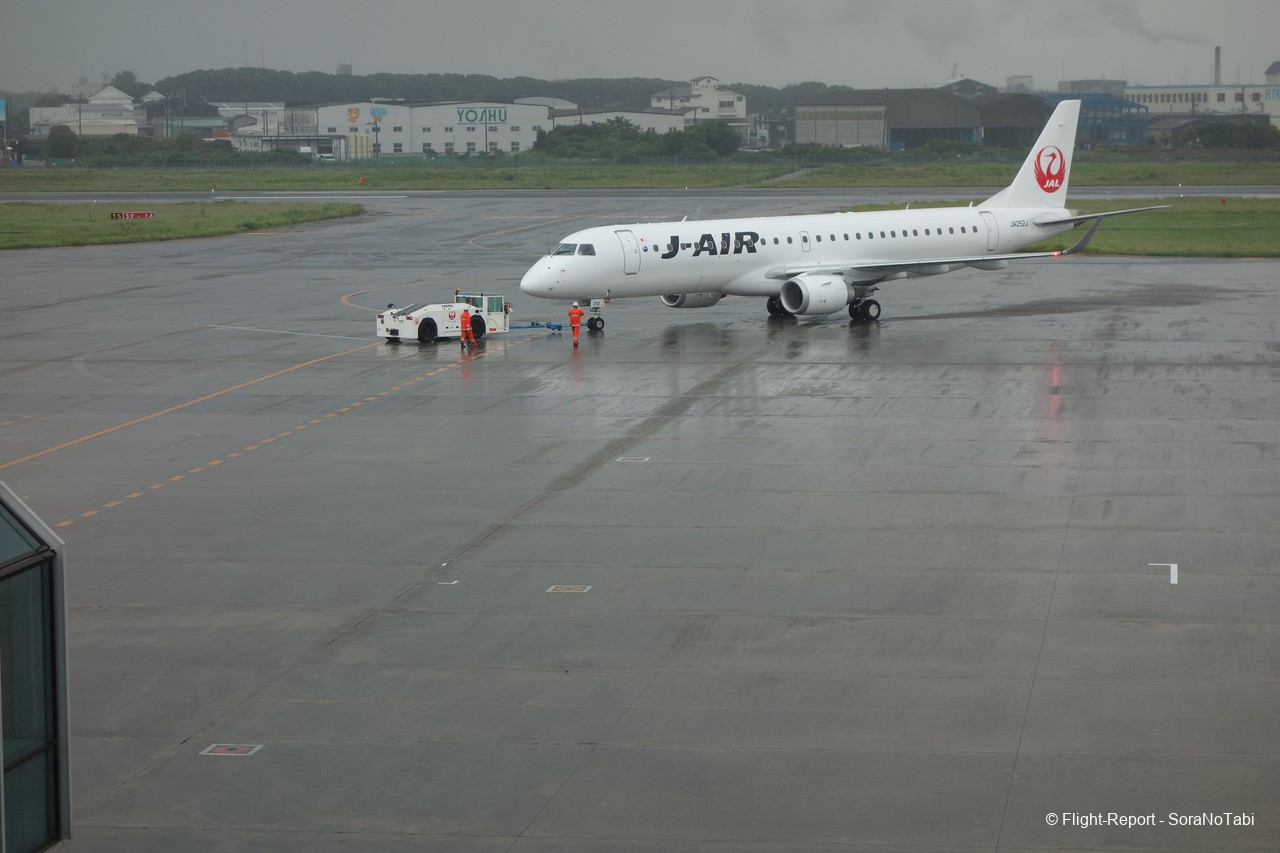
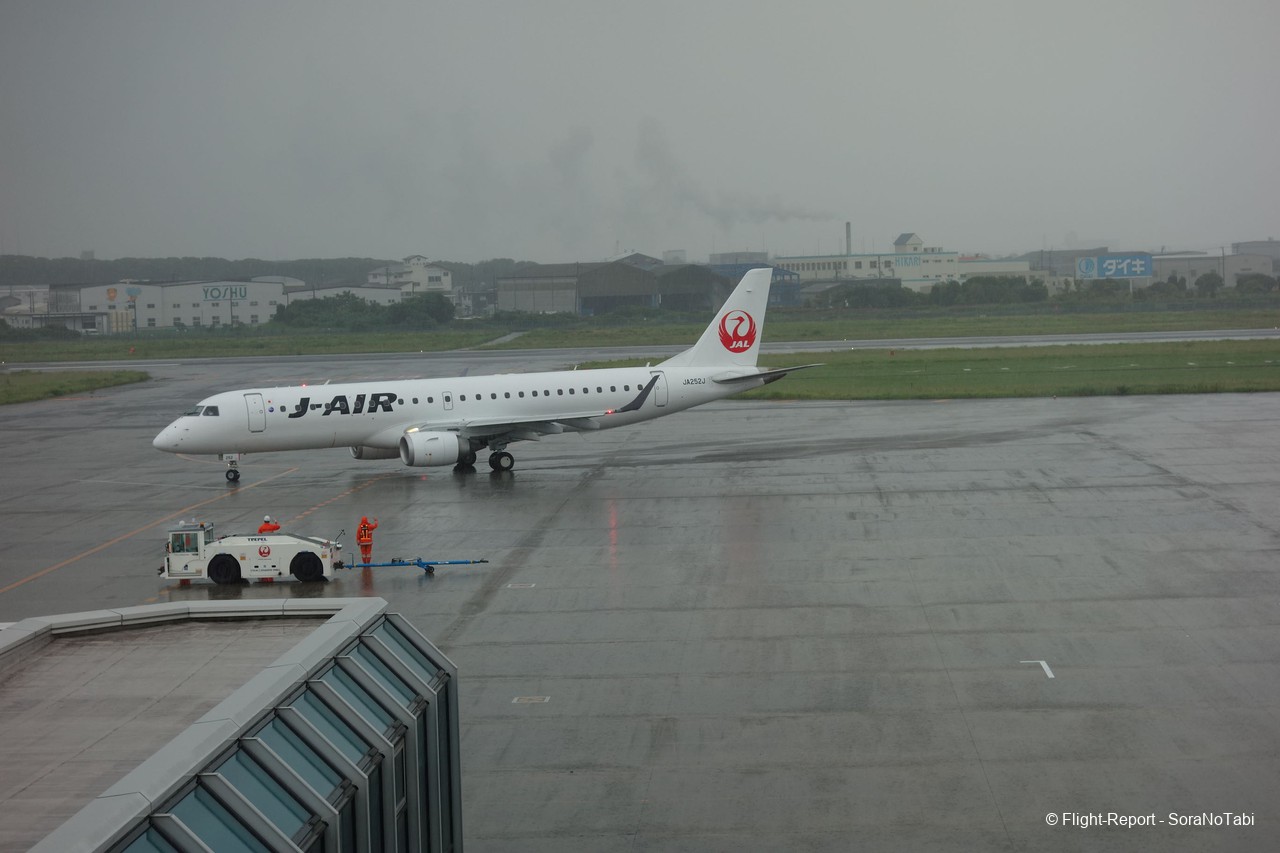
See you soon!

Time to head home. First, a transit bus till the railway station.
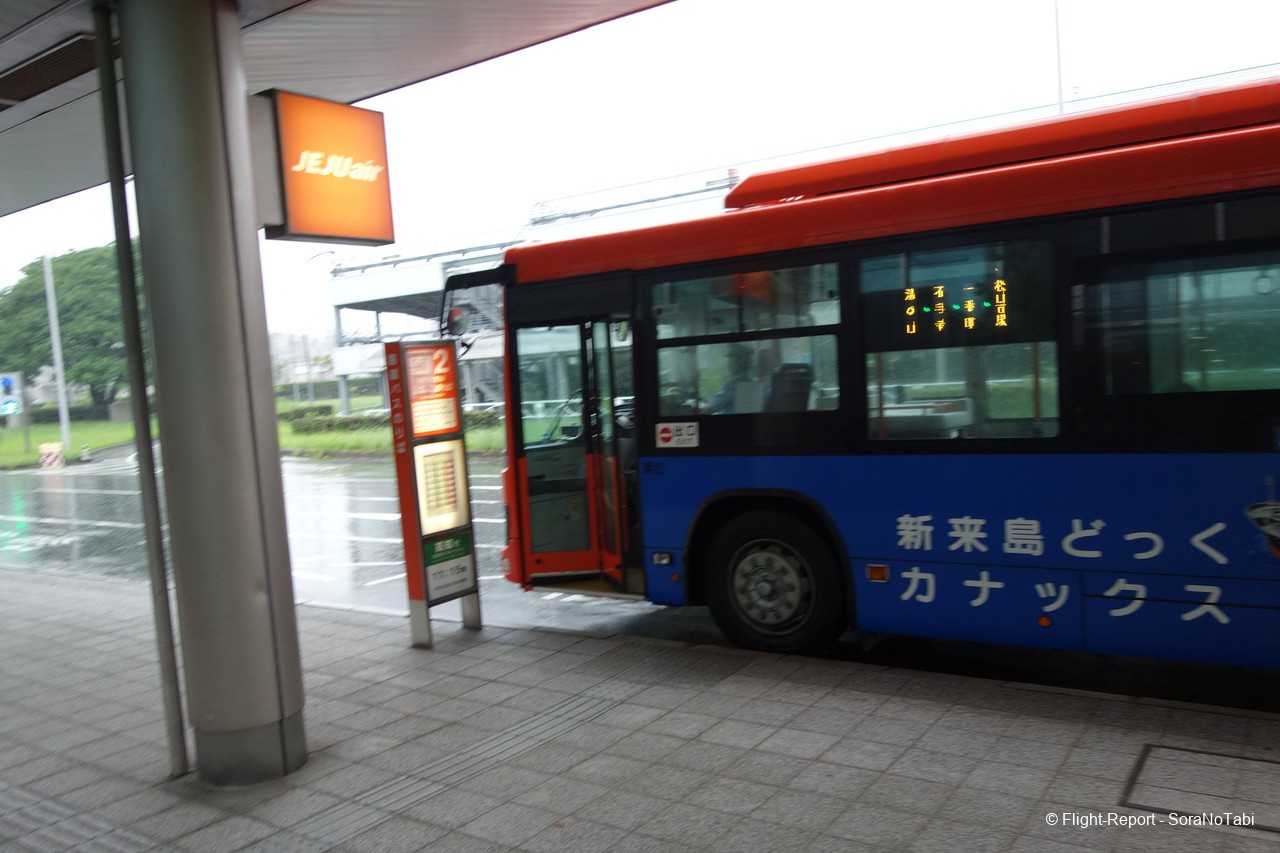
Buses are boarded through the rear door. Alighting must be done through the front one after footing the bill -cash only, onegaishimasu!-. (or by card, but only if you are holder of an elusive transport card, solely valid in Matsuyama city).

Upon arrival to the railway station, we are confronted with a lively discussion (the nature of which we are unable to grasp). Unlike MYJ, the halls of JR Shikoku stations tend to be heavily advertised.

Soon the subject of discussions is revealed to us……. roses!! They will wrap pillars and signboards throughout the station for a week. A festival of sorts.
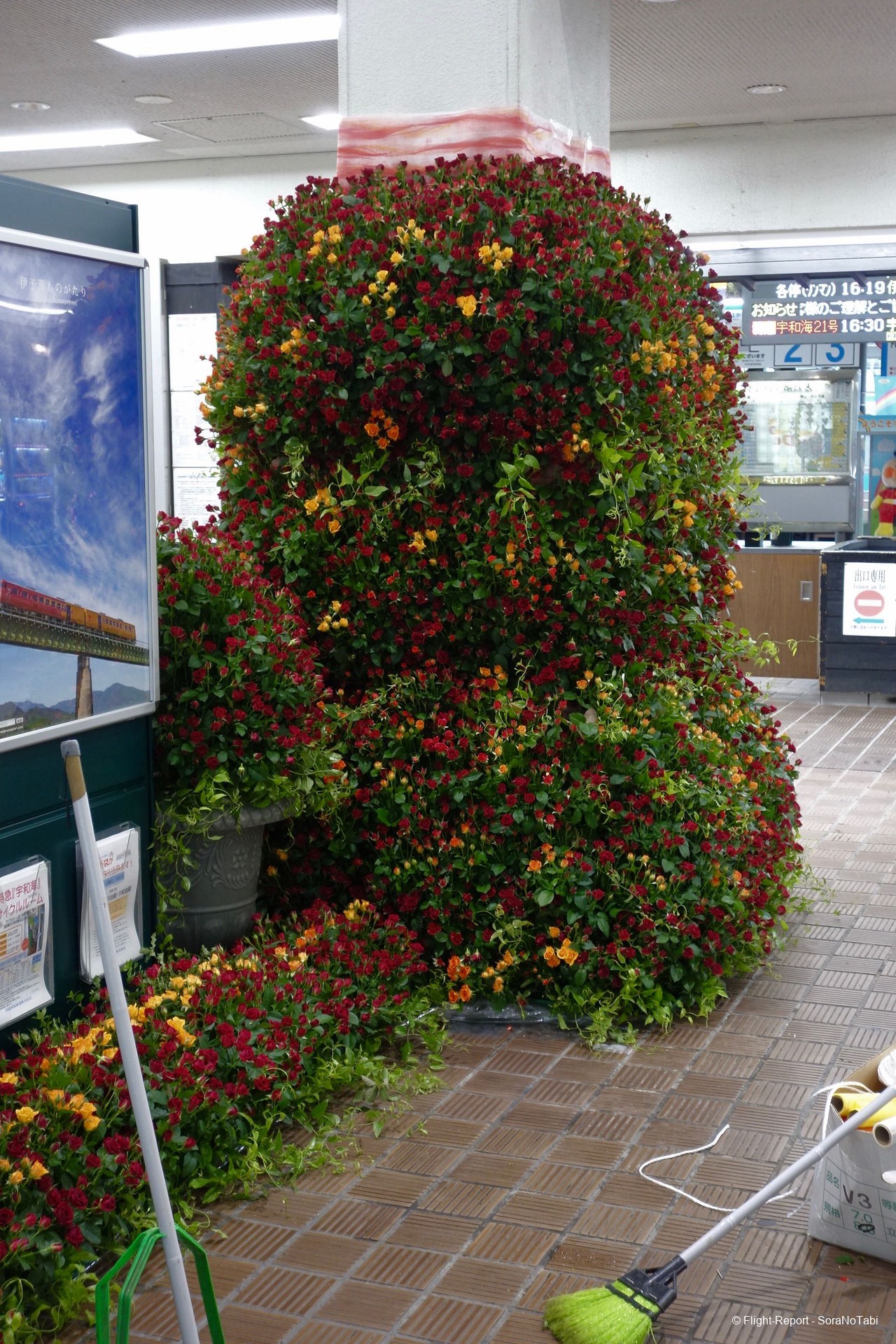
It really brings a feeling of freshness, generating a much nicer atmosphere (I should clarify, perhaps, that JR Matsuyama station is not the most welcoming station in Japan…)
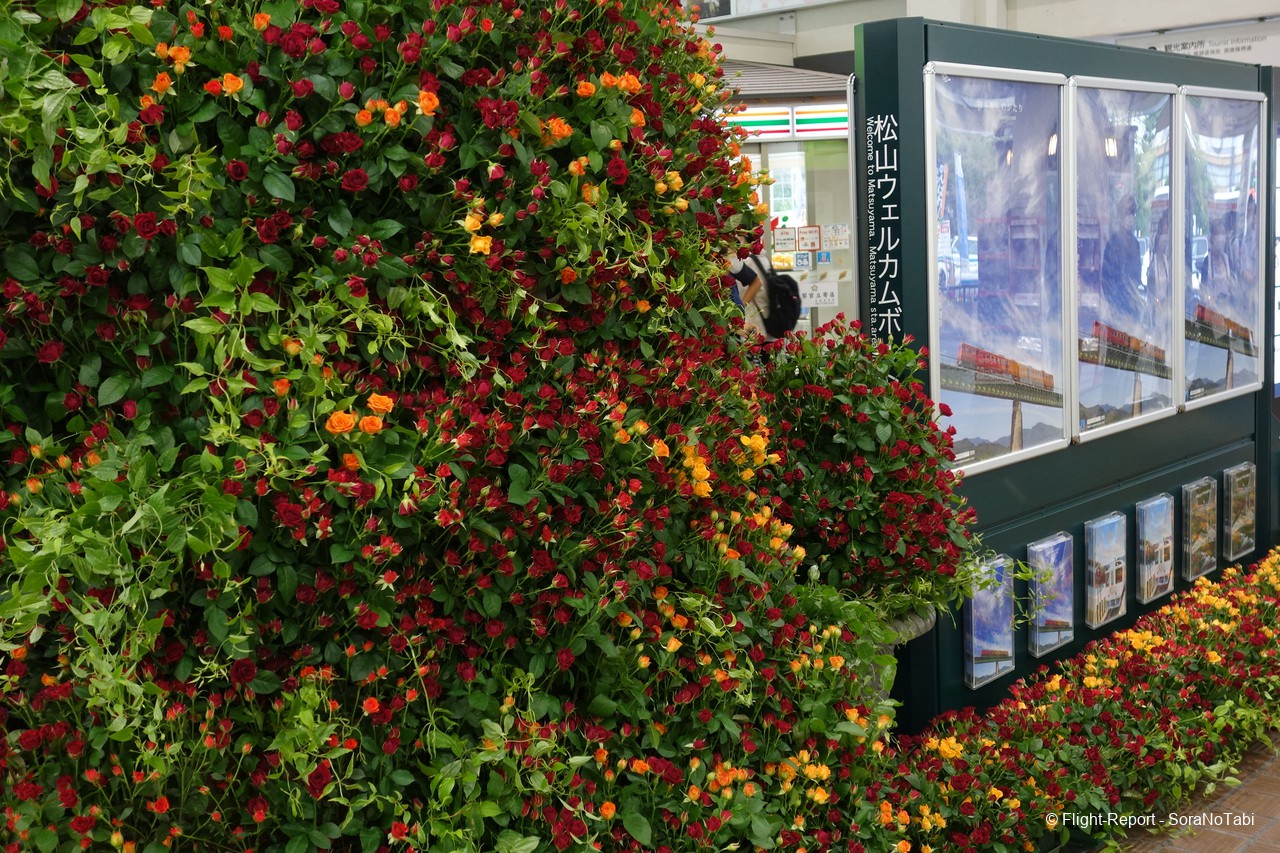
Hajimemashite, I introduce you the whole family of Ehime prefecture’s mascots: on the left Mikkyan the little mandarin princess, below Da-ku Mikkyan her tormentor and on the right Ko Mikkyan, the baby of the trio.
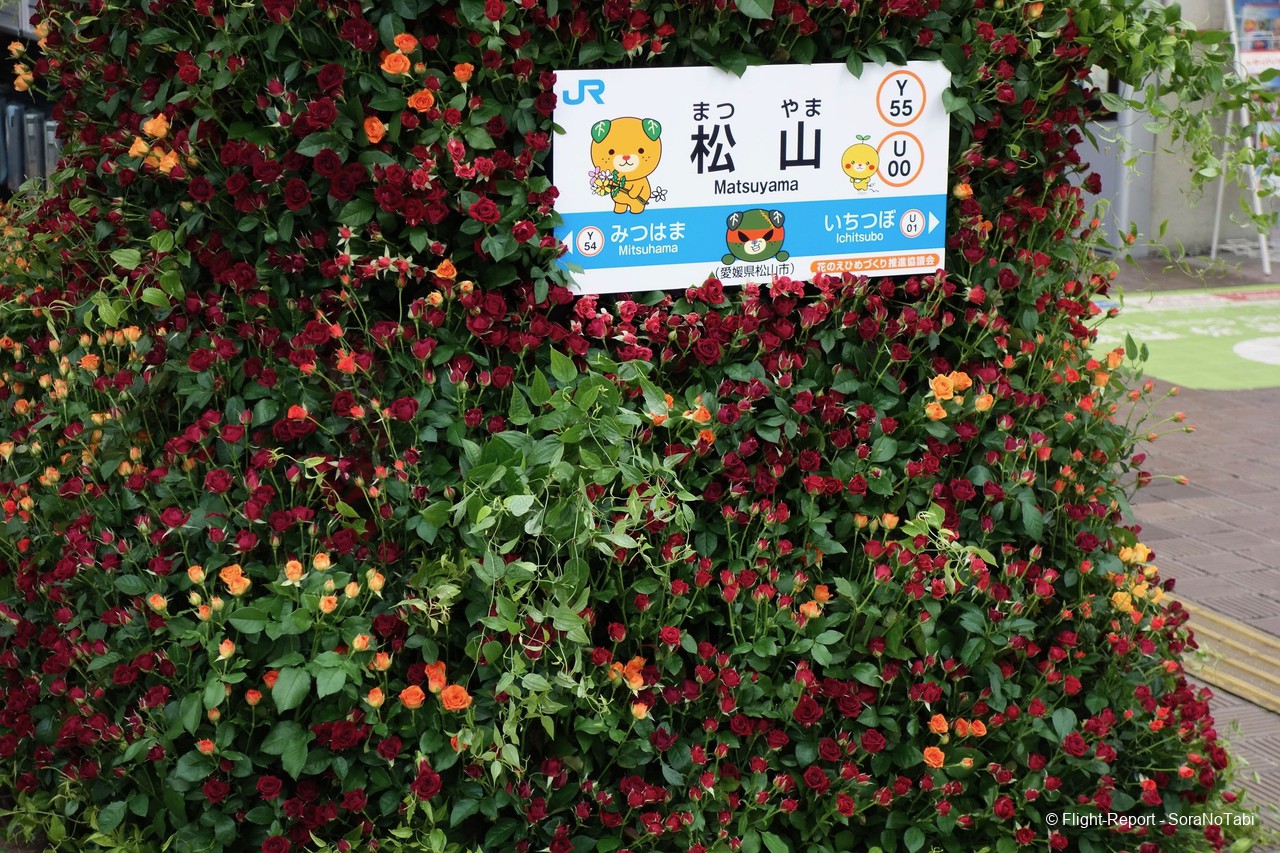
We cross the turnstiles and wait quietly for our train. As you can see, you better make sure you don't miss your train!
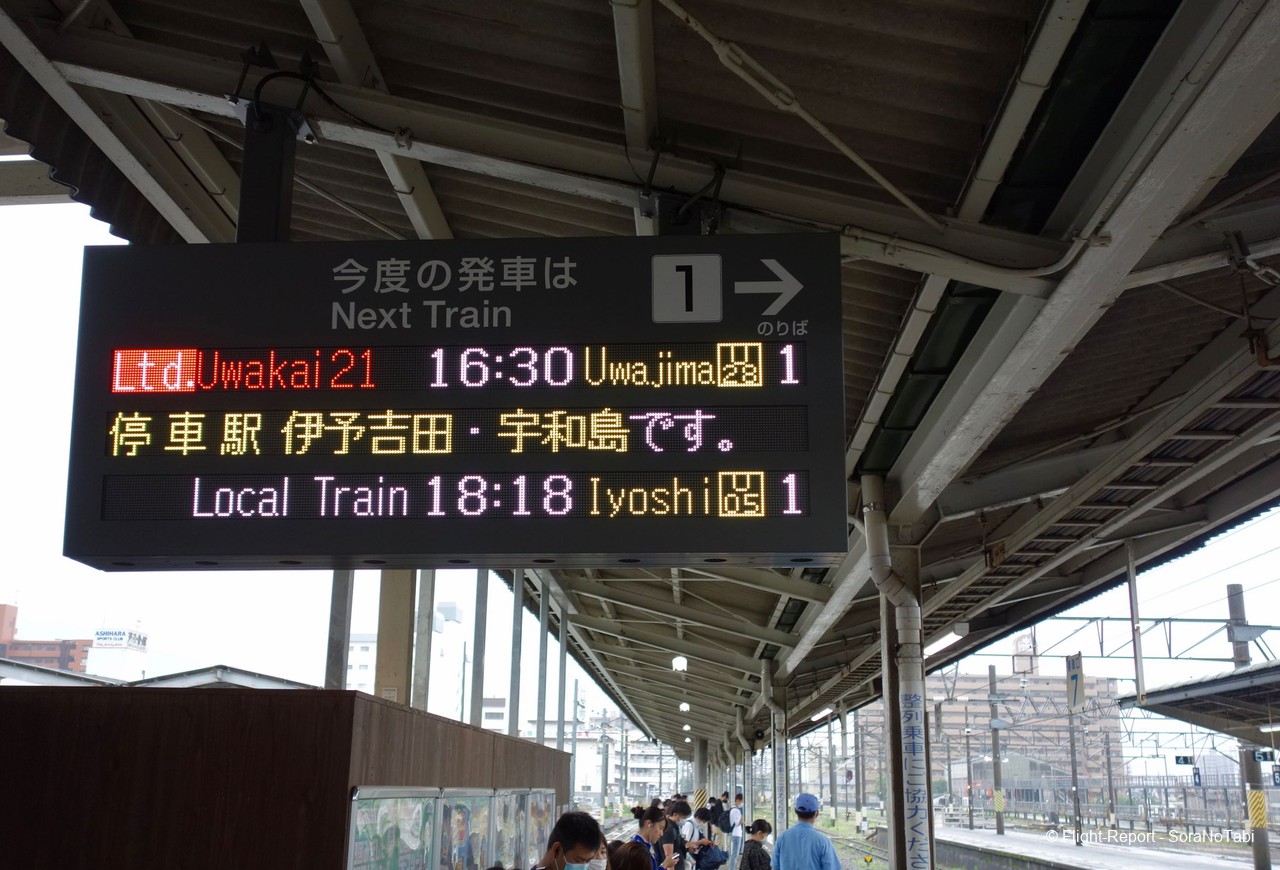
Once settled in, we will spend the next 50 minutes reflecting on the happiness of boarding a plane and discovering remote destinations.
Thank you for having followed today’s tale this far.
And see you soon (be it in the air or in this wonderful site).

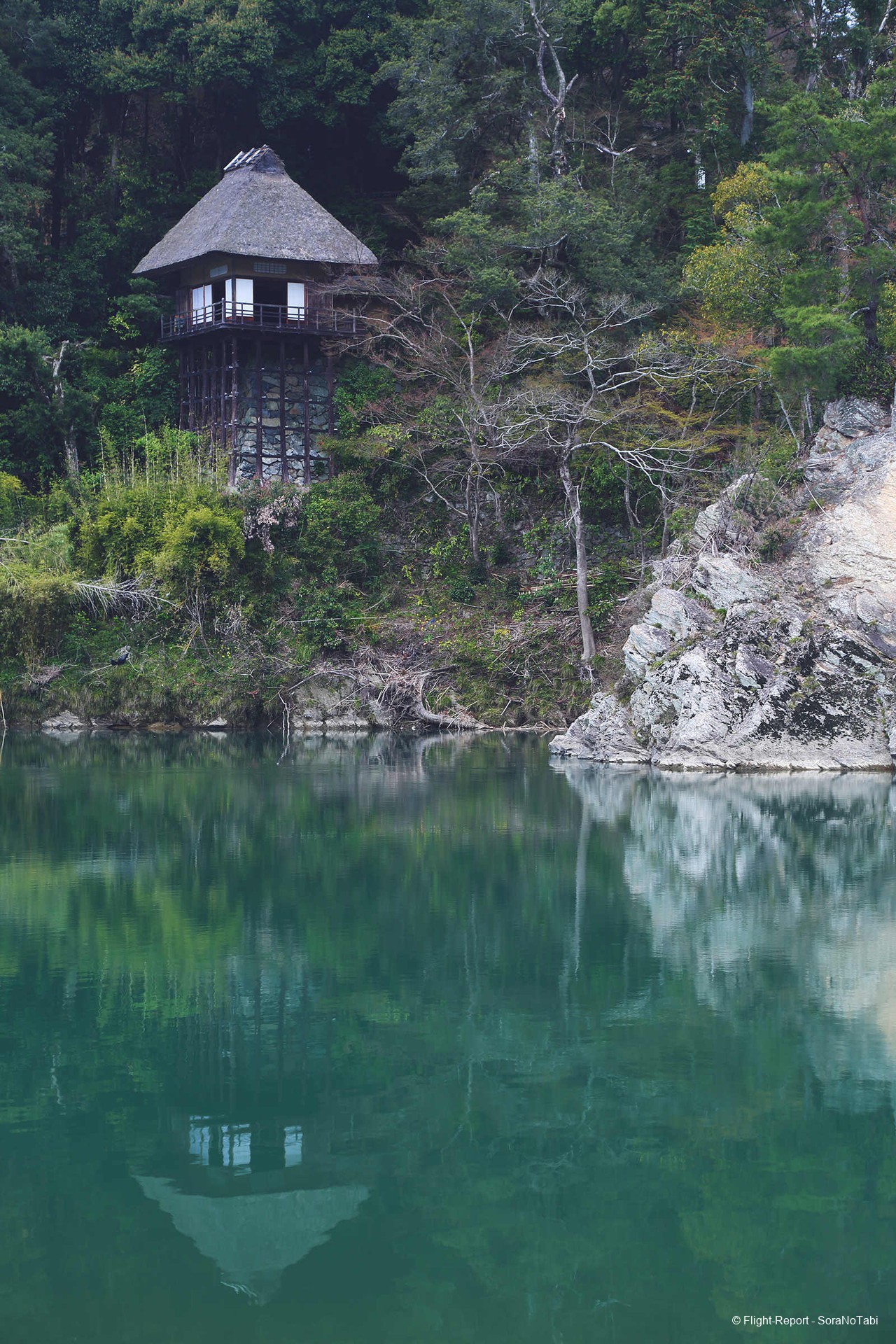
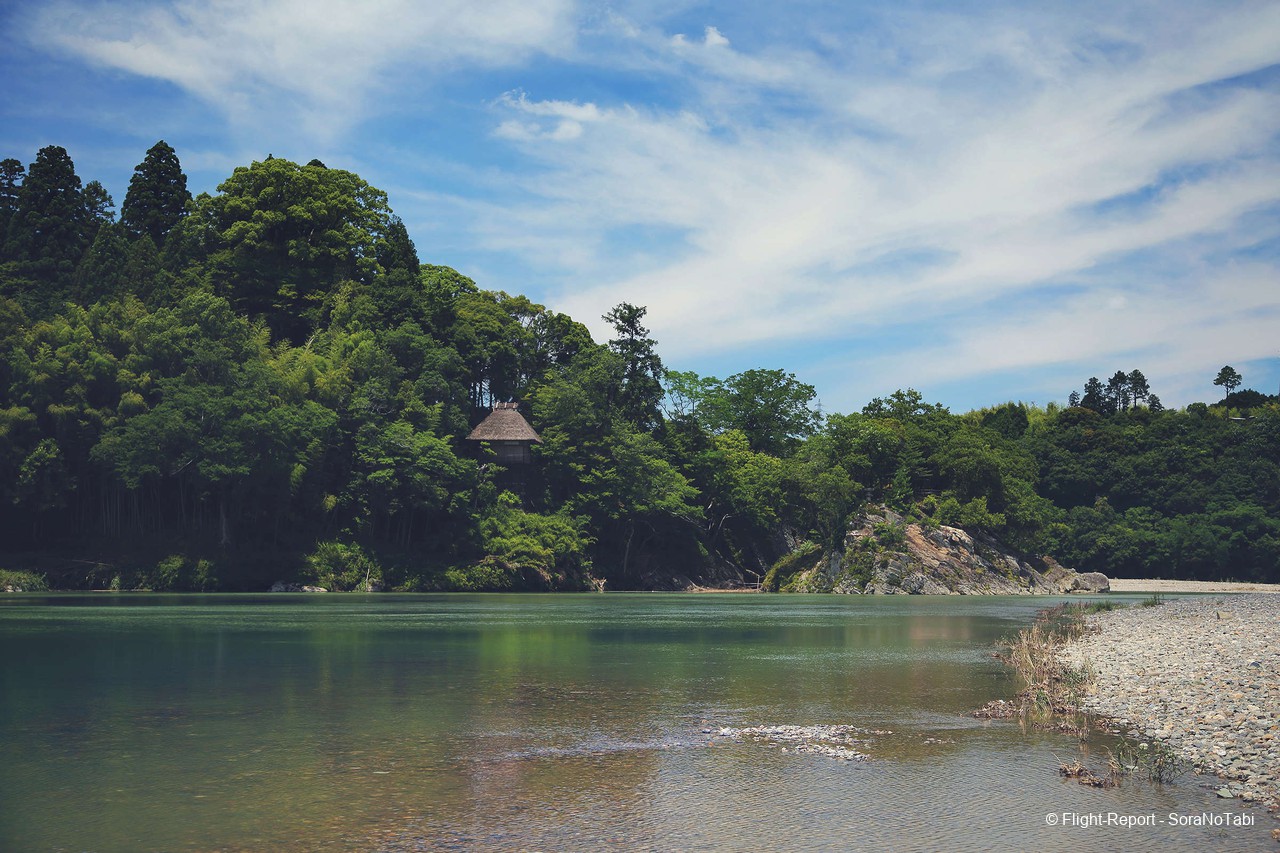
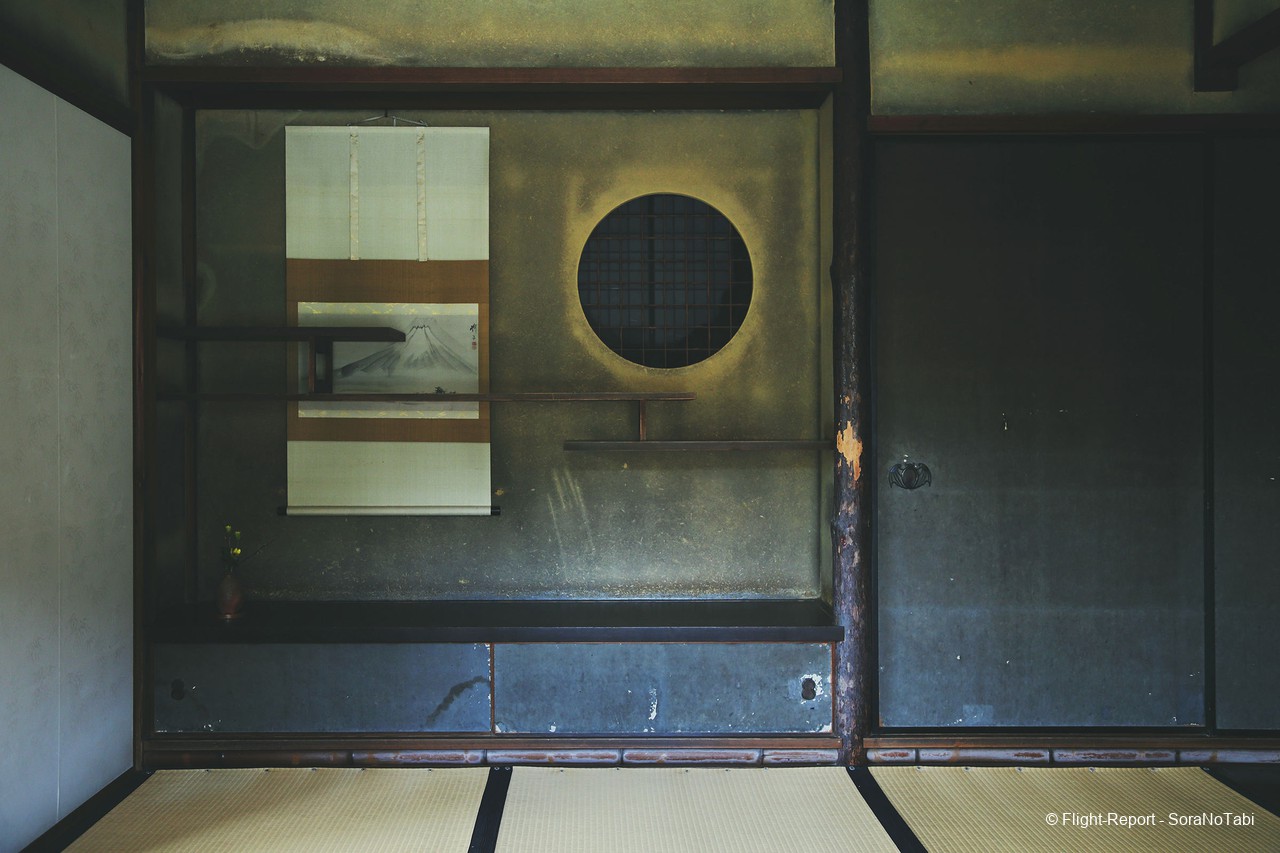
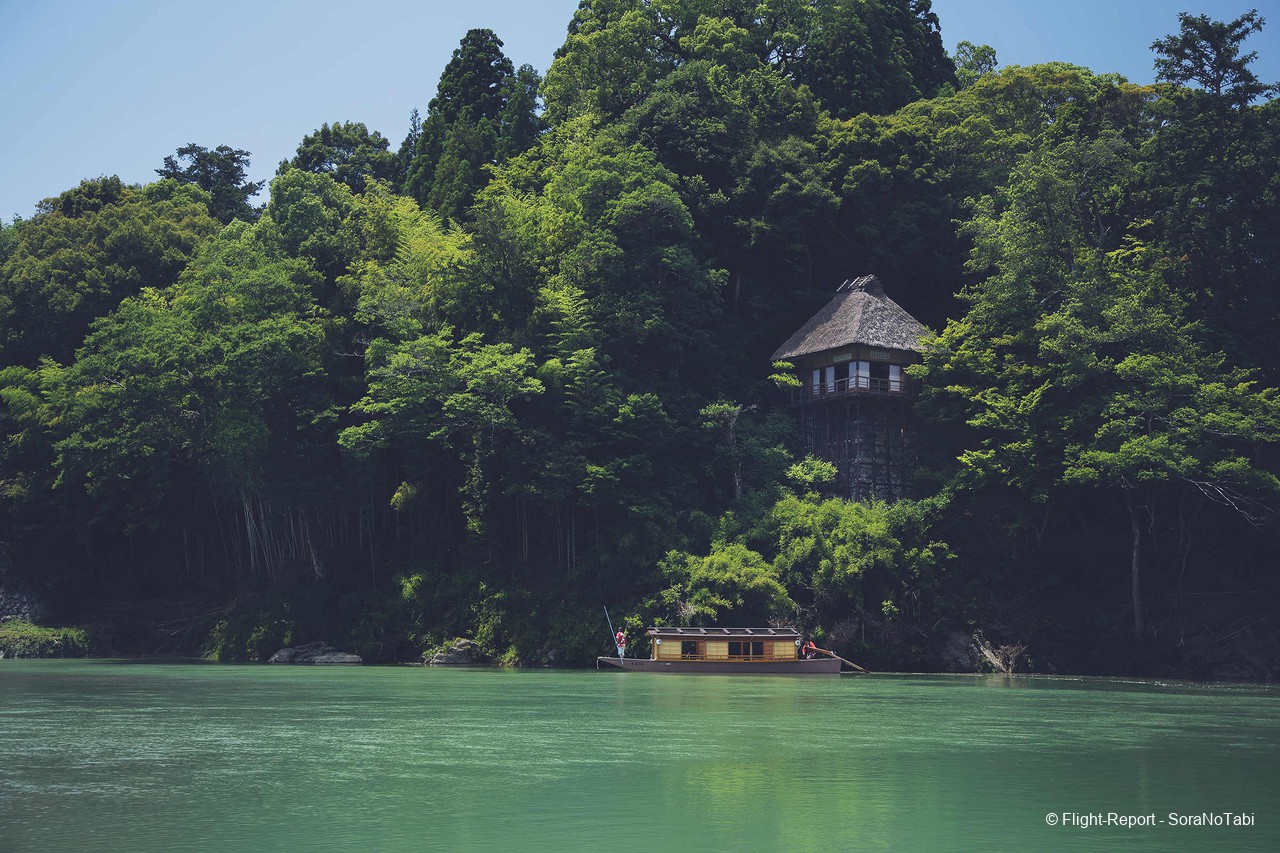
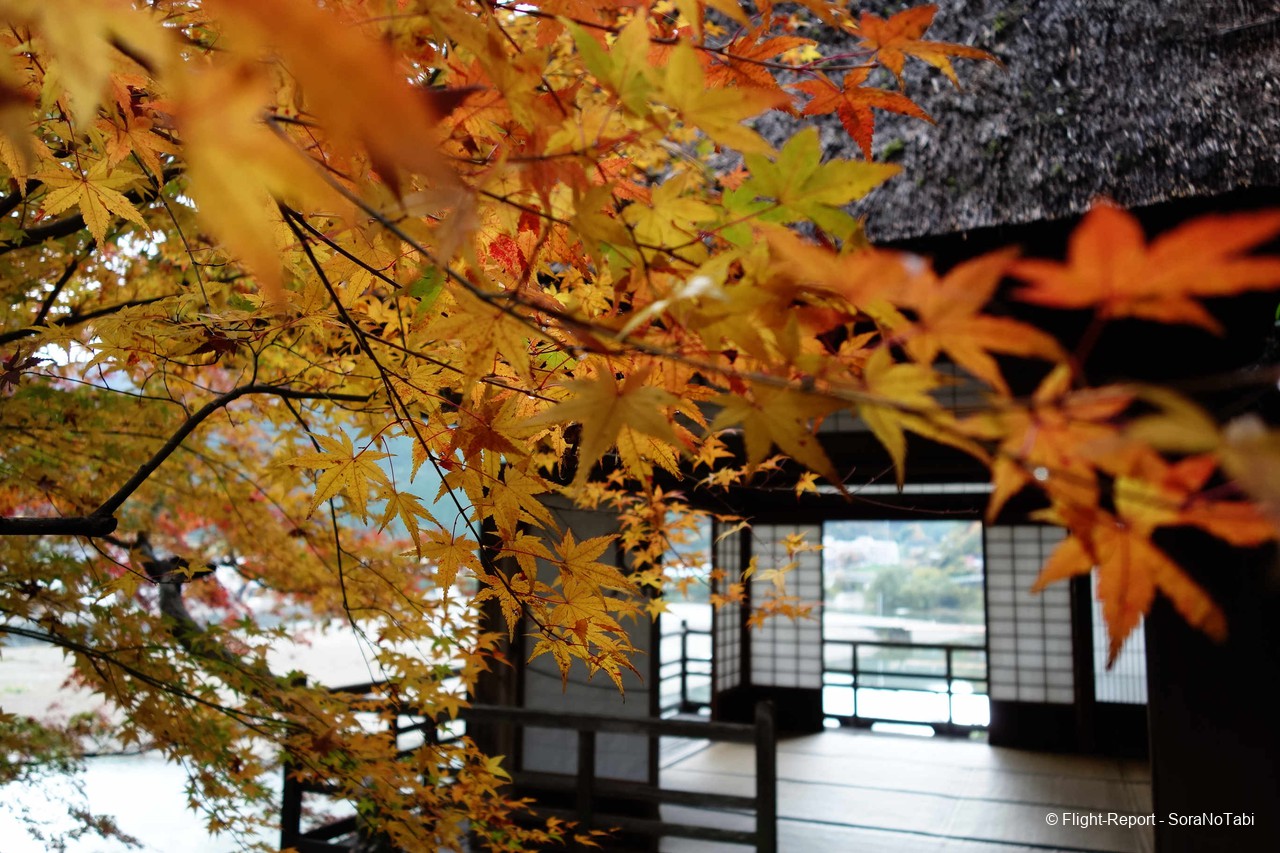

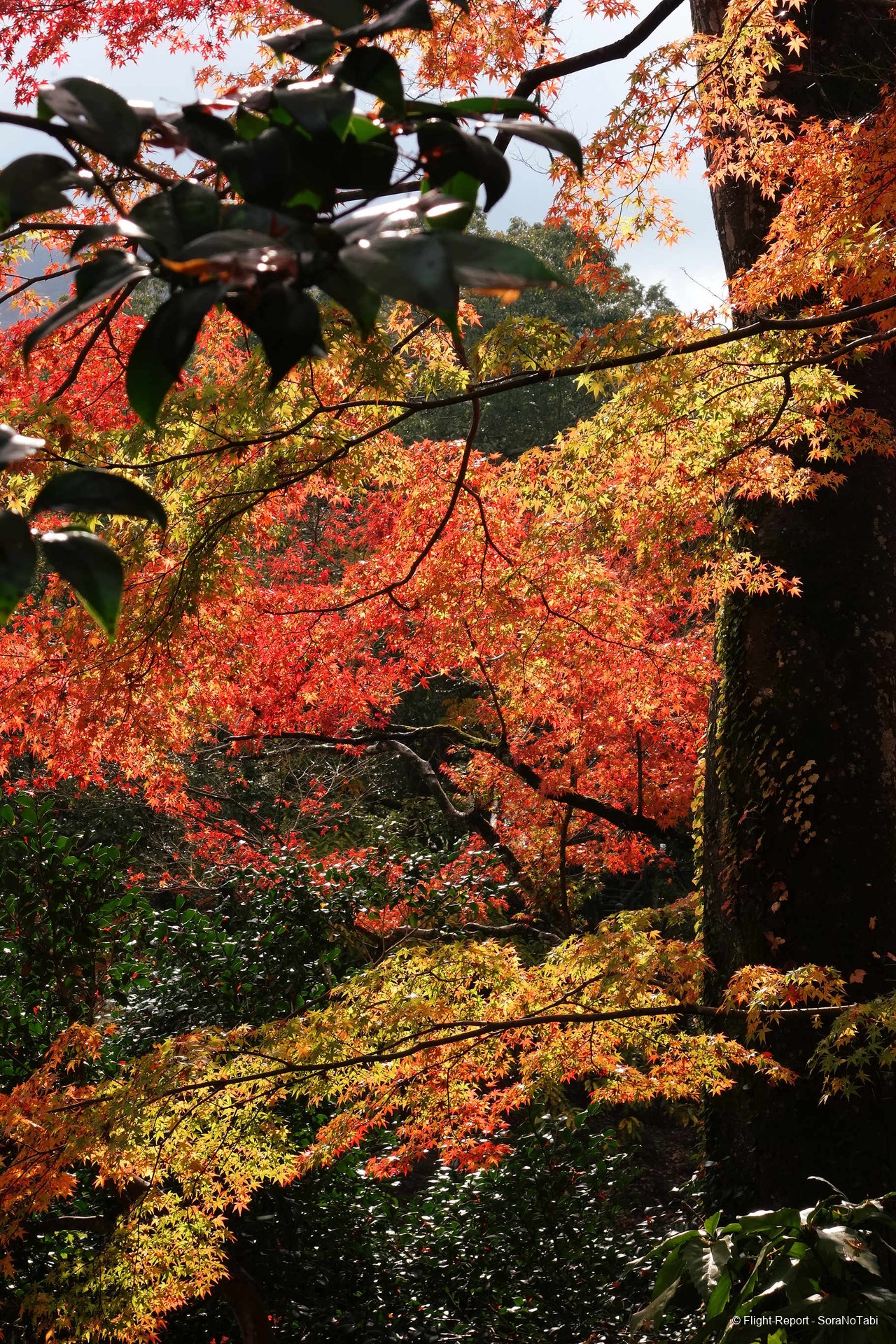
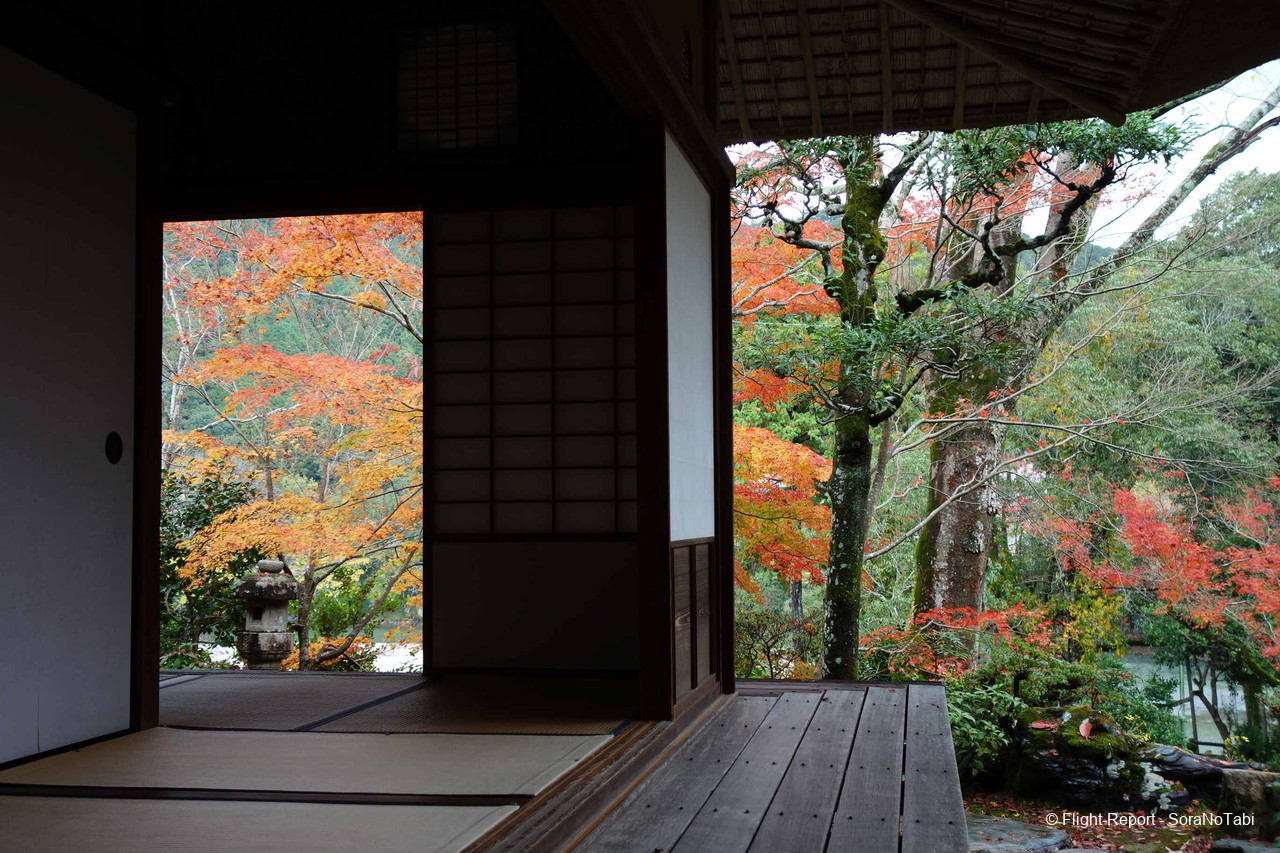

Hi Soranotabi, thanks for sharing this interesting report with us! Domestic flying in Japan looks so civilized haha. You surely did get the best seat in the house! Does it cost extra to book preferred seats in Japan? I love the fact that airlines in Japan are so open with giving the names of the crew members. You definitely won't see that anywhere else in the world! I also loved the pictures from your departure - makes me miss Tokyo ? Thanks again for sharing... Take care! ✈️
Hi there! And many thanks for your comments! JAL tickets are more expensive that those of domestic LCC companies but they come with all the perks included. That means you can reserve your seat right after your purchase. Without extra cost. (I am not an expert on this, but according to your OW status you may find more -or less- seats open for reservation). This time I was assigned the seat by the system, due to the last-minute aircraft swap. I could say I won that day's lottery ;-)
Hi Soranotabi, thanks so much for sharing your first report in English, and a beautifully written report it is! I always enjoy seeing domestic Japanese reports as those can be quite exotic these days. Nice to see J-air continue to have good service on these short flights during the pandemic. E-Jets are comfortable aircraft with such wide cabins in a 2-2 configuration and these older plusher seats are much more comfortable than new slimline seats—when configured at a decent pitch anyway.
Nice bonus photos. We often think of Japan as being most beautiful in the spring during Sakura season, but fall seems equally breathtaking.
Thanks again for sharing and I look forward to more of your reports in the future!
Hi Kevin!
Thanks for your encouraging comments!
JAL saw drastic changes in their inflight experience during the first months of the pandemic (middle seats blocked, very limited drinks offerings and curtailed contact with cabin crew). Nonetheless, during the course of the summer (2020), service gradually regained something akin to what was previously offered.
Autumns are truly beautiful in Japan. Personally, I would not hesitate to choose fall, if I had to pick a season to come here. Rice harvest, colours, mild weather, moderate rainfall...